https://www.blackgate.com/
A Boy and His Dog: How Archaeology is My Biggest Inspiration
 Image by Siggy Nowak from Pixabay. This looks like a Stargate. Where’s the dial?
Image by Siggy Nowak from Pixabay. This looks like a Stargate. Where’s the dial?
Good afterevenmorn, Readers!
Once upon a time, a much younger me fell into an obsession… Well, several related obsessions, if I’m being honest. Prehistoric Anthropology and Archaeology dug its claws into my brain and would not let go. In what might have been a profound waste of money, I followed that obsession into university, acquiring a Bachelor’s Honours Degree in the subject, with a focus on Celtic Studies. I wrote a thesis that was four times as long as it needed to be (with permission). I wrote on the Continuity of Religious Iconography From the Upper Palaeolithic to the Pre-Roman Iron Age of the Atlantic Façade. Which is to say, basically, some religious beliefs and practices of the Iron Age Celts might just have had their origin in the pre-Celtic peoples of the Stone Age. That’s a lot to cover in just twenty pages, so I handed in eighty-three.
When I say I was/am obsessed, I absolutely meant it.
 Image by WikiImages from Pixabay
Image by WikiImages from Pixabay
I had wanted to follow that obsession even further in a Master’s Degree and then onto a Doctorate, but I had no money, and was far too scared of my already accrued debt to willingly go further. As such, I’m not really working in my field of study. In fact, I’m nowhere near it. My day job is working as an accounting clerk. But that doesn’t mean I haven’t used my degree. I have. Sort of.
You can find me still pouring over news from the prehistoric anthropology and archaeology world. The information sits in my head and ferments, becoming part of the fabric of my imagination. Every so often, that information pops out in the form of a fictional story. Sometimes, there are things that are discovered after a story is written and out in the world that reflect the stories so very well. Let’s explore!
 Image by Joshua Choate from Pixabay
A Child and Their Dog
Image by Joshua Choate from Pixabay
A Child and Their Dog
In 1994, Jean-Marie Chauvet discovered a cave in southern France later named for them (Chauvet-Pont-d’Arc). Inside, undisturbed, thanks in large part of a landslide that sealed off the cave, were tracks, cave art and animal figurines dating back to the palaeolithic. Of particular note were the fossilised footprints of an eight-year-old child dating back some 26,000 years. The child was barefoot and walking, making the tracks beside his remarkable. These were the tracks of a very large canine. Possibly a wolf. The child was not running, so there wasn’t any kind of pursuit. This discovery has led to some interpretations that this child and the large canine were quite possibly travel companions.
In 2010, I published a collection of short-stories all designed to be quite like fairytales or origin myths. Included in this anthology – The Dying God & Other Stories – was the story The Taming of Man I. In this tale, a young orphan boy is adopted by the ancestor of the Black Hounds; a giant, wolf-like dog named Cysgod Mawr (literally: The Great Hound). They travel together, away from the volcano responsible for the death of the boy’s parents and Cysgod Mawr’s pups both. It is the mythological telling of how wolves came to be domesticated.

This is an example of something that was discovered long after a story was written that just fits with the story so very well. In 2017, I was lucky enough to have a historical fiction published by Renaissance Press. Set in Roman occupied Britain and Gaul, Daughters of Britain follows the eldest of Boudicca’s daughters. Boudicca, incidentally, in one of my favourite historical figures. If you want to hear me rant at length, just mention her. I will not shut up. I know that not everyone has heard of her, but in short, Boudicca was the queen of a powerful Celtic tribe in the south east of Britain called the Iceni or Magni Ceni. The long and short of it is that Rome treated her and her people horribly; claiming them annexed following the king’s death when they were, in fact, a client kingdom. That distinction matters. Anyway, Boudicca and her two daughters were not treated well. That is an understatement. Boudicca was stripped naked and publicly flogged. Her two daughters both very young were raped. In retribution, Boudicca gathered warriors from three separate tribes of the south east and went on a rampage around the region. So much so that there is a layer of blood, ash and broken pottery in the archaeological strata dubbed the Boudiccan Destruction Horizon.
She is goals.
Anyway, she was eventually defeated, and died either from her wounds of taking poison to avoid capture. We don’t know what happened to her daughters. So I kind of… made it up. I sent them north to the Caledonian Federation, where the eldest, Mederei, joined the resistance and continued her mother’s fight for British freedom. In my imagination, she remained in the north, fighting for the remainder of her life.
This year, a month ago in fact, there was a discovery near Melsonby, North Yorkshire, of an incredible Iron Age hoard, dating to roughly the time when Boudicca was about. Folks have immediately jumped to naming it the burial of Cartimandua (Cartimandua was queen of the Brigantes, a powerful northern British Celtic tribe in the region and a contemporary of Boudicca. She was also a pro-Roman ruler and thus deeply unpopular). Near as I’ve read, human remains have yet to be found, so a burial is not yet the verdict. This could be an impressive collection of grave goods. Or it could be something else. Either way, given the deep unpopularity of the queen, and the rescue of her by Roman auxiliaries when her ex-husband and his forces attacked the capital in order to take it from her (successfully, I might add), makes it unlikely that Cartimandua would be buried there. Certainly not with honours.
But an another woman could be. One who fought with her fellows for freedom against Roman imperialism… Boudicca’s eldest daughter. At least, that’s where my mind went the moment the news of “Cartimandua’s Burial Discovered” headlines hit my feed (no one’s even sure if it’s a burial yet, so that’s quite the claim to make).
A double aside about this story — I got the name Mederei from Trioedd Ynys Prydein (The Welsh Triads), which lists three female champions of the island of Britain: Llewei daughter of Seitwed, Rorei daughter of Usber, and Mederei Badellfawr (Mederei “Big Knee,” lol). The Trioedd Ynys Prydein are collections of things in triplicate, possibly the written down version of what was a mnemonic device designed to help remember the names of important people, and thus their important deeds and therefore the history of the island of Britain. Alas, for the most part, only the names survived. The deeds of most are lost (and I weep). But it’s an excellent place to go hunting for names, in case anyone gets stuck. Also, a fantastic source for early Arthurian myth.
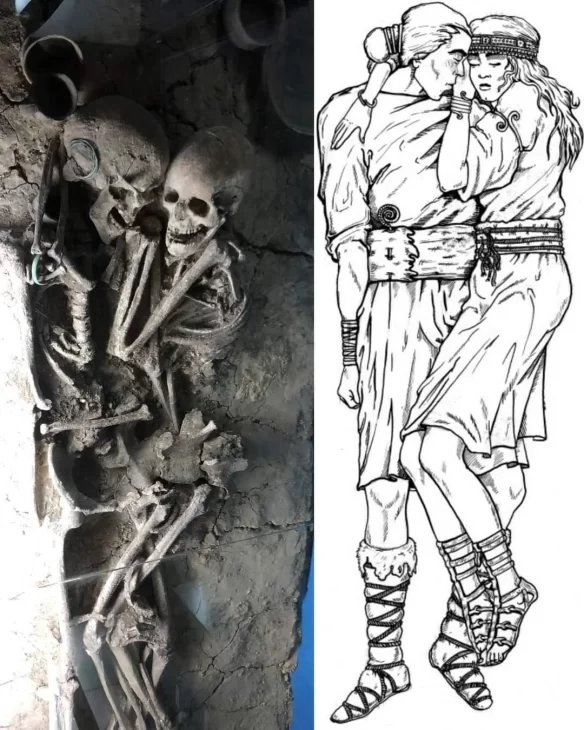
This one has informed the story I’m writing now (The Bear, which will be offered as a free serial when I’m done writing it… hopefully I’ll finish this year). This is a Bronze Age burial of a man and a woman in the Ukraine, near the town of Petrykiv. There is speculation that the woman elected to be buried with the man, possibly taking poison in order to join him in death. That’s not the part that caught my attention. What caught my attention, and thus my imagination, was the description of the burial:
It is a unique burial, a man and a woman lying there, hugging each other tight. Both faces were gazing at each other, their foreheads were touching. The woman was lying on her back, with her right arm she was tenderly hugging the man, her wrist lying on his right shoulder.
It’s such a sweet image, and it’s been in my head since I read about the discovery in 2018. Imagine being so in love with someone that you are buried together with them, forever in an embrace. Of course, such a burial requires an epic love story. I hope to deliver that. Of course, there are also demons and epic battles involved, because it’s me. But the kind of love between two people that would result in such a burial is the centre of this one.
For folks looking for inspiration for their fiction, particularly fantasy, I cannot recommend the academic fields of prehistoric anthropology and archaeology enough. So, I didn’t make a career out of my degree… Or, at least, not yet. If ever I manage to get to a point where my writing supports my life, then I can safely say that, at long last, I am using my degree. Not, you know, in the way I imagined when I graduated, but I wouldn’t be wasting my degree.
Are there any things in the realm of prehistory anthropology and archaeology that caught your eye and had you imagining stories to go with them? I’d love to hear about it!
When S.M. Carrière isn’t brutally killing your favorite characters, she spends her time teaching martial arts, live streaming video games, and cuddling her cat. In other words, she spends her time teaching others to kill, streaming her digital kills, and a cuddling furry murderer. Her most recent titles include Daughters of Britain, Skylark and Human. Her serial The New Haven Incident is free and goes up every Friday on her blog.
A (Black) Gat in the Hand: William Patrick Murray – Who was N.V. Romero?
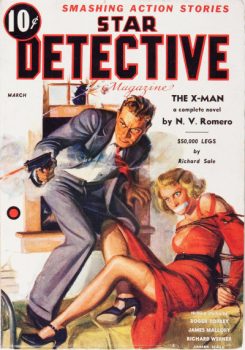 “You’re the second guy I’ve met within hours who seems to think a gat in the hand means a world by the tail.” – Phillip Marlowe in Raymond Chandler’s The Big Sleep
“You’re the second guy I’ve met within hours who seems to think a gat in the hand means a world by the tail.” – Phillip Marlowe in Raymond Chandler’s The Big Sleep
(Gat — Prohibition Era term for a gun. Shortened version of Gatling Gun)
Will Murray has graced this column multiple times, and he has delved into a mystery or two. He’s got another one today, looking into a Pulp byline from the nineteen thirties that has gnawed away at him. And by golly, Will finally had enough! Read on…
____________________________________________
For literally decades, I’ve been intrigued and baffled by the cryptic byline N. V. Romero, which was emblazoned on the front cover of the March, 1937 Star Detective Magazine.
I don’t remember where or when I picked up that old Red Circle pulp magazine. Probably at a collector’s convention somewhere in the 1970s or 80s. It grabbed my attention because the cover-featured lead novel bore the intriguing title,
“The X-Man.”
That’s a coinage I did not think existed prior to Marvel Comics releasing X-Men #1 in 1963. So I grabbed it. I probably paid about five bucks. It was in reasonably good condition. And it was published by Martin Goodman, who later launched Marvel Comics.
This issue is comparatively rare. My copy has the distinction of having been photographed so the cover could appear in Les Daniels’ 1990 book, Marvel, as a weird precursor to The X-Men.
The story Stan Lee always told was that he wanted to call his new comic book about a school for teenaged superheroes, The Mutants. Publisher Goodman objected to the title on the grounds that young readers might not know the term, and Lee claimed to have suggested The X–Men instead. The X stood for extra power.
If that’s true, it’s quite a coincidence that Lee independently coined the term X-Man more than 25 years after Goodman published a cover story by that name. Lee’s memory was not always reliable, and it could be self-serving. It would not shock me if Goodman actually suggested the new title based on his memory of this cover story. Goodman had the reputation of being cover-conscious, believing that covers and titles were the chief elements that sold magazines.
“The X-Man” is the first-person account of Texas special investigator Daniel “Dash” Antonio of the border city of La Plaza District Attorney’s office. It’s a hardboiled story that gets a little metaphysical in spots. In the year of 1937, the G-man was the rising hero in America, and in the pulp magazines. When he was framed for murder, Antonio starts calling himself “the X-Man.“
“I’m on the spot,” he complains. “Instead of being a G-man, I’m an X-man. Dash Antonio, X-Man.”
The novel was credited to N. V. Romero. That byline was unfamiliar to me. So when pulp magazines began to be indexed in depth, and those indexes posted online, I eagerly looked up the name.
It appeared only once in the tens of thousands of pulp magazines that had been indexed and cross-referenced. And that was for the lead novel of the March 1937 issue of Star Detective.
I thought that exceedingly strange. True, inexperienced authors did sell the occasional yarn to pulp magazines, and never appeared again.
There was a self-described “rank amateur” Missouri writer named Vaughn Bryant who sold a story entitled “The Stalking Satan” to Secret Agent X in 1935. He credited the sale to his agent, Lurton Blassingame. The submission ran in the October issue as “The Wailing Skull.”
Bryant apparently only sold that one story––or at least his byline appeared only once in a pulp magazine. Well, it happens that Secret Agent X was a bottom of the barrel market. As was Star Detective Magazine. Fledgling pulpsters more easily broke into the pages of such titles, as opposed to Black Mask. And many who managed one sale never made another.
But the beginners who sold the odd pulp yarn usually wrote short stories. “The X-Man” was a full-length novel. This suggested a seasoned professional.
For years, I puzzled over that unfamiliar name. I often wondered, Was there a clue to Romero’s true identity concealed in his initials? Phonetically, N. V. sounded like “envy.” That was a dead end. The ethic last name was unusual for a pulp magazine, which shunned anything that didn’t sound unequivocally Anglo-Saxon. That, and the one-time use all but ruled out the possibility that it was a house name.
There was one clue. The novel was set in the fictional town of La Plaza, Texas. I reasoned that the author would probably be a Texas native. My initial thoughts ran to Eugene Cunningham of El Paso, Texas, who primarily wrote Westerns, but did other things. But I had no way of tying Cunningham to Romero. I also considered Margie Harris, a Houston native known for writing detective and gangster stories.
Until it occurred to me to jump onto Newspapers.com and punch in that mysterious byline, limiting the search to Texas newspapers.
The first thing that popped up was a letter to the editor of the El Paso Times bylined N. V. Romero. It was dated October 30, 1937.
My researcher’s antennae lifted and quivered.
I had confidently assumed that N. V. Romero was a pseudonym for some prolific pulpster who preferred to conceal his identity because he wrote for the lower-paying Goodman group. Could it be that there was an actual N. V. Romero, and that unusual byline did not in fact mask anybody previously known to the reading public?
Searching further, I found several more letters and a few poems printed the El Paso Times.
It was beginning to seem as if Mr. Romero was nobody other than an unknown author––but also kind of a national non-entity.
One 1933 reference suggested that he worked as a grocer and ran the R. Gomez grocery store in El Paso.
But I had yet to discover absolute proof that this was the nebulous author of The X-Man. I continued scrolling.
Then I came across this gem in the El Paso Times‘ “Around Here” column for March 18, 1937:
AUTHORS DETECTIVE NOVEL.
“It might be interesting to note,” writes M. S. Salcido, “that N. V. Romero, who writes such nice poetry for the Sunday Book Page, has a hard and fast detective novel featured on the cover of the Star Detective Magazine for March.”
Columnist H. S. Hunter added:
“Thanks for the tip. It’s good to know when an El Pasoan comes out with either novel or short story, or accomplishes worthwhile work any other line, for that matter, and this column welcomes a chance to give him a hand.’
There it was––conclusive proof! Mr. Romero was real and he was the actual author of that oddball lead novel.
I was rather chagrined. Decades before, I had written an article on the subject for Comic Book Marketplace where I confidently asserted that N. V. Romero was almost certainly a pseudonym for a hitherto-unidentified pulp author.
It just goes to show that even though one might be considered an expert in the pulp field, it’s dangerous to jump to conclusions.
It’s also a good thing I’m a stubborn and indefatigable researcher. And that I had a subscription to Newspapers.com.
As would be expected of someone who did not go on to literary fame, few facts can be gleaned about this obscure writer.
The author was a lifelong resident of the border town of El Paso, which is the obvious inspiration for La Plaza. A reference to La Plaza’s unnamed sister city across the Rio Grande River points to Juarez, which lies on the other side of the Rio from El Paso.
According to one newspaper notice, in 1931 Romero was admitted to Kalevala, the English Honor Society of the El Paso High School. Out of 76 students who applied, he was one of only 16 admitted. Admission was based on a writing sample. So his inclination toward writing may have started there. Even as a high schooler, he was known as N. V. Romero.
Apparently, Romero never married, or had children. He lived at the same El Paso address for decades. Other than the odd car accident, his name only appeared in print when he wrote a letter or poem for publication in the El Paso Times, which he did periodically, always signing it N. V. Romero.
Popping over to Ancestry.com, I discovered the secret of those mysterious initials. Romero’s 1940 Draft registration card listed his full name as Nicolas Varela Romero, age 25, born March 10, 1915. Under remarks about his fitness to serve was written: “Lame—on crutches.” I assume therefore that the Draft did not take him.
His birthdate means that Romero wrote “The X–Man’ when he was only 20 or 21.
According to Newspapers.com, Mr. Romero died on March 3, 1998 at the age of 82. His past occupations were given as architect, notary public and small business accountant. A 1940s census listed his occupation at the age of 30 as self-employed architect, working for different companies. As far as I’m able to determine, Romero never published another line of fiction in a national magazine for the rest of his days. At least, not under any variation of his real name.…
Bob on Red Circle:
Martin Goodman formed Red Circle Magazines in 1935, and Red Circle cranked out a plethora of low-grade Pulps, including:
All Star Fiction, All Star Adventures, Star Detective, Star Sports, Sports Action, Adventure Trails, Complete Adventures, Complete Western Book, Detective Short Stories, Complete Detective, Complete Sports, Best Sports, Mystery Tales, Top-Notch Western, Top-Notch Detective, Two-Gun Western, Six-Gun Western, Gunsmoke Western, Sky Devils, Western Short Stories, Cowboy Action Novels, Quick-Trigger Western, Modern Love, Wild West Stories & Complete Novel Magazine, Real Sports, Ka-Zar, and Marvel Science Stories.
Star Detective was a Weird Menace Pulp and ran for eleven issues in 1935-1938. It was changed to Uncanny Tales, lasted five more issues and that was the end. But it was a low-end Pulp, never publishing more than three issues in a year and not making any impact, short or long term.
Star did have some notable names, including Hugh B. Cave, L. Ron Hubbard, E. Hoffman Price, Paul Cain, Roger Torrey, and Richard Sale.
2025 (2)
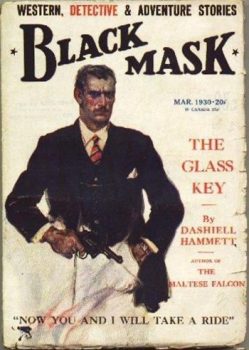 Shelfie – Dashiell Hammett
Shelfie – Dashiell Hammett
Windy City Pulp & Paper Fest – 2025
2024 Series (11)
Will Murray on Dashiell Hammett’s Elusive Glass Key
Ya Gotta Ask – Reprise
Rex Stout’s “The Mother of Invention”
Dime Detective, August, 1941
John D. MacDonald’s “Ring Around the Readhead”
Harboiled Manila – Raoul Whitfield’s Jo Gar
7 Upcoming A (Black) Gat in the Hand Attractions
Paul Cain’s Fast One (my intro)
Dashiell Hammett – The Girl with the Silver Eyes (my intro)
Richard Demming’s Manville Moon
More Thrilling Adventures from REH
Prior Posts in A (Black) Gat in the Hand – 2023 Series (15)
Back Down those Mean Streets in 2023
Will Murray on Hammett Didn’t Write “The Diamond Wager”
Dashiell Hammett – ZigZags of Treachery (my intro)
Ten Pulp Things I Think I Think
Evan Lewis on Cleve Adams
T,T, Flynn’s Mike & Trixie (The ‘Lost Intro’)
John Bullard on REH’s Rough and Ready Clowns of the West – Part I (Breckenridge Elkins)
John Bullard on REH’s Rough and Ready Clowns of the West – Part II
William Patrick Murray on Supernatural Westerns, and Crossing Genres
Erle Stanley Gardner’s ‘Getting Away With Murder (And ‘A Black (Gat)’ turns 100!)
James Reasoner on Robert E. Howard’s Trail Towns of the old West
Frank Schildiner on Solomon Kane
Paul Bishop on The Fists of Robert E. Howard
John Lawrence’s Cass Blue
Dave Hardy on REH’s El Borak
Prior posts in A (Black) Gat in the Hand – 2022 Series (16)
Asimov – Sci Fi Meets the Police Procedural
The Adventures of Christopher London
Weird Menace from Robert E. Howard
Spicy Adventures from Robert E. Howard
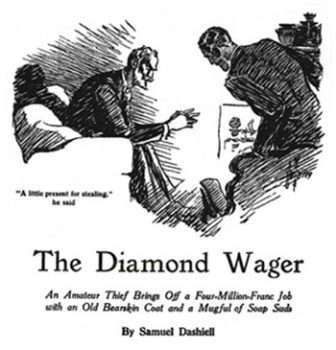 Thrilling Adventures from Robert E. Howard
Thrilling Adventures from Robert E. Howard
Norbert Davis’ “The Gin Monkey”
Tracer Bullet
Shovel’s Painful Predicament
Back Porch Pulp #1
Wally Conger on ‘The Hollywood Troubleshooter Saga’
Arsenic and Old Lace
David Dodge
Glen Cook’s Garrett, PI
John Leslie’s Key West Private Eye
Back Porch Pulp #2
Norbert Davis’ Max Latin
Prior posts in A (Black) Gat in the Hand – 2021 Series (7 )
The Forgotten Black Masker – Norbert Davis
Appaloosa
A (Black) Gat in the Hand is Back!
Black Mask – March, 1932
Three Gun Terry Mack & Carroll John Daly
Bounty Hunters & Bail Bondsmen
Norbert Davis in Black Mask – Volume 1
Prior posts in A (Black) Gat in the Hand – 2020 Series (21)
Hardboiled May on TCM
Some Hardboiled streaming options
Johnny O’Clock (Dick Powell)
Hardboiled June on TCM
Bullets or Ballots (Humphrey Bogart)
Phililp Marlowe – Private Eye (Powers Boothe)
Cool and Lam
All Through the Night (Bogart)
Dick Powell as Yours Truly, Johnny Dollar
Hardboiled July on TCM
YTJD – The Emily Braddock Matter (John Lund)
Richard Diamond – The Betty Moran Case (Dick Powell)
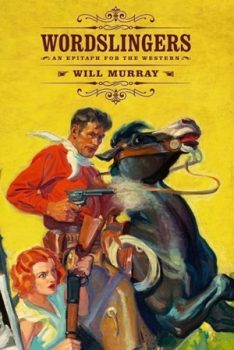 Bold Venture (Bogart & Bacall)
Bold Venture (Bogart & Bacall)
Hardboiled August on TCM
Norbert Davis – ‘Have one on the House’
with Steven H Silver: C.M. Kornbluth’s Pulp
Norbert Davis – ‘Don’t You Cry for Me’
Talking About Philip Marlowe
Steven H Silver Asks you to Name This Movie
Cajun Hardboiled – Dave Robicheaux
More Cool & Lam from Hard Case Crime
A (Black) Gat in the Hand – 2019 Series (15)
Back Deck Pulp Returns
A (Black) Gat in the Hand Returns
Will Murray on Doc Savage
Hugh B. Cave’s Peter Kane
Paul Bishop on Lance Spearman
A Man Called Spade
Hard Boiled Holmes
Duane Spurlock on T.T. Flynn
Andrew Salmon on Montreal Noir
Frank Schildiner on The Bad Guys of Pulp
Steve Scott on John D. MacDonald’s ‘Park Falkner’
William Patrick Murray on The Spider
John D. MacDonald & Mickey Spillane
Norbert Davis goes West(ern)
Bill Crider on The Brass Cupcake
A (Black) Gat in the Hand – 2018 Series (32)
George Harmon Coxe
Raoul Whitfield
Some Hard Boiled Anthologies
Frederick Nebel’s Donahue
Thomas Walsh
Black Mask – January, 1935
Norbert Davis’ Ben Shaley
D.L. Champion’s Rex Sackler
Dime Detective – August, 1939
Back Deck Pulp #1
W.T. Ballard’s Bill Lennox
Erle Stanley Gardner’s The Phantom Crook (Ed Jenkins)
Day Keene
Black Mask – October, 1933
Back Deck Pulp #2
Black Mask – Spring, 2017
Erle Stanley Gardner’s ‘The Shrieking Skeleton’
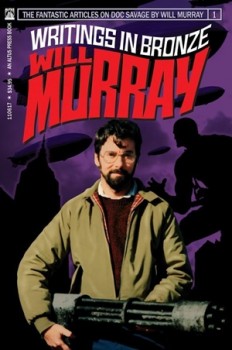 Frank Schildiner’s ‘Max Allen Collins & The Hard Boiled Hero’
Frank Schildiner’s ‘Max Allen Collins & The Hard Boiled Hero’
A (Black) Gat in the Hand: William Campbell Gault
A (Black) Gat in the Hand: More Cool & Lam From Hard Case Crime
MORE Cool & Lam!!!!
Thomas Parker’s ‘They Shoot Horses, Don’t They?’
Joe Bonadonna’s ‘Hardboiled Film Noir’ (Part One)
Joe Bonadonna’s ‘Hardboiled Film Noir’ (Part Two)
William Patrick Maynard’s ‘The Yellow Peril’
Andrew P Salmon’s ‘Frederick C. Davis’
Rory Gallagher’s ‘Continental Op’
Back Deck Pulp #3
Back Deck Pulp #4
Back Deck Pulp #5
Joe ‘Cap’ Shaw on Writing
Back Deck Pulp #6
The Black Mask Dinner
 There are some outstanding names in the ‘New Pulp’ field, but William Patrick Murray’s probably stands above them all. Along with Doc Savage, Will has written Tarzan and The Spider. And he’s quite the Sherlock Holmes writer. Short stories, comic books, radio plays, nonfiction essays and books – Murray has done it all. He created The Unbeatable Squirrel Girl for Marvel Comics, and his collection of essays on Doc Savage, Writings in Bronze, is a must read. I love a good book introduction, and Murray has written some fine ones for Steeger Books. Visit his website Adventures in Bronze.
There are some outstanding names in the ‘New Pulp’ field, but William Patrick Murray’s probably stands above them all. Along with Doc Savage, Will has written Tarzan and The Spider. And he’s quite the Sherlock Holmes writer. Short stories, comic books, radio plays, nonfiction essays and books – Murray has done it all. He created The Unbeatable Squirrel Girl for Marvel Comics, and his collection of essays on Doc Savage, Writings in Bronze, is a must read. I love a good book introduction, and Murray has written some fine ones for Steeger Books. Visit his website Adventures in Bronze.

Bob Byrne’s ‘A (Black) Gat in the Hand’ made its Black Gate debut in 2018 and has returned every summer since.
His ‘The Public Life of Sherlock Holmes’ column ran every Monday morning at Black Gate from March, 2014 through March, 2017. And he irregularly posts on Rex Stout’s gargantuan detective in ‘Nero Wolfe’s Brownstone.’ He is a member of the Praed Street Irregulars and founded www.SolarPons.com (the only website dedicated to the ‘Sherlock Holmes of Praed Street’).
He organized Black Gate’s award-nominated ‘Discovering Robert E. Howard’ series, as well as the award-winning ‘Hither Came Conan’ series. Which is now part of THE Definitive guide to Conan. He also organized 2023’s ‘Talking Tolkien.’
He has contributed stories to The MX Book of New Sherlock Holmes Stories — Parts III, IV, V, VI, XXI, and XXXIII.
He has written introductions for Steeger Books, and appeared in several magazines, including Black Mask, Sherlock Holmes Mystery Magazine, The Strand Magazine, and Sherlock Magazine.
You can definitely ‘experience the Bobness’ at Jason Waltz’s ’24? in 42′ podcast.
Damien Broderick, April 22, 1944 – April 19, 2025
 Damien Broderick
Damien Broderick
Australian writer, editor, and critic Damien Broderick has died, April 19, 2025, just a few days short of his 81st birthday. He died peacefully in his sleep after a long illness. He is survived by his wife and occasional collaborator Barbara Lamar.
I had known Damien quite well online for decades, including interactions in newsgroups and on mailing lists as well as personal correspondence. We met only once, at the World Fantasy Convention in 2017, in San Antonio, TX, where Damien lived at that time; and we had a nice if brief conversation. Damien was showing signs of physical frailty at the time but was still mentally sharp. I had the honor of writing the foreword to his 2012 collection Adrift in the Noösphere, and to reprint a couple of his excellent short stories.
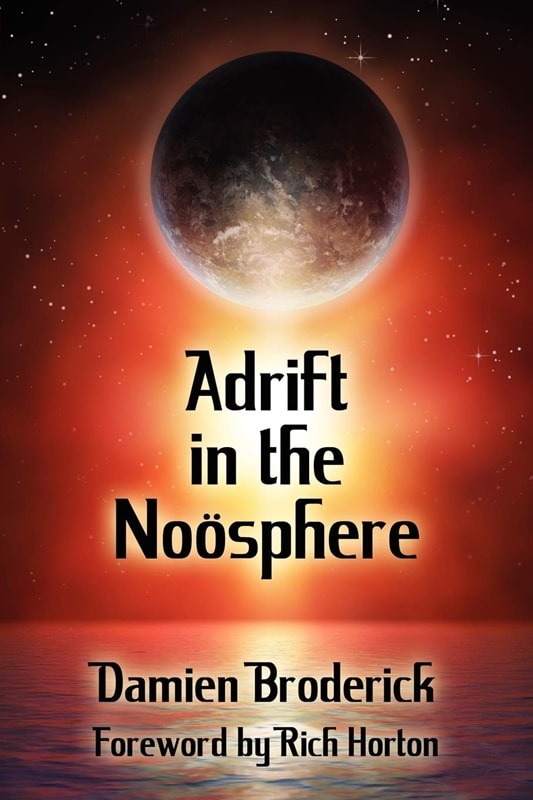
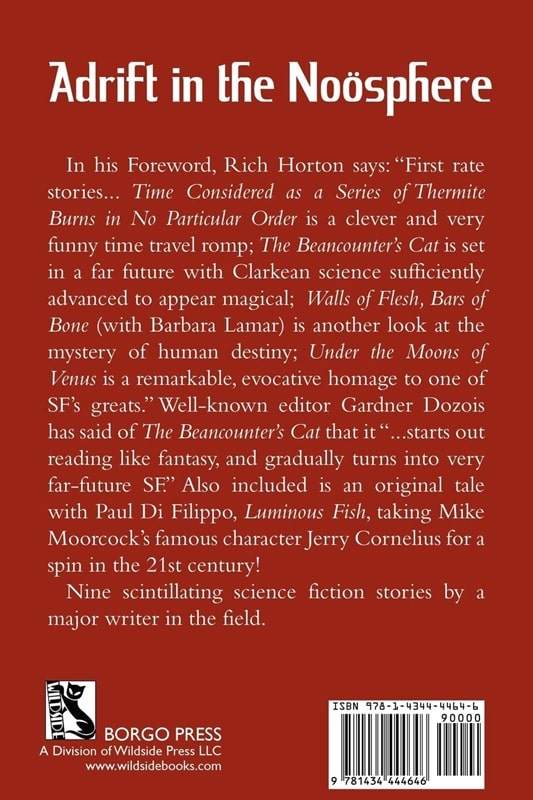
Adrift in the Noösphere (Borgo Press, April 2012)
Damien Broderick was born April 22, 1944, in Melbourne, Australia. He began publishing at the age of 20 with “The Sea’s Furthest End” in the first volume of John Carnell’s original anthology series New Writings in SF.
His first novel, Sorcerer’s World, appeared in 1970 but didn’t gain much notice. (Perhaps deservedly so – I found it less than successful myself and Damien once admitted to me that he regretted some fairly juvenile tricks he played in the novel – he extensively revised it in 1985 as The Black Grail.)
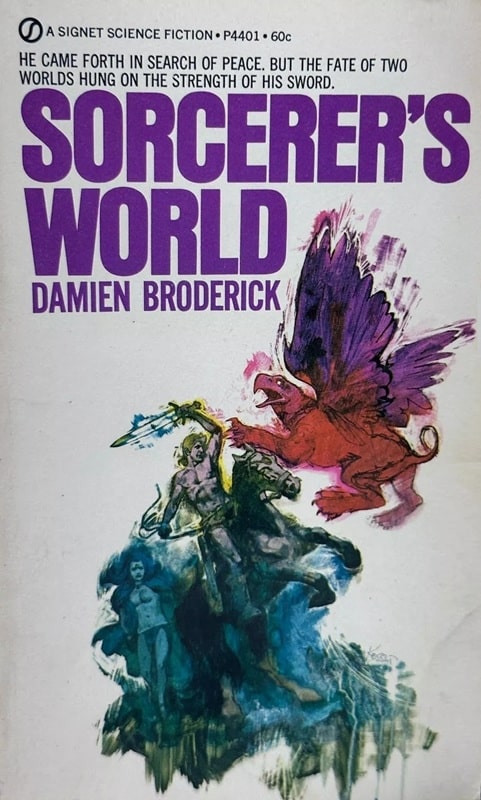
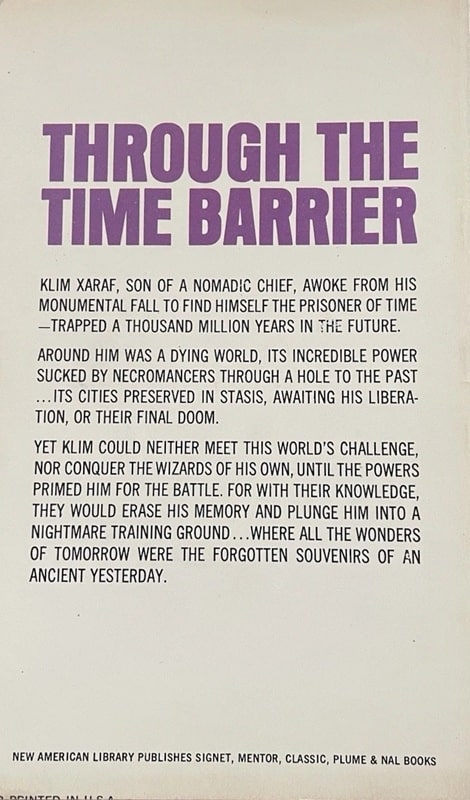

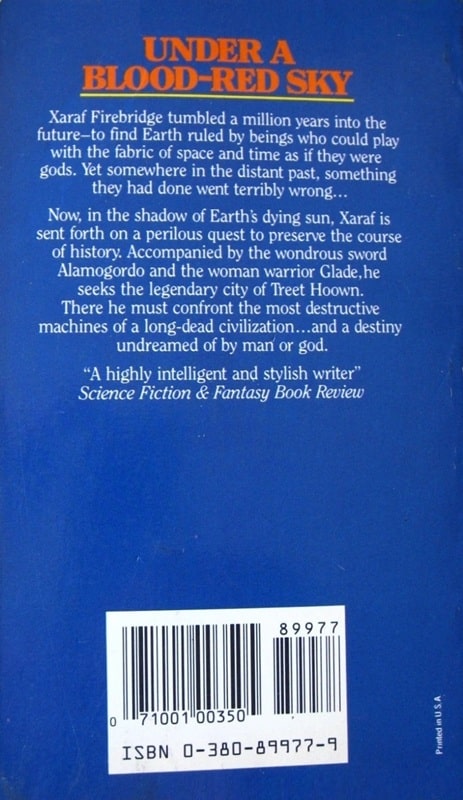
Sorcerer’s World (Signet, October 1970) and The Black Grail
(Avon, September 1986). Covers by Sanford Kossin and Luis Royo
Indeed, Broderick was fond of radically reworking and improving his stories – he revised his first story, “The Sea’s Furthest End,” twice; and also revised The Dreaming Dragons, which won a Ditmar on its first appearance in 1980, as The Dreaming in 2001.
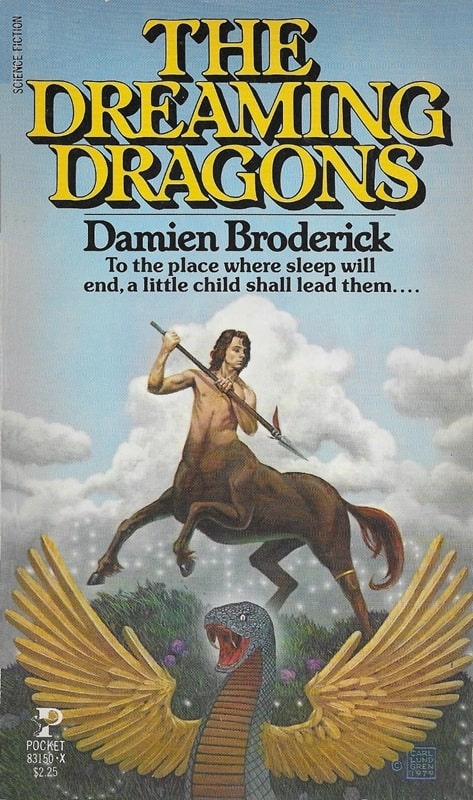
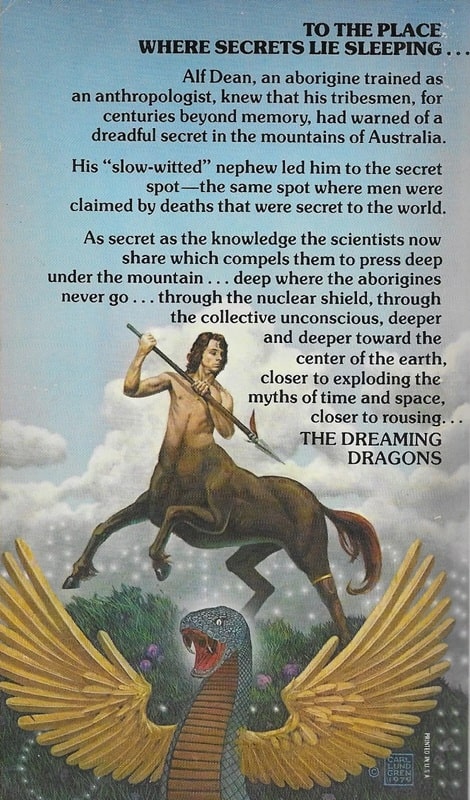
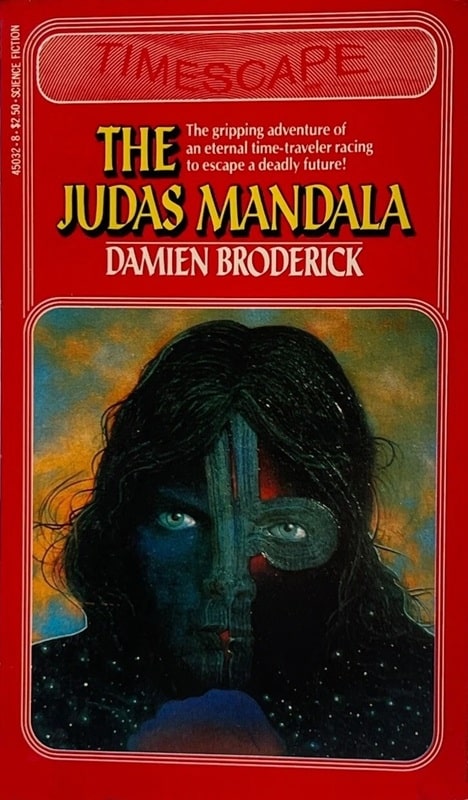

The Dreaming Dragons (Pocket Books, November 1980) and The Judas Mandala
(Timescape, October 1982). Covers by Carl Lundgren, uncredited
Broderick began to gain wider notice with The Dreaming Dragons, and subsequent novels including The Judas Mandala (1982), The White Abacus (1997), and the impressive diptych comprising Godplayers (2005) and K-Machines (2006) earned him much praise, and eventually four Ditmar awards and three Aurealis awards (the two most prominent Australian SF awards.) He was granted the A. Bertram Chandler Award for Outstanding Achievement in Australian Science Fiction in 2010.
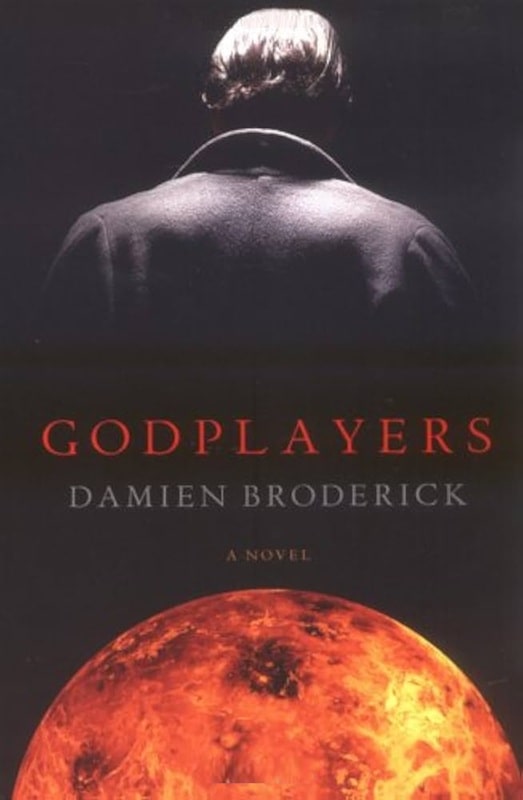

Godplayers and K-Machines (Thunder’s Mouth Press,
May 2005 and March 2006). Covers by David Riedy
He also collaborated on a number of novels with Rory Barnes, not all of which were SF – I was impressed by a rather madcap contemporary crime novel called I’m Dying Here (2009) – and with Barbara Lamar he wrote Post Mortal Syndrome (2011). His final “collaborations” were two novels rather radically revising early works by the late John Brunner: Threshold of Eternity (2017) and Kingdom of the Worlds (2021).
Broderick was also a first-rate writer of short fiction. I was profoundly impressed by “The Ballad of Bowsprit Bear’s-Stead (1980) and “The Magi” (1982), and then by a sequence of remarkable work in the 21st century, with several of these stories pastiches of major earlier SF work. The best of this late flowering are “Under the Moons of Venus,” “This Wind Blowing, and This Tide,” “The Qualia Engine,” and “The Beancounter’s Cat”; and in my view Broderick’s late short fiction deserves a closer look.
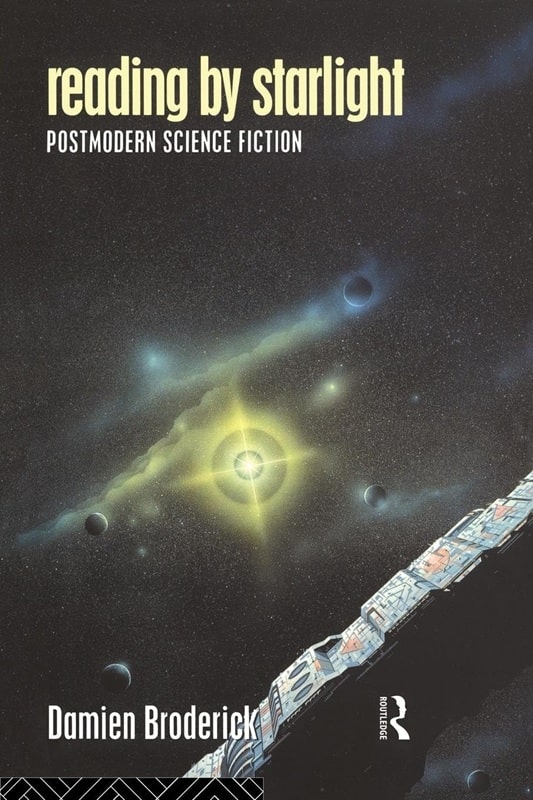
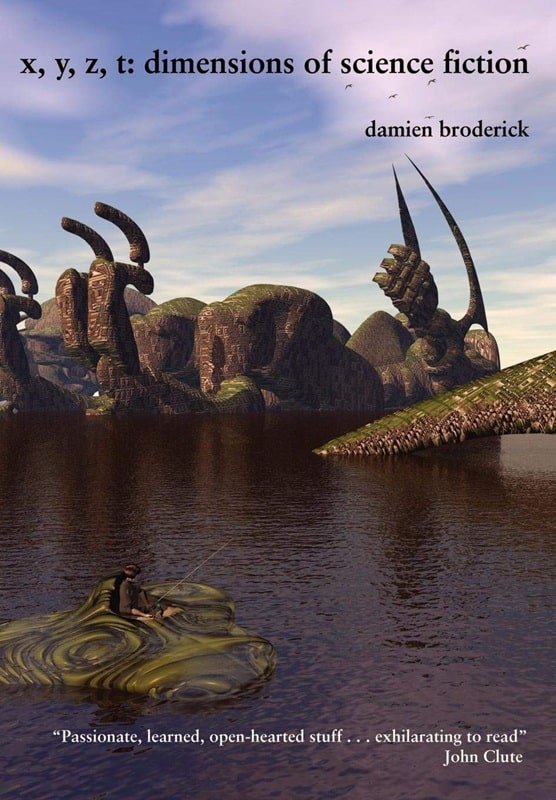
Reading by Starlight: Postmodern Science Fiction (Routledge, 1995) and
X, Y, Z, T: Dimensions of Science Fiction (Borgo Press, January 2004).
Covers by Alan Craddock and Anders Sandberg
He has also written extensively in SF criticism, and in speculative science. Major critical works include Reading by Starlight: Postmodern Science Fiction (1995); Transrealist Fiction: Writing in the Slipstream of Science (2000); and X, Y, Z, T: Dimensions of Science Fiction (2004); as well as, with John Boston, a series of books detailing the history of John Carnell’s seminal UK magazines New Worlds and Science Fantasy issue by issue.
His science books include most notably The Lotto Effect: Towards a Technology of the Paranormal (1992); The Spike: Accelerating into the Unimaginable Future (1997); and Ferocious Minds: Polymathy and the new Enlightenment (2005).
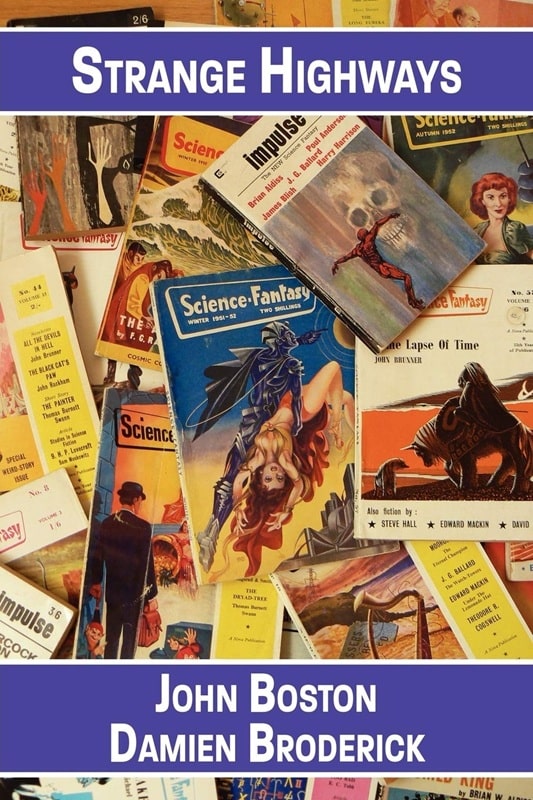
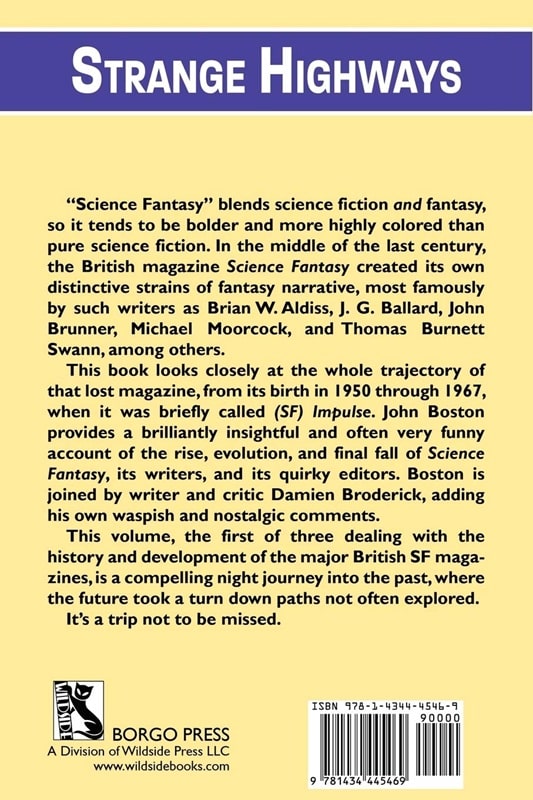


Strange Highways: Reading Science Fantasy, 1950-1967 and Building New Worlds,
1946-1959: The Carnell Era, Volume One (Borgo Press, January 3 and January 29, 2013)
He made contributions as fiction editor of the Australian science magazine Cosmos, and as a prolific anthologist. His anthologies include The Zeitgeist Machine (1977), Earth is But a Star (2001), and, with David Harwell, Centaurus: The Best of Australian Science Fiction (1999).
Damien Broderick was an outstanding science fiction writer – and, to my mind, a somewhat underappreciated one. He was a tireless advocate of Australian SF, in both his anthologies and his critical work. He was an intriguing and rather iconoclastic science writer, very interested in the far future and in very speculative scientific ideas, including paranormal powers. His scientific interests, not surprisingly, also inform his science fiction, much to its benefit (in the The Judas Mandala he seems to have coined the term “Virtual Reality.”)
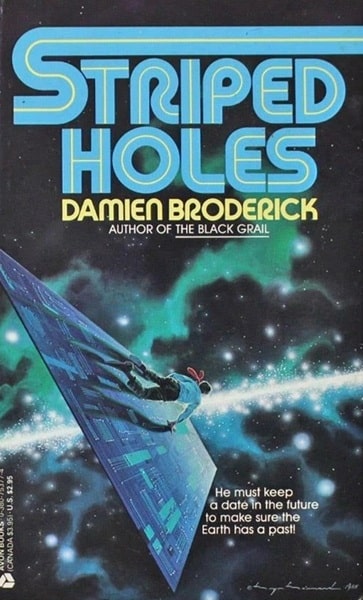

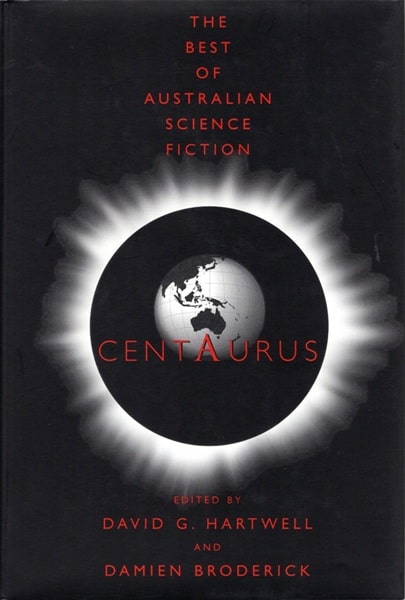
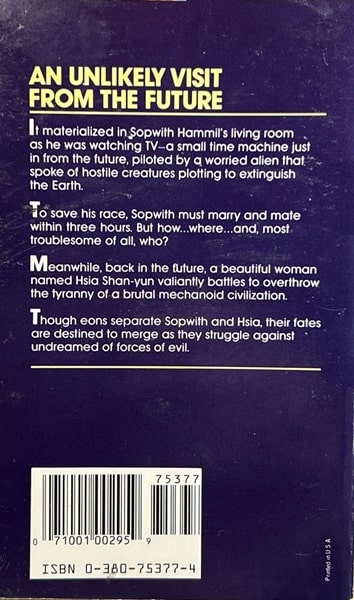


Striped Holes (Avon, November 1988), Science Fiction: The 101 Best Novels 1985-2010,
with Paul Di Filippo (Nonstop Press, 2012), and Centaurus: The Best of Australian Science Fiction,
with David G. Hartwell (Tor, July 1999). Covers by Bryn Barnard, Luis Ortiz, and Peter Lutjen
His range was broad – he wrote fantasy and crime fiction as well as SF, and his fiction could be very funny as well as very dark, sometimes at the same time. I was privileged to know him as well as I did, and I will miss him.
Rich Horton’s last article for us was a Retro-Review of the August 1961 issue of Fantastic magazine. His website is Strange at Ecbatan. Rich has written over 200 articles for Black Gate, see them all here.
Tubi Dive, Part II
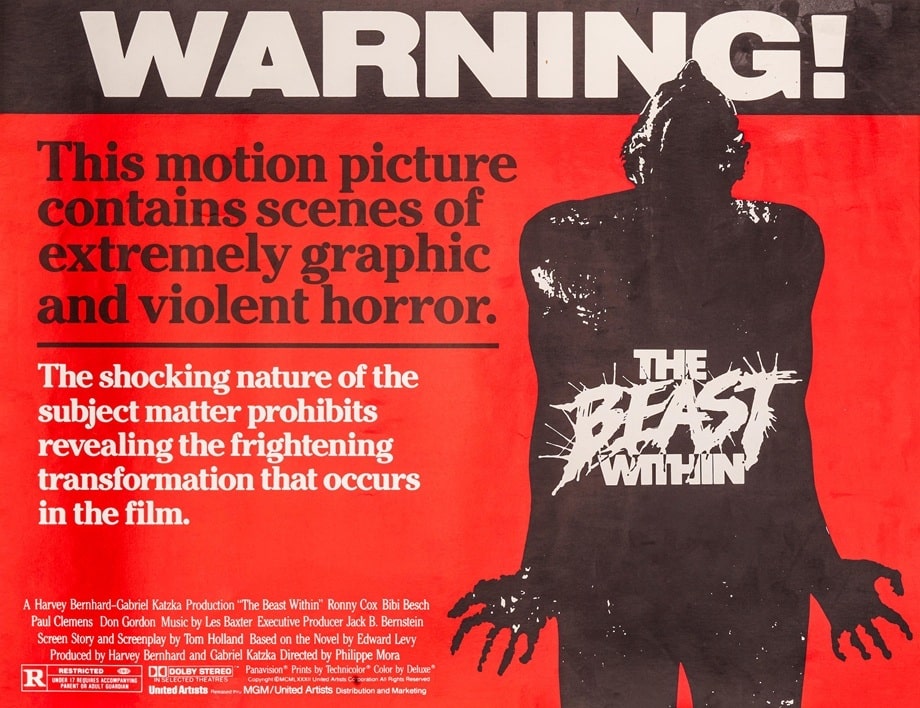 The Beast Within (United Artists, February 12, 1982)
The Beast Within (United Artists, February 12, 1982)
50 films that I dug up on Tubi.
Enjoy!
The Beast Within (1982)This crusty classic from the early 80s exemplifies the beautiful state of the horror genre at that time. This is one of the first writing credits for Tom (Fright Night, Chucky) Holland, and he wears his influences on his sleeve. HPL is well with the theme (evil possession, familial curses) and a couple of character names (Dexter Ward, the Curwins), but for me the primary influence was Hammer’s Curse of the Werewolf (a woman is raped by a foul individual, her subsequent offspring has a hard time of it), although this film could easily be called Curse of the WereCicada — such is its nutty premise.
The young man who has a ‘beast within’ seems to be possessed by his criminal father (later to be echoed in Chucky?), is played quite well by Paul Clemons in essentially a duo role, and anything with Ronny Cox in it is automatically a hit in my book. That said, the film is justifiably derided for some of the acting, and the entire storyline, but it’s a glorious smorgasbord of sweaty, sleazy characters and over-the-top latex bladder effects.
6/10
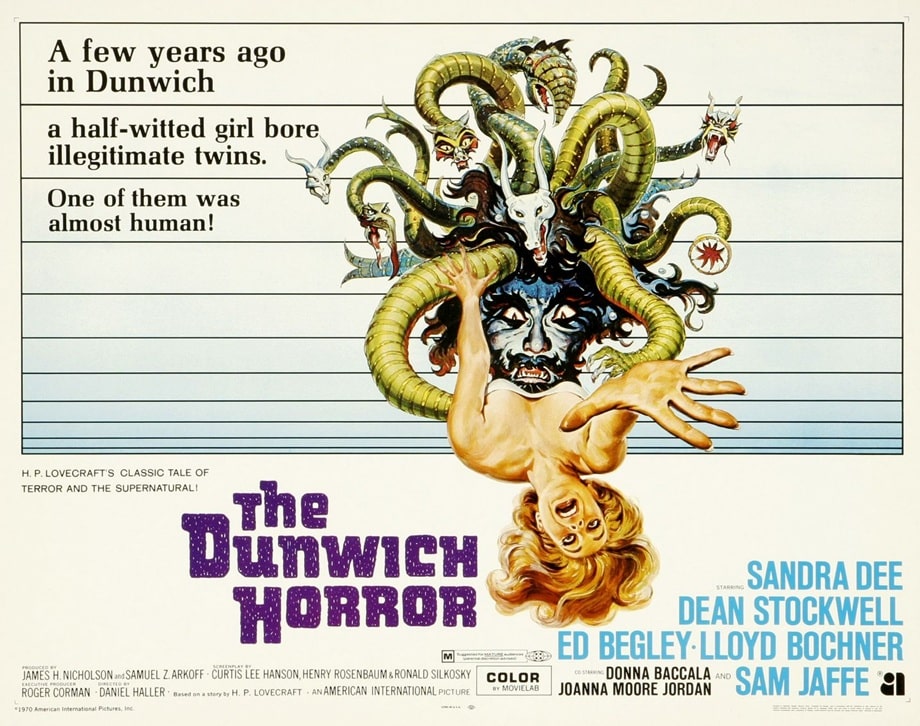 The Dunwich Horror (American International Pictures, January 14, 1970)
The Dunwich Horror (1970)
The Dunwich Horror (American International Pictures, January 14, 1970)
The Dunwich Horror (1970)
Yes, I can hear some of you clutching at your pearls as I write this, but barring a couple of clips here and there, I had never actually seen this one before.
As Lovecraft adaptations go, I guess you could say this is one of the most faithful, what with familiar names and places and ‘Yog-Sothoth’ being yelled approximately 300 times, but it is a far cry from the original source material.
Corman must have read the description of Wilbur Whateley (“goatish”) and interpreted that as ‘horny,’ because this version of WW just wants one thing, and that’s Sanda Dee naked on a sacrificial shagging stone. This is Dee’s first ‘mature’ film, and I wasn’t impressed — she’s a bit bland in this, however, Dean Stockwell as Wilbur is amazing. Now there is an actor who is FULLY committed. The monster in the attic is a bit of a letdown, depicted more like a colour out of space than the sort of tentacled beastie that butters my toast, but the production design is rather lovely, and there are some great matte paintings on show.
Fun for viewers who like gibbering madness and drugged tea.
6/10
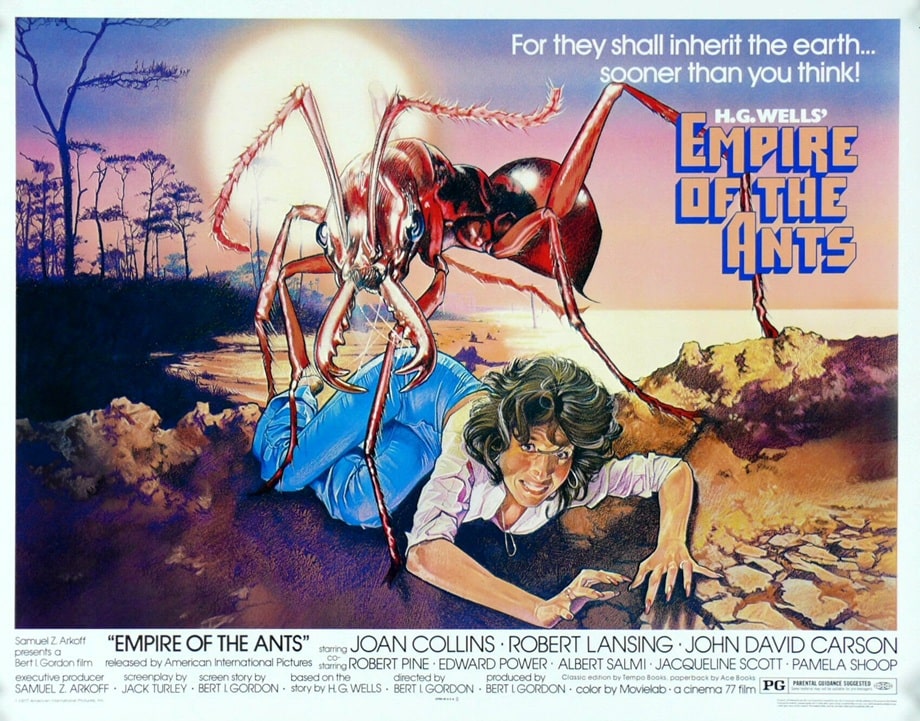 Empire of the Ants (American International Pictures, July 29, 1977)
Empire of the Ants (1977)
Empire of the Ants (American International Pictures, July 29, 1977)
Empire of the Ants (1977)
During that heady time in the mid 70s when so many creature features came out (Jaws, Grizzly, White Buffalo, King Kong et al), this one popped out at the tail end of the boom. I’m a sucker for ant movies (Phase IV, Naked Jungle), and this movie had assumed near mythical status for me, based on a few late-night clips on TV when I was a youngster, and a black and white picture of Joan Collins looking unperturbed, from one of the books that shaped my youth, Sci-Fi Now.
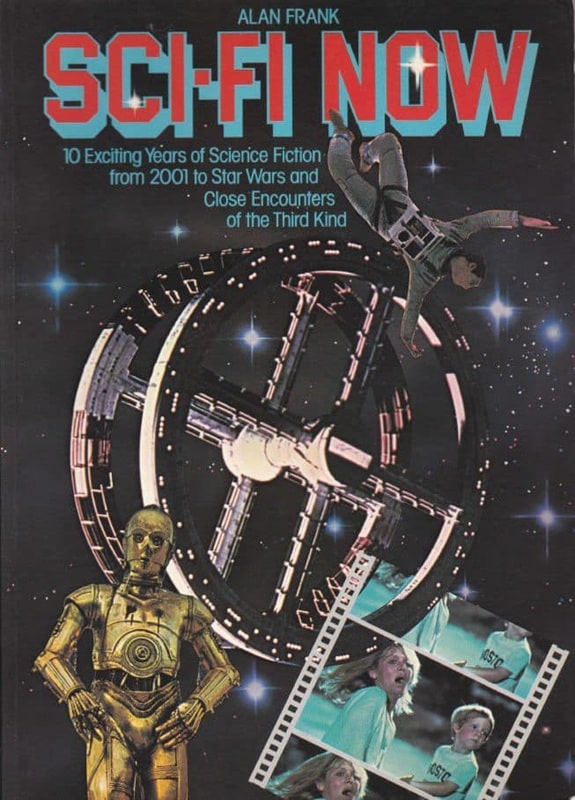

Sci Fi Now by Alan Frank (Octopus, January 1, 1978),
containing the classic still of Joan Collins in Empire of the Ants
Watching it now, as a bitter old man, it’s a bit rubbish.
Directed by Bert I. Gordon, from the H. G. Wells story, it’s a cheesy romp, and set mostly in the Florida Everglades. In the last third of the film the setting moves to a pheromone-controlled town, and this would have made a much better film, however, the preceding snooze-fest in the woods is a bit of a slog. Dodgy effects and horrible sound effects are the icing on this ant-ridden cake.
5/10
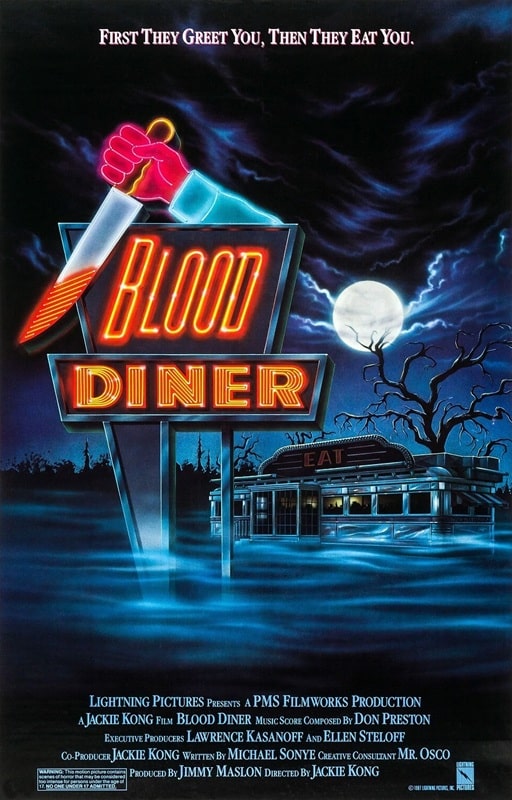
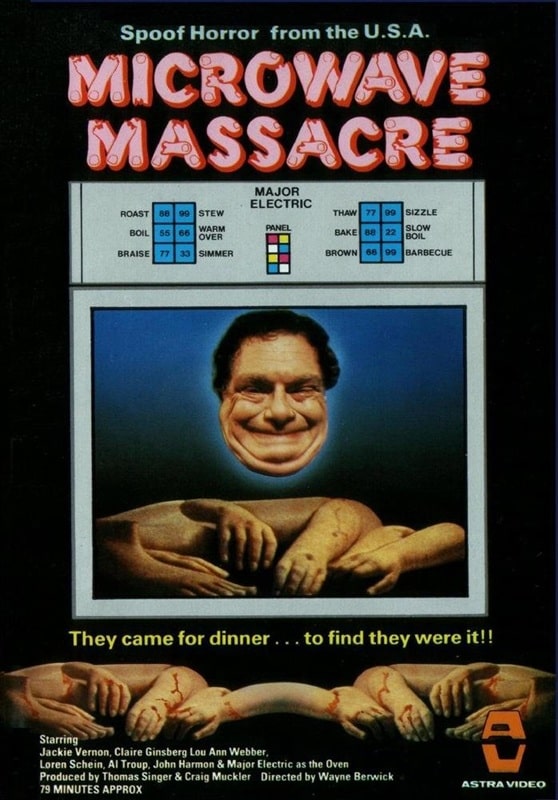
Blood Diner (Lightning Pictures, July 10, 1987)
and Microwave Massacre (Reel Life Productions, 1979)
Regrets, I’ve had a few. Usually after watching a sharksploitation film full of bad actors. However, the only regret I have after watching this stunningly bonkers horror comedy from Jackie Kong, is that I didn’t see it in 1987, thus depriving me of 36 years of annual re-watches.
I’m not sure how she did it, but Kong tapped into the under-developed brain of a 14-yr-old boy and made the perfect film.
It’s ludicrous, gory, offensive, daft as a badger on a hang glider, and quite brilliant — I wholly get why it has achieved such a cult status.
The abysmal acting is just the icing on the cake in this story of a couple of dumb brothers trying to resurrect an ancient, evil goddess by murdering women and using their internal organs in a ritual. All other body parts are served in their diner. As is befitting a mid-80s horror romp, this is full of nudity, sexism, practical dismemberments, and banging tunes.
Highlights include a deep-fried head, a funk band brass section dressed as Hitler, a brain in a jar, death by stalactite, an exploding quiff, an extremely long sequence of someone getting repeatedly run over, someone in a Ronald Reagan mask shooting up a studio full of topless cheerleaders, and the perviest detective you’ll ever meet.
It’s Texas Chainsaw Massacre meets The Naked Gun.
Insane.
10/10
Microwave Massacre (1979)An oddball flick, this does tangentially feature a microwave, but no massacres. To be honest, I’m still coming to terms with whether or not I enjoyed it. The film is supposed to be a farce, but its humor is neither insightful, nor funny. If anything, it plays like an early 70’s smut flick on quaaludes. The acting is amateur at best, and the women are portrayed in only two ways, sexual playthings, or screeching harpies. All are eaten though. The lead character, Donald, is played by Jackie (Frosty the Snowman) Vernon in the most laid back style I have ever witnessed. It’s as if he had just wandered into each scene and someone whispered a line to him, which he would repeat with zero emotion. All very strange, even more so when he turns to camera and just stares at us.
The horror elements are fairly cheesy, as are the nudity scenes (although the first one we get is more disturbing than cheesy), but the ACME Rubber Hand Co. must have made a killing that year.
One for true purveyors of weird stuff.
5/10

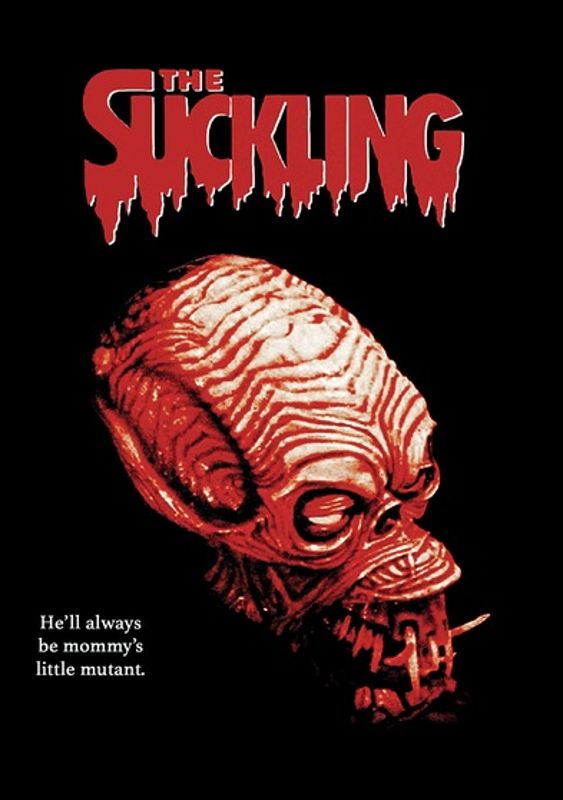
The Shout (Rank Film Distributors, June 16, 1978)
and The Suckling (Hypercube, September 24, 1990)
It’s a funny old world, ain’t it. How a film slips by a purveyor of horror, especially British horror, like myself never fails to intrigue me — yet here we are.
The Shout is not only based on a short story by Robert Graves, but it won a top award in Cannes that year, is a classic bit of British Folk(ish) horror in the same vein as The Wicker Man, and it had eluded me all these years. Now, thanks to Tubi’s unrivalled collection, I have finally seen it, and it’s staggeringly good.
It helps that you got the likes of Alan Bates (at the height of his dangerously sexy period), John Hurt, Susannah York, and every excellent English character actor including fresh-faced Tim Curry and fresher-faced Jim Broadbent in the cast. The story is fairly bonkers — a stranger (Bates) inserts himself into the cozy cottage life of Hurt and York, and proceeds to take over, cuckolding Hurt and claiming York through aboriginal sorcery. Yep, aboriginal sorcery. Apparently he had lived in Australia for 18 years, fallen in with an aboriginal shaman, and learned some dark magics, not least of all the ability to kill a person with a single shout.
The story is bookended by a cricket match between the inmates of an asylum and their carers, and the characters are all connected by this strange game.
It also helps that the exteriors were all shot in Devon, and that the direction and editing are super-interesting, bordering on experimental. The director, Jerzy Skolimowski, wisely keeps many events in the film ambiguous, keeping the viewer on their toes and questioning everything.
Highly recommended if you like 1970s British horror, or modern-day equivalents by the likes of Ben Wheatley, Ari Aster or Robert Eggers.
10/10
The Suckling (1990)Take a look at the official synopsis, and then decide if you want to carry on reading:
When a pregnant woman goes to an illegal abortion clinic doubling as a brothel, her aborted mutant fetus sets out on a violent rampage.
Still here?
Yes, this one is offensive as all hell. The premise is barking mad, the acting is dire (more on this later) and the direction is all wrong, and yet… and yet I found myself laughing so much at this film that I’m loath to give it a bad score, even though it deserves it. The laughs, of course, were unintentional and only caused by terrible lines and delivery of said lines. About 15 minutes in, I suddenly realized why I was enjoying it so much; it’s like a feature-length episode of Garth Marenghi’s Dark Place — there’s even an actor who not only looks like Richard Ayoade, but delivers his lines exactly like Dean Learner.
The fast-growing fetus monster is a slightly goofier version of Rawhead Rex (if that’s possible), and the actual kills are mostly off-screen — I can’t help wondering if this was an edited version I saw.
A particular highlight is the foley added to the film. Every object, ceiling fan, footstep, and door kick is given a loudly incorrect sound effect — you have to watch it just for this.
Bottom line — it’s terrible, awful acting, ridiculous premise, silly fx.
Highly recommended.
6/10
Previous Murkey Movie surveys from Neil Baker include:
Tubi Dive, Part I
What Possessed You?
Fan of the Cave Bear
There, Wolves
What a Croc
Prehistrionics
Jumping the Shark
Alien Overlords
Biggus Footus
I Like Big Bugs and I Cannot Lie
The Weird, Weird West
Warrior Women Watch-a-thon
Neil Baker’s last article for us was Part I of Tubi Dive. Neil spends his days watching dodgy movies, most of them terrible, in the hope that you might be inspired to watch them too. He is often asked why he doesn’t watch ‘proper’ films, and he honestly doesn’t have a good answer. He is an author, illustrator, teacher, and sculptor of turtle exhibits. (AprilMoonBooks.com).
Tor Doubles: #2 Greg Bear’s Hardfought and Timothy Zahn’s Cascade Point
 Hardfought cover by Tony Roberts
Hardfought cover by Tony RobertsCascade Point cover by Tim White
This Tor Double has the distinction of containing two stories which were both nominated for the Hugo for Best Novella in 1984. Zahn beat out Bear for the rocket, as well as works by Hilbert Schenk, Joseph H. Delaney, and David R. Palmer. Bear wouldn’t go away empty-handed, however, since his story “Blood Music” won the Hugo for Best Novelette that same year (beating out works by Kim Stanley Robinson, George R.R. Martin, Connie Willis, and Ian Watson). Published in November of 1988, the cover for Hardfought was painted by Tony Roberts. The cover for Cascade Point was painted by Tim White.
Cascade Point was originally published in Analog in December, 1983. It won the Hugo Award for Best Novella. The story placed second in the Locus poll and the Analog Readers Poll.
Pall Durrikan is the captain on a interstellar cargo ship. Although he and his crew mostly moves cargo between planets, they also take on passengers to help cover costs and turn a profit. In order to make the trip between distant stars, they must navigate through “cascade points,” essentially jumps in hyperspace. Because of the psychological issues the occur…seeing a cascade of images of yourself that appear real…anyone who isn’t required to be awake during the jump is given sedatives to keep them asleep. On more upscale spaceships, an autopilot is installed, but the Aura Dancer, Durrikan’s ship, doesn’t have one of those, so Durrikan, or one of his crew, must stay awake during the jumps.
Early in the novella, Zahn explains that there are eight passengers on the Aura Dancer, but he only really introduces two of them, Rik Bradley and Dr. Hammerfield Lanton. Lanton is a psychiatrist who is treating Bradley for mental illness bordering wit dissociative personality issues. Since Lanton and Bradley are the only passengers introduced, it is clear that they will become important later in the story. Zahn’s decision not to introduce the other characters indicates that the human factor will be less important to the story than the technical issues that will be faced.
Despite this, and Zahn’s focus in on the narrator-Captain, he makes it clear that there is more going on the ship that the Captain sees. Alana is building a relationship with Bradley, although it mostly occurs outside the main narrator, the Captain sharing it with the reader through his perceptions of Alana. Similarly, although Lanton describes his treatment of Bradley during the Cascade Points, the reader never experiences that treatment directly. The other passengers, and most of the crew, are even less germane to the story and barely register.
Cascade Point is a puzzle story. Zahn has set up the rules for his universe and then tweaks them to make things go awry. He hints at the puzzle early in the story with references to ships that have gone missing during their jumps between stars. When the crew of the Aura Dancer finds themselves in a strange place, the puzzle begins to offer a solution. For the reader, the issue is that Zahn has created the situation and holds all the cards. He can make changes to the rules under the guise that the characters have an incomplete understanding of the way their universe works. Cascade points are used, but not entirely understood. Ming metal is known to impact the passage through cascade points, but only in an imperfect way.
The story does include several interesting ideas, including Lanton’s attempt to use the cascade points, which some believe to show images of the individual in alternative timelines, to treat Bradley’s neurosis, although Durrikan questions the concept and isn’t particularly happy about the idea of Bradley and Lanton remaining awake throughout the jumps. Unfortunately, told from Durrikan’s point of view, Zahn is limited in how far he can follow up any of those subplots, focusing only on how they impact the Aura Dancer and the fate of the passengers and crew overall. While the mysteries that crop up about the cascade points are interesting, it feels like there is a lot more happening that the reader isn’t privy to.
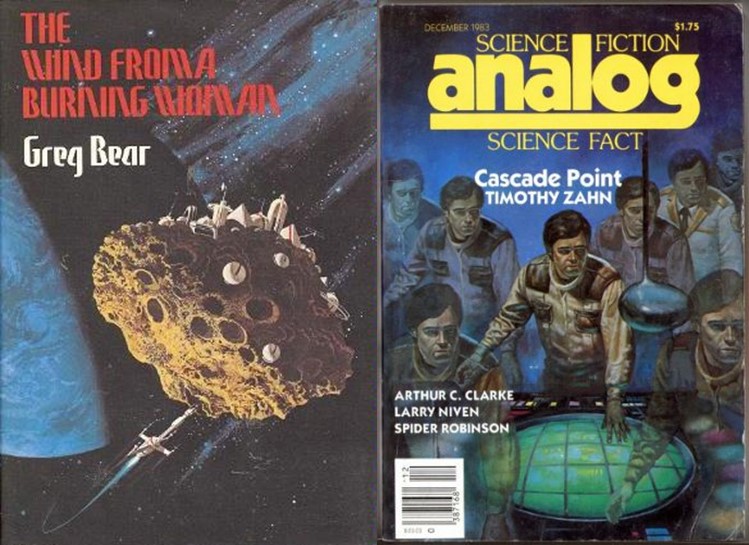 The Wind from a Burning Woman cover by Vincent di Fate
The Wind from a Burning Woman cover by Vincent di FateAnalog cover by Doug Beekman
Hardfought was originally published in Isaac Asimov’s Science Fiction Magazine in February, 1983. It was nominated for the Hugo Award and Nebula Award, winning the latter. It placed fifth in the Locus poll and second in the Science Fiction Chronicle Readers Poll.
John W. Campbell, Jr. was quoted as asking his writers to “Write me a creature that thinks as well as a man or better than a man, but not like a man.” In Hardfought, Greg Bear not only responds to Campbell’s challenge with the creation of the Senexi, an ancient star-faring race, but also with the creation of humans, who bear little resemblance to our own race. Layering these two creations under a lexicon which Bear does not offer to define, but the reader must learn from context, Hardfought provides a hard science fiction story which rewards the careful reader and is likely to leave the casual reader perplexed.
Bear flips back and forth between two protagonists in the story, the Senexi Aryz and a human Prufrax, although it isn’t entirely clear she is human except that Bear has applied that name to her. Her way of thinking and acting certainly feels as alien as anything Bear describes for Aryz. It is clear that the two cultures are at war with each other, but the details of the war, as well as Aryz and Prufrax’s roles in the battle are esoteric.
As with much science fiction, the patient reader is rewarded. It becomes clear that part of the reason for the war is that although the two races are different enough that they should be fighting over the same pieces of real estate, one of the issues is that they come from very different periods in the universe’s evolution. The Senexi are an ancient race, dating to practically moments after the creation of the universe. The Humans are a later race, evolving billions of years after the Senexi. The battle between the two sides is (partly) a generational issue. But even that is too simple an explanation for what is happening between the races.
In addition to the reasons for the war, Bear explores the psychology of the two races. The Senexi have a sort of brood mind with the soldiers like Aryz filling the role of a “branch ind,” clearly based on, but not entirely analogous to the society of bees on earth. The branch inds view themselves as completely expendable, but at the same time they take pride in their roles and seek to serve the brood as successfully as possible.
The humans, as seen by Prufrax, are not the individuals that we usually associate with humans and she seems to be almost a construct who is regenerated to fight as needed, her memories flashing back throughout the story. It is only slowly that her true situation comes to light and causes the reader to reëvaluate the entire story.
Bear is known as a writer of hard science fiction, and Hardfought certainly falls into that category, but it is also reminiscent of the sort of mind-bending concepts that can be found in the works of Samuel R. Delany or Gene Wolfe. Like those authors, and more than other works by Bear, Hardfought is a story which takes on deeper meaning the more time the reader gives to it, both in the reading and in the thinking about it.
While Bear (and other hard science fiction authors) often invents new science to allow himself to explore the worlds he has created, in Hardfought, Bear creates new civilizations and vocabulary, and trusts the reader to be able to figure everything out from context rather than attempting to explain what he is doing and what is happening.
The two hard science fiction stories in this volume of the Tor Doubles series both come from the same tradition, but they arrive in very different places. Zahn’s story is more traditional, and offers the reader its own twists and turns, while Bear’s tale is a much more complex and challenging exploration of the ethics of warfare and civilization.
 Steven H Silver is a twenty-time Hugo Award nominee and was the publisher of the Hugo-nominated fanzine Argentus as well as the editor and publisher of ISFiC Press for eight years. He has also edited books for DAW, NESFA Press, and ZNB. His most recent anthology is Alternate Peace and his novel After Hastings was published in 2020. Steven has chaired the first Midwest Construction, Windycon three times, and the SFWA Nebula Conference numerous times. He was programming chair for Chicon 2000 and Vice Chair of Chicon 7.
Steven H Silver is a twenty-time Hugo Award nominee and was the publisher of the Hugo-nominated fanzine Argentus as well as the editor and publisher of ISFiC Press for eight years. He has also edited books for DAW, NESFA Press, and ZNB. His most recent anthology is Alternate Peace and his novel After Hastings was published in 2020. Steven has chaired the first Midwest Construction, Windycon three times, and the SFWA Nebula Conference numerous times. He was programming chair for Chicon 2000 and Vice Chair of Chicon 7.
Fantastic, August 1961: A Retro-Review
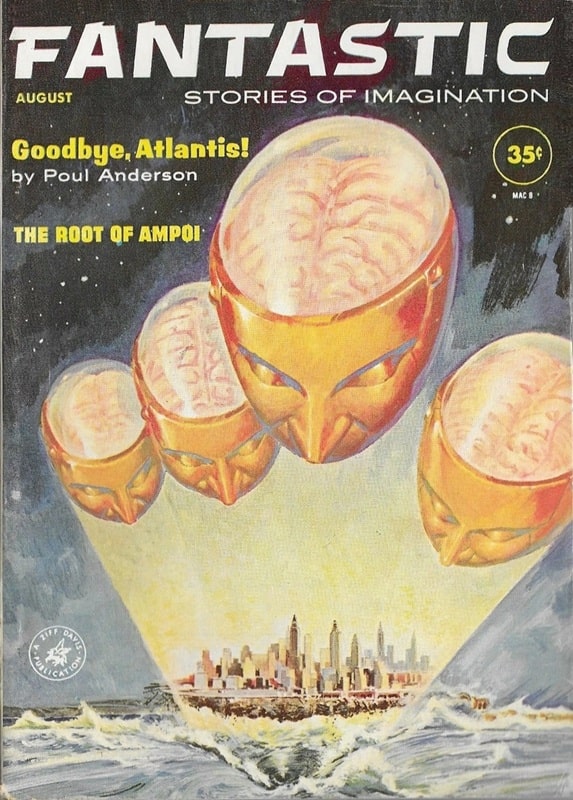
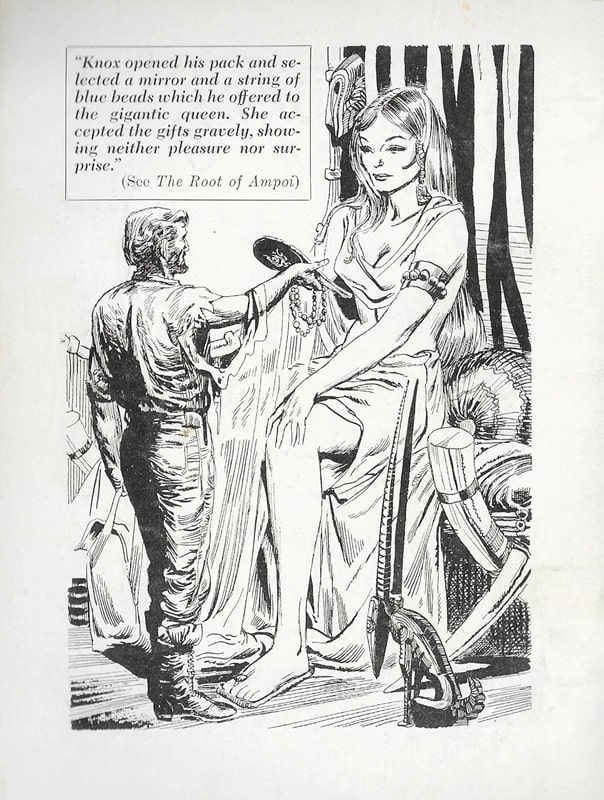
Fantastic, August 1961. Cover by Leo Summers
It’s been a long time since I did a Retro-Review from Cele Goldsmith’s time at Amazing/Fantastic. So I’m happy to be back at it! This issue is from about two years into Goldsmith’s tenure.
There are two features — Norman Lobsenz’s editorial, and the letter column, According to You. (Well, and a brief Coming Soon piece.) The editorial talks about using computers to analyze the various items certain Thais believe have magical powers, ending with a slight joke about hoping to find a love philtre “for Cele.” It introduces the concept by talking about the famous Arthur C. Clarke story in which a computer helps Tibetan monks list all the names of god — but misidentifies the story weirdly by adding another billion names: “The Ten Billion Names of God.”
[Click the images for fantastic versions.]
 Table of Contents for Fantastic, August 1961
Table of Contents for Fantastic, August 1961
According to You has six letters. I recognized some well-known fans: Bill Bowers and Redd Boggs were both prolific fanzine editors and multiple Hugo nominees. Lawrence Crilly, John Pocsik, and David Charles Paskow are not as was well known but do get mentions in Fancyclopedia 3, and indeed the Paskow Collection at Temple University is named for David Paskow. F. C. MacKnight is the other contributor.
The letters concern mostly Fritz Leiber and the newly instituted use of one reprint per issue — both get praise. David Bunch is of course mentioned — negatively by Bowers and positively by Paskow (the latter mention getting this relieved comment from Goldsmith: “We figured that if we kept publishing [Bunch], somebody sooner or later would agree with us that he has something in his stories.”)
The cover is by Leo Summers, the interiors are by Summers, Virgil Finlay, West, Dan Adkins, and Larry Ivie, with a Summers back cover based on the Smith story, and one cartoon by Frosty.
The stories, then.
Novelets“Goodbye, Atlantis!,” by Poul Anderson (9,000 words)
“Stranger in Paradox,” by Keith Laumer (9,200 words)
“Passage to Malish,” by Theodore L. Thomas (9,000 words)
“The Root of Ampoi,” by Clark Ashton Smith (5,900 words)
“One Small Drawback,” by Jack Sharkey (3,800 words)
“Report on the Magic Shop,” by Arthur Porges (3,000 words)
“Policeman’s Lot,” by Henry Slesar (3,600 words)
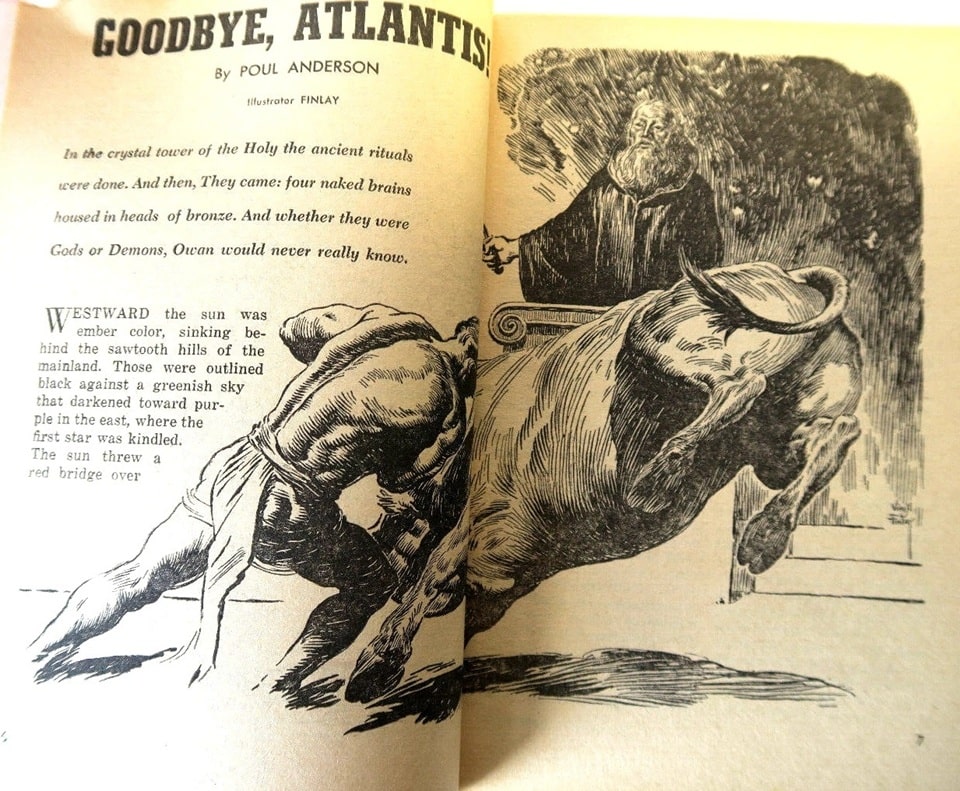 “Goodbye, Atlantis!” by Poul Anderson, illustrated by Virgil Finlay
“Goodbye, Atlantis!” by Poul Anderson, illustrated by Virgil Finlay
“Goodbye, Atlantis!” is a very obscure Anderson story — it’s only ever been reprinted once, in one of Sol Cohen’s super cheap and ugly all-reprint magazines, which mostly or entirely mined the Amazing/Fantastic backlist for material (and reprinted it (legally) without pay until SFWA objected, after which apparently Cohen made nominal payments.)
The lack of reprints is a bit odd, because “Goodbye, Atlantis!” isn’t terrible. It’s no lost classic, but it’s fine. The viewpoint character is Owan, a guard Captain in the retinue of the nobleman Donwirel and his wife Rianna, who is the niece of the former king of Atlantis, and thus cousin to the current king. Owan is in love with the beautiful Rianna, but at this time the concern is that there is a rebellion against the new king.
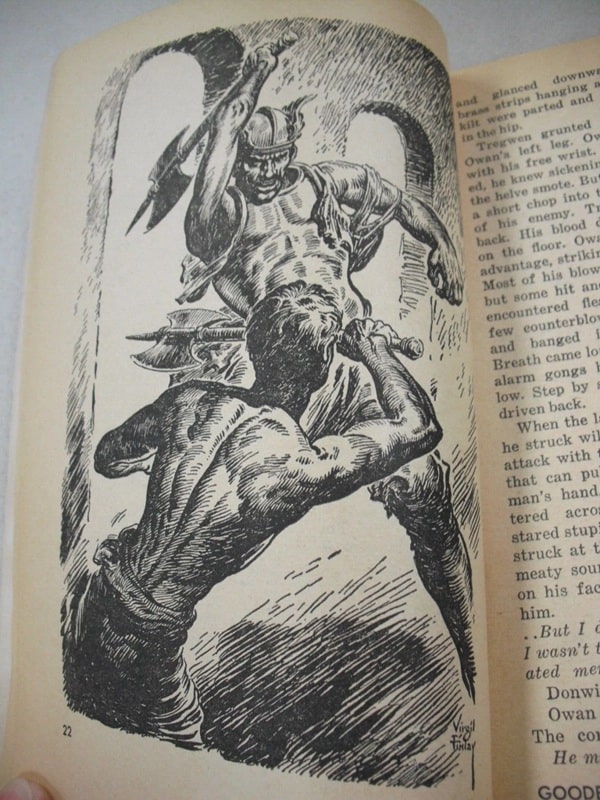 ‘Goodbye, Atlantis!” Illustration by Finlay
‘Goodbye, Atlantis!” Illustration by Finlay
The plot turns on the efforts of the Archpriest Govandon to summon the long absent gods of Atlantis to vanquish the rebels, who are clearly winning the war and have the capitol under siege. Owan has concerns — he doesn’t trust the gods, or perhaps simply doesn’t trust that Govandon’s spells will work. He goes to attend Donwirel, who is working with Govandon — and is poisoned.
It’s clear that Donwirel is a traitor, and only Rianna’s timely intervention saves Owan, after which he struggles to prevent Donwirel from stealing the spells Govandon has learned. There’s some solid action, and Owan (and Rianna) are successful — but their success proves profoundly ambiguous. (Behind it all is a sly suggestion that the rebels were right all along.)
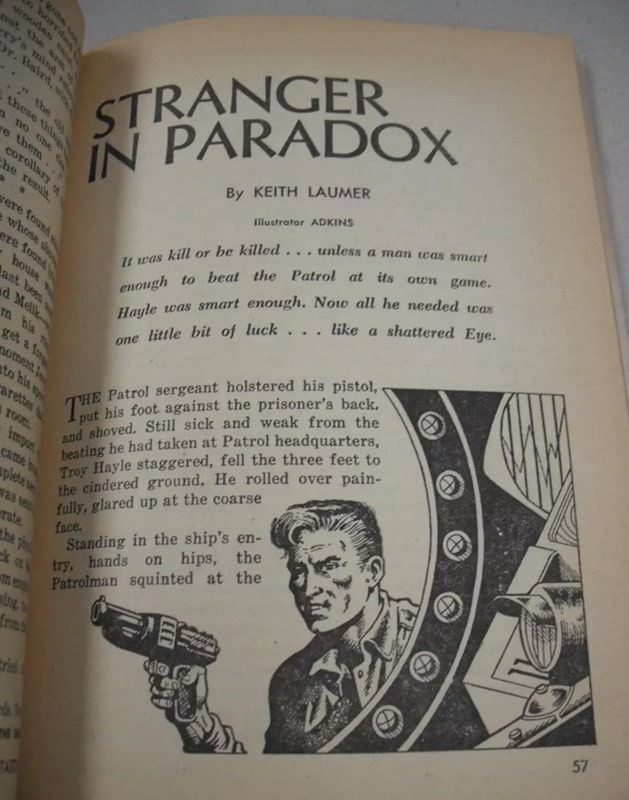 “Stranger in Paradox” by Keith Laumer. Illustrated by Dan Adkins
“Stranger in Paradox” by Keith Laumer. Illustrated by Dan Adkins
“Stranger in Paradox” was, I think, Keith Laumer’s fourth published story. The first two, “Greylorn” and “Diplomat-at-Arms” were published by Goldsmith as well — Laumer was one of her major discoveries, along with Le Guin, Disch, Zelazny and to some extent Ballard (for the American market.) The Retief stories (after “Diplomat-at-Arms”) ended up finding a home in Frederik Pohl’s If, but Goldsmith otherwise published a great deal of Laumer’s early work.
Alas, “Stranger in Paradox” is pretty awful. Hayle is dumped on the title planet by the Patrol, who seem to be the agents of the despotic rulers of this future. (Details are pretty slight.) They leave him nothing but a short sword and a reusable match. The only rule on Paradox is that prisoners cannot cooperate — they must either avoid each other or fight.
Hayle’s plan is to somehow convince a couple of other people to cooperate, and after figuring out how the Patrol keeps track of the prisoners, he manages that … and then, with a profoundly implausible plot, lots of luck, a woman prisoner falling into their laps, and utterly ridiculous concept of both how the Patrol would work and how they control civilization, they succeed. It’s just dumb dumb dumb the whole way, redeemed only slightly by the fight scenes that are, as usual, quite good — Laumer had the knack of writing fights.
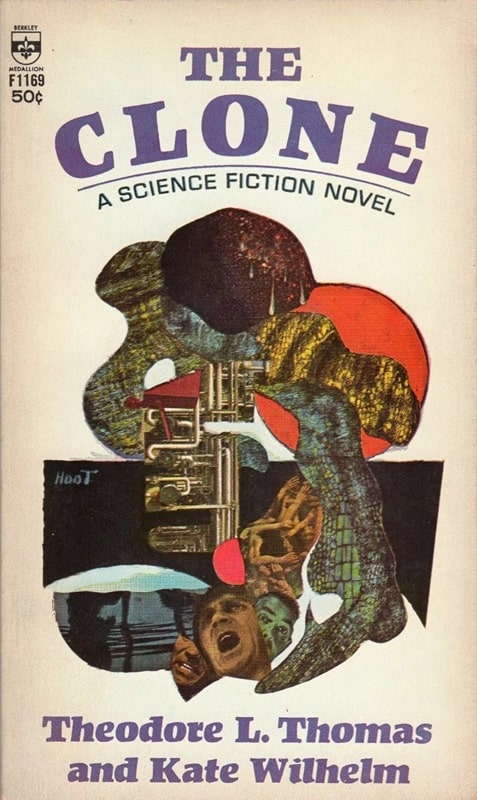
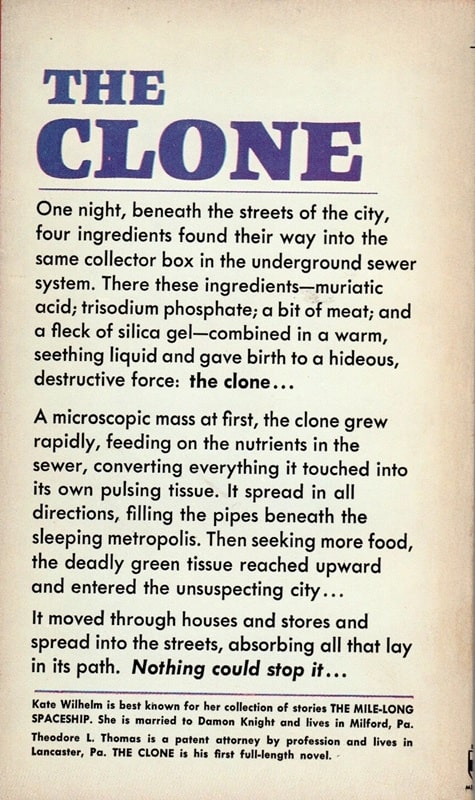
The Clone by Theodore L. Thomas and Kate Wilhelm
(Berkley Medallion, December 1965). Cover by Hoot von Zitzewitz
Theodore L. Thomas (1920-2005) was a chemical engineer and patent attorney who wrote about 50 short stories between 1952 and 1981. He wrote two novels in collaboration with Kate Wilhelm (The Clone and The Year of the Cloud.) He is probably best known still for a series of stories he wrote as “Leonard Lockhard” about science fictional complications with patents — the first two of these in collaboration with fellow patent attorney Charles Harness; and for his story “The Weather Man,” about human control of the weather.
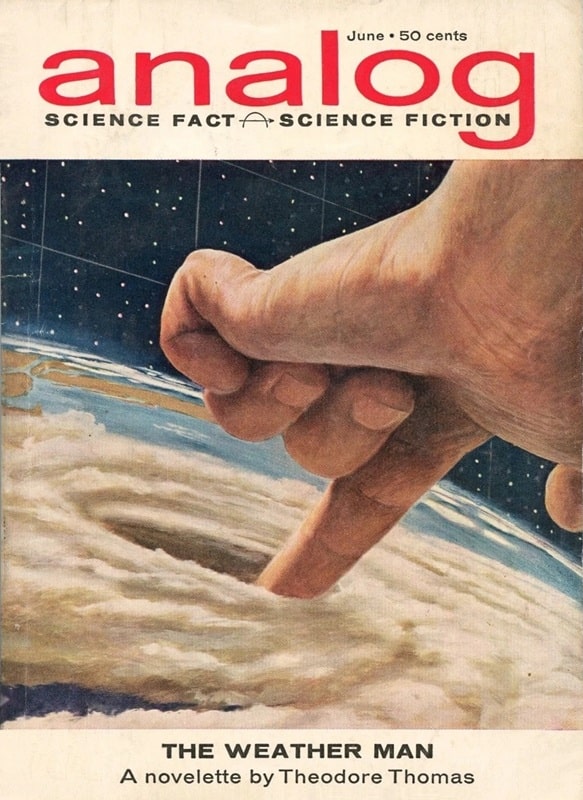 Analog Science Fact/Science Fiction June 1962, containing “The Weather Man” by Theodore L. Thomas. Cover by John Schoenherr
Analog Science Fact/Science Fiction June 1962, containing “The Weather Man” by Theodore L. Thomas. Cover by John Schoenherr
“Passage to Malish” is about a salesman who finds himself diverted from his trip to the planet Malish because it’s been determined that he’s the perfect person to confront the visiting aliens from the Large Magellanic Cloud. The solution involves turning him into a superhuman, committing genocide (or galactocide, I suppose), and then hoping he’ll consent to being turned back to a normal human before he uses his powers to subvert the Milky Way. I never believed any of this story for a second.
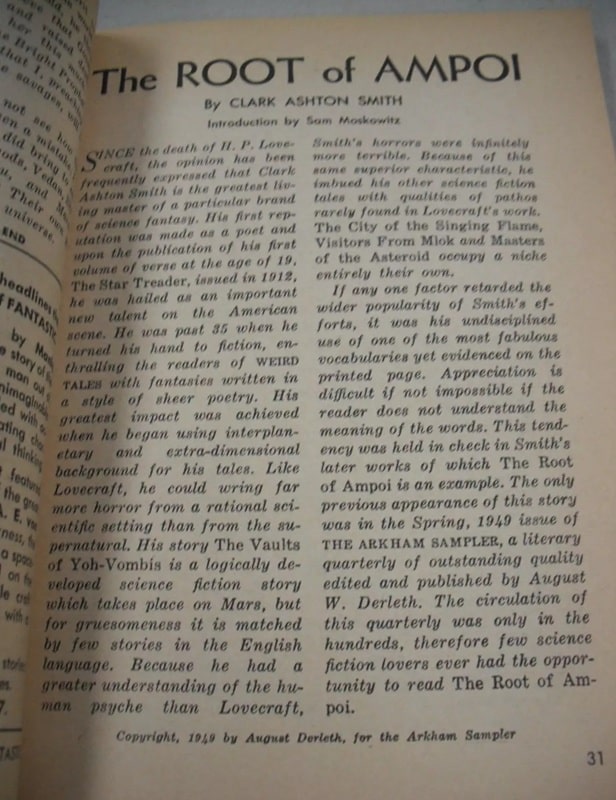
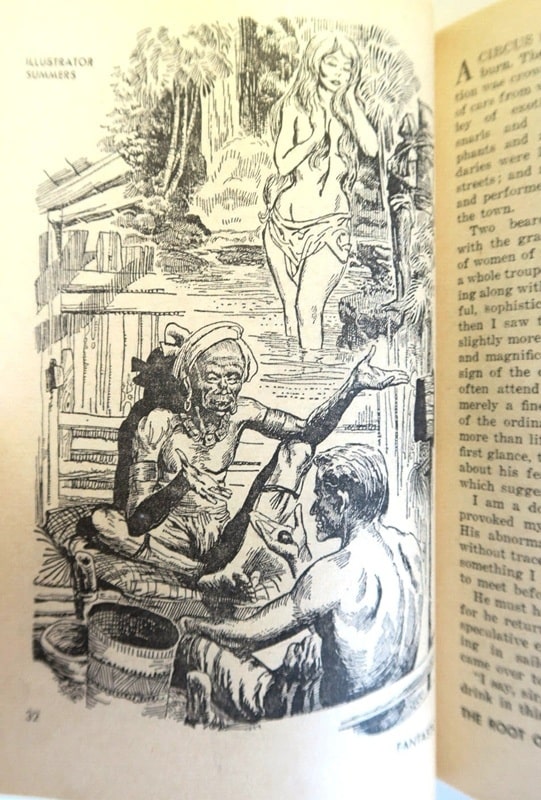
“The Root of Ampoi” by Clark Ashton Smith. Illustration by Summers
“The Root of Ampoi” is Sam Moskowitz’s choice for this month’s fantasy reprint. Clark Ashton Smith (1893-1961) was a poet and a writer of weird fiction whose reputation has gone up and down over time, and seems on the upside now. He was a regular contributor to Weird Tales, and part of Lovecraft’s circle. He was known for his ornate prose and extravagant imagination, so, Moskowitz, with his impeccable as ever taste, declaring in more or less Salieri mode that Smith used “too many words” (that’s my paraphrase of Moskowitz’ words) chose a completely uncharacteristic story to reprint. (That said, it has been reprinted fairly often, one time as “The Ampoi Giant,” so other people may disagree with me.)
“The Root of Ampoi” is a tale told by a giant working for a circus. He was a sailor, and he heard of a place on New Guinea where the men were normal sized and the women were nine feet tall. And there were rubies to be had for a song. Seeking to make his fortune, he finds this place, and learns about the secret that makes the women so tall — after the queen of those women chose him for a consort. But, unhappy with being dominated by a much larger wife, he ferrets out the secret… the punishment for which is banishment. No rubies either. But — easy to find circus work. This is really minor stuff — a competently executed tall tale, really. But it seems nothing like a real introduction to CAS.
Jack Sharkey (1931-1992) was a Cele Goldsmith regular, though to my taste he was a pretty weak writer. “One Small Drawback,” however, is not too bad at its length. Jerry, a college kid, is intrigued by his professor’s research into telekinesis, but nothing he tries has any effect. His professor is convinced that what he needs is true belief. Then something small happens that convinces Jerry he can use telekinesis… but it doesn’t work consistently. The key element he eventually discovers is pretty clever, and effectively dark.
Arthur Porges (1915-2006) wrote over 200 stories, split roughly 50/50 between mystery and SF. His stories were mostly fairly short, and were consistently clever, sometimes amusing, sometimes quite mordant. As a writer of exclusively short fiction, he’s not really widely remembered, but he was one of the most dependably enjoyable writers in the field, and his contributions appeared right up until his death, mostly in F&SF but also in Goldsmith’s magazines. “Report on the Magic Shop” is good solid fun, nothing earth-shattering, written as if the author is telling the editors about the various products sold at a magic shop he happened to stumble into.
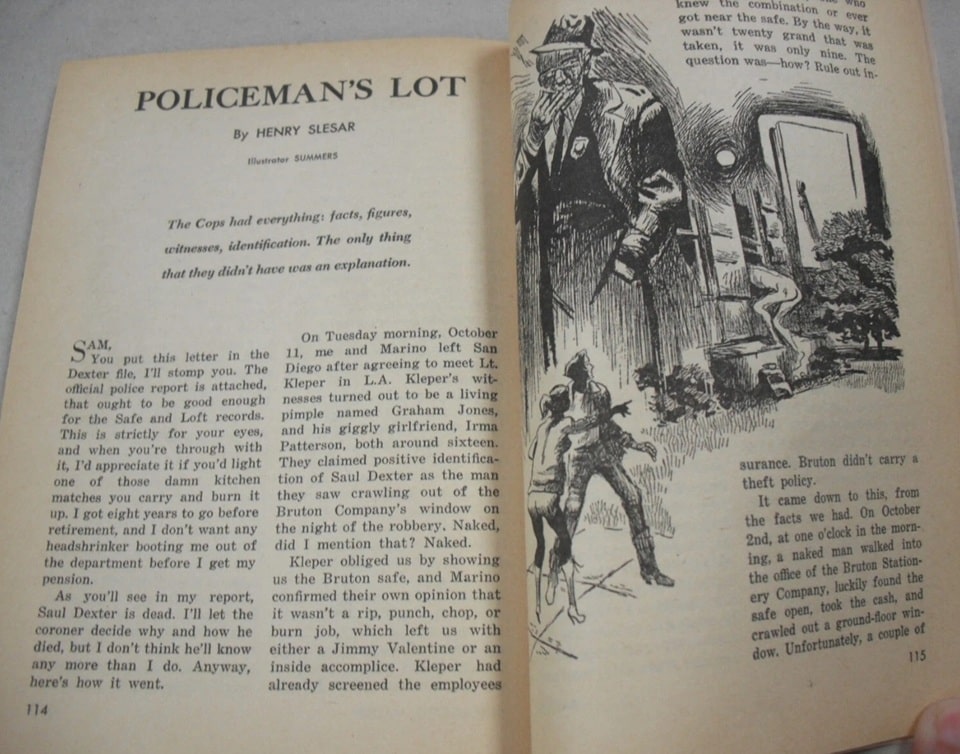 “Policeman’s Lot” by Henry Slesar. Illustration by Summers
“Policeman’s Lot” by Henry Slesar. Illustration by Summers
Henry Slesar (1927-2002) was another writer of both SF and crime fiction, with most of his SF fairly short. He was better known as a mystery writer, and so perhaps it isn’t a surprise that “Policeman’s Lot” is basically a mystery, though with a fantastical solution.
A veteran patrolman submits a report on a strange case he recently investigated, involving a couple of basically “locked room” thefts, in which in one case a man was found escaping from a window naked. Not long after, the man is found crushed to death in his house. The strange factor is that he seems to have changed height between separate arrests. The solution is kind of obvious, and acceptable except as an explanation of his death.
Rich Horton’s last article for us was We Are Missing Important Science Fiction Books. His website is Strange at Ecbatan. Rich has written over 200 articles for Black Gate, see them all here.
Movie of the Week Madness: Duel
Can anyone dispute Steven Spielberg’s title as the most successful motion picture director of all time? Not if you’re talking box office, you can’t. As of June, 2024, Spielberg’s films have grossed almost eleven billion dollars, putting him two billion ahead of his nearest competitor, James Cameron, and as Randy Newman sang, it’s money that matters. In Hollywood that’s probably truer than anywhere else in the world, and the profits generated by Spielberg’s many successes have more than made up for the losses incurred by his rare failures, making the suits very, very happy.
What about recognition from colleagues and critics? He has been nominated nine times for Best Director, winning twice (for Schindler’s List and Saving Private Ryan), and he received another Oscar as the producer of Schindler’s List when that film won Best Picture. He has a star on the Hollywood Walk of Fame (you can step on him at 6801 Hollywood Boulevard), has won the Academy’s prestigious Irving Thalberg Award (are there any awards that aren’t prestigious?), and has received more honors from various cinematic guilds and organizations than can easily be counted.
This storied career had its humble beginning in television in 1969, when Spielberg directed an episode of Rod Serling’s Night Gallery, and through the early 70’s he directed episodes of various other television shows, including the very first episode of Columbo, Murder by the Book. (And yes, I know about Prescription Murder and Ransom for a Dead Man, but technically those are stand-alone TV movies, not episodes of the series.)
And speaking of TV movies, Spielberg also directed three segments of the ABC Movie of the Week, one of which still stands as arguably the best made-for-TV movie ever. I’m talking, of course, about Duel.
The ABC Movie of the Week ran for six seasons between 1969 and 1975, featuring original made-for-television fare from all genres, and the mere thought of the show can make many people of my age fall to the floor in a swoon, regaining consciousness with visions of Barbara Eden dancing in our heads and the scent of Kraft Mac and Cheese lingering in our nostrils. It’s only when we lift our faces from the carpet and see that it isn’t burnt-orange shag that we realize it’s not 1972.
Most of these “world premier” movies ranged from the merely forgettable (Gidget Gets Married) to the utterly schlocky (Satan’s School for Girls) to the absolutely godawful (The Feminist and the Fuzz). In other words, they were nothing to write home about, especially when seen from the distance of half a century (we had far fewer options in the 70’s, so when the trainer threw us a fish we clapped our flippers and snapped it up, fresh or not), but some MOWs were better than that, and at the pinnacle are a bare handful that still hold up, even when viewed with eyes unclouded by cataracts or nostalgia.
None of them stand higher than Duel, which was broadcast on Saturday, November 13, 1971. Directed by a twenty-four-year-old Steven Spielberg and scripted by the great Richard Matheson from his own short story, it’s the rare product of its era that can hit an unsuspecting viewer of today almost as hard as it did its original audience. (I’m sure it’s not a coincidence that Richard Matheson wrote two more of the best ABC MOWs, Trilogy of Terror and The Night Stalker.)
Duel begins in the most prosaic fashion imaginable, with salesman David Mann (Dennis Weaver) backing his red Plymouth Valiant out of his modest suburban garage and heading north for an important meeting with a client; almost all of the first five minutes of the film are through-the-windshield POV shots of the early stages of Mann’s journey. We see him motor up CA 5 through Los Angeles and the San Fernando Valley; eventually traffic thins out as he enters the intermediate region where upper Southern California gradually morphs into lower Central California. Soon almost all other traffic vanishes as Mann leaves the 5 and swings north-east, continuing into the Mojave Desert on smaller, two-lane highways. (Just what he could be selling to anyone in this bleak, post-apocalyptic landscape is never addressed. Geiger counters, maybe?)
It is on an empty stretch of one of these roads that the duel begins, without Mann at first even realizing it. He comes up behind a massive, dirt-encrusted, smoke-spewing tanker truck (a 1957 Peterbilt 281, chosen by Spielberg for its menacing “face”), and not wanting to be late for his meeting, Mann passes it. The truck immediately shows its displeasure by aggressively passing Mann to regain the lead, angrily blowing its horn as it goes by. Increasingly worried about falling behind schedule, Mann repasses the tanker and puts on speed in the hopes of leaving this annoyance behind.
I said the truck shows displeasure rather than the driver because all we ever see of the human operator is part of his left arm (and briefly, his cowboy boots). Nothing else is visible behind the vehicle’s filthy, sun-glared windshield, while the enormous, threatening body of the truck and its “voice” — the bellow of its horn, the roar of its engine, the threatening hiss of its hydraulics — are omnipresent. Turning the truck itself into the antagonist was a deliberate choice by Matheson and Spielberg, making Duel truly a story of Mann vs. Machine.
David soon stops at a service station to get some gas and to call his wife. While he’s still sitting in his car waiting for the attendant (remember those?), the truck pulls in beside him. For a moment, the salesman visibly shrinks back in his seat, fearing trouble, but all he ever sees of the driver, who gets out on the passenger side and stays on the far side of the truck, hidden behind the tank, are his cowboy boots. Soon the attendant shows up and checking under the hood, tells Mann he needs a radiator hose. “I’ll get it later”, David says, and when the attendant replies, “You’re the boss”, Mann mutters under his breath, “Not in my house, I’m not.” (This is what is known as a significant subtext.)
He goes inside and calls his wife, apologizing for an argument they had the night before about an incident that had happened at a party, when a friend apparently got a little too familiar with Mrs. Mann. David’s response to this was not nearly as strong as his wife wanted; the increasingly acrimonious conversation makes it clear that she thinks that her husband is not living up to his responsibility as a protector. The frustrated suburbanite doesn’t think slighting his manhood is fair — “You think I should go out and call Steve Henderson up and challenge him to a fistfight or something!” The call ends with the pair more displeased with each other than when it began.
Angry and humiliated, Mann resumes his drive, and it isn’t long before the truck reappears. The contest is just beginning.
Over the next several miles, the incidents accumulate and escalate until it begins to dawn on Mann that he has left the comfortable, predictable precincts of suburban normalcy behind and entered a raw realm where the only law is survival of the fittest, which is not a place anyone would want to bring a Plymouth Valiant. (Could any model have been more ironically named?)
After leaving the gas station, the truck quickly passes the Valiant, and then keeps the agitated Mann from passing by moving side to side to block him, until an arm extends out of the truck’s window and motions David to pass, which he does… but he has been waved into a head-on collision with an oncoming pickup truck, which he is barely able to avoid. It could not have been an accident. The truck has deliberately tried to kill him.
Soon the tanker is dangerously crowding David, coming up fast from behind, forcing him to increase his speed, until he finally loses control of the car and veers off the highway, coming to a stop after crashing through a wooden fence as the truck roars past. Staggering into a nearby roadside diner, the shaken salesman makes his way into the bathroom, where he slumps over the sink and attempts to recover his composure. In a voice-over, we are privy to Mann’s thoughts, which distill the whole movie into a few lines (Weaver has almost all of Duel’s dialogue, in voice-over or spoken aloud to himself in the car):
Well, you never know. You just never know. You just go along figuring some things don’t change, ever. Like being able to drive on a public highway without somebody trying to murder you… and then one stupid thing happens. Twenty, twenty-five minutes out of your whole life, and all the ropes that kept you hangin’ in there get cut loose. And it’s like, there you are, right back in the jungle again. All right boy, it was a nightmare, but it’s over now. It’s all over.
Walking out of the restroom, Mann looks out of the diner’s wide front window and sees the truck, parked right outside, implacably waiting for him. He’s still in the jungle, and his nightmare is far from over.
Sitting around the room are a half dozen beefy trucker types, and every damn one of them is wearing cowboy boots. Deciding that one heavy-looking fellow sitting in a booth nursing a beer is his tormentor, David walks up and starts remonstrating with the trucker, telling him to stop the harassment and threatening to call the police if he doesn’t.
The Opponents
When the baffled trucker says he has no idea what Mann is talking about, David, who is visibly shaking with tension and anxiety, flares into a rage and slaps the beer out of the man’s hand, provoking the guy to jump out of the booth and beat the crap out of him. When the dazed Mann looks up from the floor, he sees the burly teamster storm out of the diner and climb into… a different truck. A moment later, the tanker pulls out and heads up the road; the driver was never in the diner at all. After a few minutes, Mann leaves the building and follows hopelessly.
The contest continues, as a desperate Mann tries every way he can to bring it to an end.
Trying to speed ahead of the truck in the hopes of getting away doesn’t work — in fact it almost proves fatal when Mann has to stop for a train at a railroad crossing and the truck comes up from behind and tries to push the Valiant into the path of the speeding locomotive. Terrain briefly seems to come to Mann’s rescue when he gets to an uphill grade; seeing his opportunity, David puts on all the speed he can, sending his much lighter vehicle flying up the hill, while maniacally chanting, “You can’t beat me on the grade! You can’t beat me on the grade!!” The grade runs out quickly, however, and Mann is right back where he started.
Calling the police doesn’t work — Mann pulls off at one of those ubiquitous (or they used to be, anyway) desert roadside attractions (visit the Snakearama!) and gets in a phone booth, but before the operator can connect him with the authorities, the truck barrels into the booth and demolishes it, with Mann barely escaping in time. (We see the truck coming; Mann, intent on his call, doesn’t. The timing couldn’t be any narrower, and for a hair-raising instant, we think, “My God, Dennis Weaver is going to get killed making a freakin’ ABC Movie of the Week!!”) The truck then pursues him around the Snakearama lot, casually destroying displays holding snakes and spiders and other nasty Southwest critters. (At one point, David barely avoids being bitten by a rattler and has to knock a tarantula off his leg before scrambling back into his car and fleeing. The once thoroughly-domesticated salesman is truly back in a world red with tooth and claw.)
Parking for an hour and waiting for the truck to leave him behind doesn’t work; his antagonist is waiting for him when he resumes his journey. (Oddly, Mann never considers just turning around and going home. This client he’s going to meet must have a hell of an account. Or maybe he’d just rather face the truck than his wife.)
Flagging down a passing car and asking for help doesn’t work; the nervous, elderly couple that David manages to stop are quickly run off by the truck. (The wife was against getting involved anyway.)
Finally, as the Valiant and the truck are racing down a series of twisty side roads, the inevitable happens — the radiator hose that Mann was warned about blows. The car begins to overheat and the engine starts to thump and shudder, and through blood-smeared lips and teeth (during all the jolting and jouncing he has badly bitten his lip) David Mann ignores the Deity that he likely gave little thought to anyway, back when the biggest trial he faced was mowing the lawn or making a sales pitch. Instead, in the last extremity, he frantically talks to the car itself, pleading, screaming, weeping, begging it for just a little more speed.
Mann gains a little distance when he comes to a place where he is able to coast down one side of a hill while the truck is still climbing the other side, and it is here that the Valiant rolls into a dead end, with the road that the truck will momentarily appear on behind David and a cliff in front of him. This is the end of the line; unless he can think of something, David Mann will be dead in a few minutes. The businessman has been defeated at every point… but in the jungle, the savage knows what to do.
Mann turns the Valiant so that it will be facing the truck when it arrives, and when it does, he finally takes the offensive and drives at the killer head-on. (The way Spielberg shoots the scene makes you think of two jousting knights charging at each other in a tourney.) Jamming the accelerator to the floor with his briefcase, Mann jumps out just before the vehicles collide. The Valiant jams up underneath the front of the truck and explodes; blinded by smoke and flame, the still-faceless driver is unable to brake or downshift rapidly enough to keep the truck from going over the cliff, which it does in slow-motion, with deafening, almost dinosaur-like shrieks and bellows and groans coming from its tortured metal body.
Mann rushes up to the brink, looking down at the wreckage below. He watches as one of the truck’s huge wheels turns slower… and slower… and finally stops. There is no more movement, no more sound. The Monster is dead.
The last paragraph of Richard Matheson’s story describes what happens next:
Then, unexpectedly, emotion came. Not dread, at first, and not regret; not the nausea that followed soon. It was a primeval tumult in the mind: the cry of some ancestral beast above the body of its vanquished foe.
David Mann, civilized, suburban husband and father, the proud possessor of a good job and a nice house and (when the day began) a shiny mid-size American car, shrieks and capers along the edge of a cliff, dancing a frenzied dance of victory, singing a wordless song over the shattered corpse of his adversary.
The last shot of Duel shows Mann sitting on the brink of the chasm, utterly drained, silently tossing pebbles into the abyss as the sun goes down behind him. He will likely sit there all night. What will he do when the sun comes up in the morning? Will he just get up and walk away? Is there anything to go back to?
Certainly, the rising sun will light a different world than it did the morning before, when Mann left his sleeping wife and backed out of his garage, and if he does go back home, I suspect that handsy Steve Henderson had better watch out…
Duel is (forgive me) a smashing piece of work, and after fifty years of achievement at the highest level, it’s still one of the best things that Steven Spielberg has ever done. (Apparently he agrees — he has said that he watches it a couple of times a year.)
First praise goes to Richard Matheson for laying such a solid foundation. His script is all essentials; pared to the bone, it really moves, especially in Duel’s original broadcast version, which ran only seventy-four minutes. (The movie was so successful with the audience and critics that the studio quickly had Matheson write some additional scenes, and Spielberg shot another fifteen minutes so that Duel could get a limited theatrical release.)
The terror springs from the believability of the situation, from its very ordinariness, which was always Matheson’s trademark. (He based Duel on an encounter he actually had with a truck on a California highway on November 22, 1963, the day President Kennedy was shot.) Who hasn’t thought about how isolated and vulnerable we are in our little metal boxes when we’re out in the middle of nowhere? There are times when if civilization is no more than a half-hour away, it might as well be on the far side of the moon, and if we were called on to be our own last resource in a life-or-death situation, how many of us would be up to it?
Then, Steven Spielberg’s direction does full justice to the possibilities in this rich scenario. At twenty-four years old, he already seems a master; there is nothing slack, uncertain, or clumsy, only relentless, constantly escalating tension that’s so perfectly, mercilessly staged that when this harrowing movie is over, you’ll have to take a valium and lie down after wringing out your sweat-soaked clothes.
Because we’re with the story’s protagonist every minute, an extra-large burden is placed on Duel’s leading man, and Dennis Weaver carries that load with ease. He is completely believable in every moment of confusion, frustration, fear, panic, hope, despair and exultation. One false note could have destroyed the whole character, but there are no false notes, and when it’s time to go over the top, Weaver effortlessly carries us over the top with him. It’s a great performance.
Duel has one last excellence that I can’t fail to mention — the stunt driving. The delight of watching a pre-CGI action film with nothing but practical effects is hard to overstate. What with Bullitt, The French Connection, The Rockford Files, Mannix and the countless other police and detective yarns that dominated television and movies in that era, the 60’s and 70’s were the glory years of car chases and car crashes.
Duel is practically an encyclopedia of car stunts (Weaver’s driving double was the great Dale Van Sickel), and the high-speed swerves, skids, fishtails, scrapes and hairbreadth near-misses will have you ducking, flinching, and yelping in a way that the whole Fast and Furious franchise couldn’t manage over the course of ten entire (and entirely silly) movies.
So do yourself a favor — install seat belts on your couch and watch Duel. You’ll experience the pulse-pounding pleasures of terror and savagery and triumph right in the comfort of your own safe and civilized living room, and when it’s over, you’ll thank Richard Matheson, Steven Spielberg, Dennis Weaver, the ABC Movie of the Week and me.
And one more thing — if you plan on ever leaving that living room to venture into the unpredictable world outside, take the advice of someone who once worked in auto service: stop fooling around and get your belts and hoses replaced. Your life may very well depend on it.
 Always Trust Your Gas Station Attendant
Always Trust Your Gas Station Attendant
Thomas Parker is a native Southern Californian and a lifelong science fiction, fantasy, and mystery fan. When not corrupting the next generation as a fourth grade teacher, he collects Roger Corman movies, Silver Age comic books, Ace doubles, and despairing looks from his wife. His last article for us was A Metaphysical Nightmare: Brian Moore’s Cold Heaven
A Sword & Sorcery Series I Really Love: Flashing Swords!, edited by Lin Carter
Flashing Swords! #2, 4, & 5 (Science Fiction Book Club, September 1973, May 1977,
and December 1981). Covers by Frank Frazetta, Gary Viskupic, and Ron Miller
It’s time to take a look at another Sword & Sorcery anthology series I really love: Flashing Swords, edited by Lin Carter. It is second in my affections only to the Swords Against Darkness 5-book series edited by Andy Offutt that I wrote about here last year.
Flashing Swords! came out of the group known as SAGA, which stood for the Swordsmen and Sorcerers Guild of America, a group in the 1970s and 80s that included almost all the elite S&S writers of the age.
They were an informal group but Lin Carter was the closest thing they had to a leader. Under his editorship, five outstanding anthologies of works from their members appeared, all new stories, not reprints. As shown in the pictures below, I have the volumes from Dell paperbacks, as they were originally released, and three from Nelson Doubleday in hardback (above), as they were offered by the Science Fiction Book Club.
[Click the images for flash versions.]
Flashing Swords #1 (Dell, July 1973). Cover by Frank Frazetta
Flashing Swords #1 (1973) has 4 longish stories by Leiber, Vance, Anderson and Carter. All were strong and this is probably the strongest of all the volumes. Anderson’s story, “The Merman’s Children,” is the best, and Carter’s story, “The Higher Heresies of Oolimar,” is one of his strongest ever.
The cover was an awesome Frazetta, one of my favorites of his paintings behind his Kane and Death Dealer art. The volume was dedicated appropriately to Robert E. Howard.
Flashing Swords! #2 (Dell, April 1974). Cover by Frank Frazetta
Flashing Swords #2 (1973) is dedicated to Henry Kuttner. It had four more long stories, by L. Sprague de Camp (with whom Carter had a long history), Michael Moorcock, Andre Norton, and John Jakes.
Moorcock’s story, “The Jade Man’s Eyes,” was of Elric, and Jakes’ story, “Ghouls Garden,” was about his character Brak. I’ll talk more about both authors eventually here but both these tales were very good and I particularly loved the Brak story, which made me seek out more of the tales.
Flashing Swords #1 & 2, UK editions (Mayflower, 1974 and February 1975). Covers by Bruce Pennington
The hardback has a great Frazetta cover, but have a look, too, at the paperback cover from Mayflower books (above), which I found online. I like that one even better than the Frazetta I think, although that sounds almost blasphemous.
Bruce Pennington did it and I wish I had that edition.
Flashing Swords! #3: Wizards and Warriors (Dell, August 1976). Cover by Don Maitz
Flashing Swords #3 (1976) bore a subtitle, Warriors and Wizards. It was dedicated to Clifford Ball. This was the weakest of the five volumes, although still good. It had stories by de Camp, Fritz Leiber, Andre Norton, Carter, and Avram Davidson.
The Leiber story, “The Frost Montreme” — Fafhrd and the Gray Mouser — was the strongest. Don Maitz is the cover artist. It’s good, but a bit less barbaric than I like. Very Renaissance looking.
Flashing Swords! #4: Barbarians and Black Magicians (Dell, November 1977). Cover by Don Maitz
Flashing Swords #4 (1977) is subtitled Barbarians and Black Magicians. This one is dedicated to Norvell Page, who I’ll be covering here. Stories by Vance, Anderson, Jakes (Brak; Storm in a Bottle), Katherine Kurtz, and Moorcock (Elric; “the Lands Beyond the World”).
This one is as strong as the original volume, and I like the hardback cover by Gary Viskupik. It also has some cool interior illos by Rick Bryant. The paperback cover, which I found online, is by Don Maitz again and looks like an Elric representation.
Flashing Swords! #5: Demons and Daggers (Dell, December 1981). Cover by Rich Corben
Flashing Swords #5 (1981) is subtitled Demons and Daggers. No dedication. It has a cool wraparound cover by Ron Miller, although it’s my least favorite of the series. The Dell paperback has a cover by Richard Corben.
Includes stories by Roger Zelazny (a Dilvish tale), C. J. Cherryh, Diane Duane, Tanith Lee, and the first humorous story in the series by Craig Shaw Gardner. I didn’t think it was as strong as #1, #2, or #4, but somewhat better than #3.
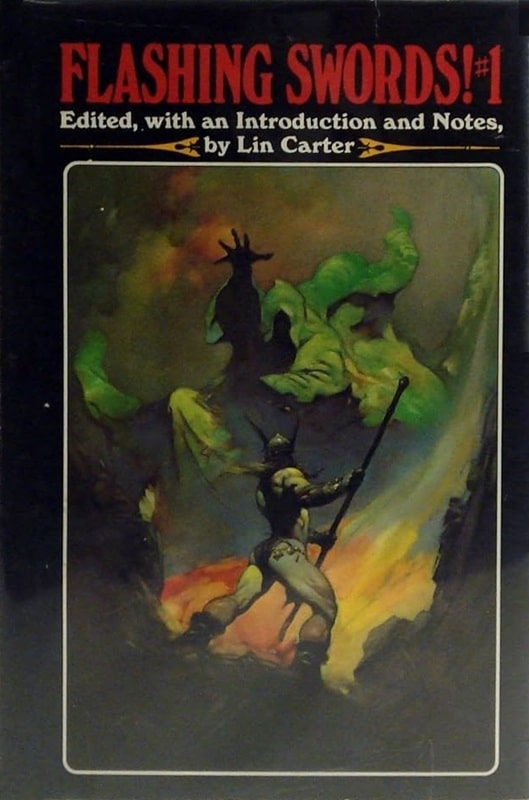
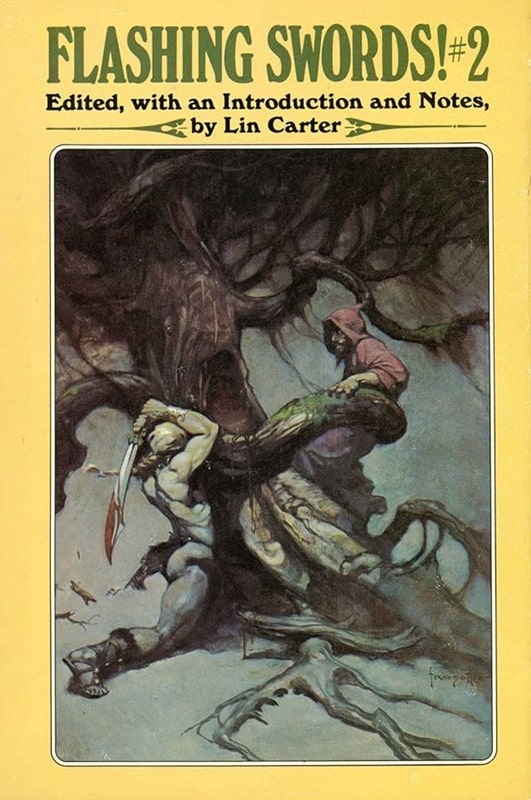
Flashing Swords! #1 & 2 (Science Fiction Book Club, April and September 1973). Covers by Frank Frazetta
In 2020, Robert Price, Lin Carter’s literary executor, revived the series as Lin Carter’s Flashing Swords. There have been two volumes published, although the first one created a minor storm of controversy over the introduction by Price. I have not yet bought or read these two volumes.
I’ve also included above the hardcover covers for volumes 1 and 2 (above), both by Frazetta.
Charles Gramlich administers The Swords & Planet League group on Facebook, where this post first appeared. His last article for Black Gate was Sword & Sorcery on a Post-Apocalyptic Earth: Blackmark by Gil Kane.
Windy City Pulp & Paper 2025 – ‘If Bob Were Here…’
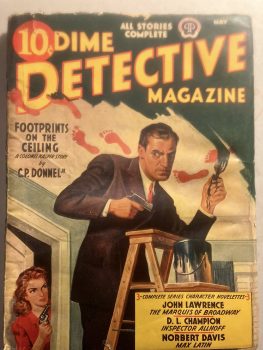
 It’s an early A (Black) Gat in the Hand, as I got my Pulp on week before last, at Windy City, in Chicago.
It’s an early A (Black) Gat in the Hand, as I got my Pulp on week before last, at Windy City, in Chicago.
I managed to resist the impulse to grab the microphone in the Dealers Room and proclaim, “Finally….The Bob…has come back…to Windy City.” A little classic Rock for you there. And in not doing so, I wasn’t evicted and had a great time.
Doug Ellis puts on the Windy City Pulp and Paper Convention annually at the Lombard Westin, in the suburb an hour west of Chicago. I last attended in 2019. Of course, COVID hit in 2020, along with some other life changes. I made it to my first Howard Days in 2022, and headed over to Pittsburgh the last two years for Pulp Fest. Windy City just didn’t quite happen. But I made sure it did in 2025.
There’s an auction, some panels, an art show, and a massive Dealer Room. I’ll share my purchases here in a minute. But hands down, the best part of Windy City for me, is hanging and chatting with people. I see lots of online friends and some folks I’ve met before. I even make new friends. Sort of.
Walking around the Dealer Room and getting into conversations on pulp or paperback favorites is a blast. I find somebody to chat Nero Wolfe, or Jo Gar, or Solar Pons, or Solomon Kane, or Bail Bond Dodd, or…you get the idea. I found myself showing my Civil War shelfie to someone, as they talked about Shelby Foote.
There are always folks sitting around the lobby. I’ve met new friends just sitting down and working into the conversation. Saturday night, Ryan Harvey, Chris Hocking, James Enge, and I, spent over two hours just riffing through movies and writers. Ryan’s knowledge of multiple movie genres is staggering. And what those three knew about movie soundtracks left me soaking it in.
Add in eating a couple meals with friends, and the social aspect of Windy City is hands down my favorite part. As you’ll see, I find things to buy – and I restrain myself every year – but it’s talking about mutual interests at Windy City that is the highlight for me. Glad I made it back. See you there in 2026? Between the ever-present LA Dodgers cab, and a shirt with ‘Byrne’s Pub’ writ large on the back, I’m easy to spot.
What Did I Buy?
Max Latin!You may (or may not) know, I wrote the introduction to Steeger Books’ reissue of the collected Max Latin short stories. Norbert Davis is on my Hardboiled Mt. Rushmore, and the shady private eye Latin, is my favorite work of his. The fact that my intro replaced the last professional piece written by my favorite writer, John D. MacDonald, is awesome. You can read my intro, here at Black Gate.
For $70, I got the May 1942 issue of Dime Detective, containing “Give the Devil His Due.” This was the fifth Latin story, and I am now the proud owner of an original Latin story. There’s also a Marquis of Broadway by John Lawrence in this issue.
Gotta Have Some Howard! Will Oliver on the left. I think Security was trying to find the guy on the right, most of the show. Wait, that’s John Bullard. I stand by what I said…
Will Oliver on the left. I think Security was trying to find the guy on the right, most of the show. Wait, that’s John Bullard. I stand by what I said…
I resisted the impulse to bring home a haul of Robert E. Howard-related books. It’s easy to find more cool stuff to add to my library – even if I already have the stories included. But Robert E. Howard Foundation folks. Bill Cavalier, Paul Herman, and John Bullard were there. And breakfast with John and Paul was a conversational potpourri I won’t soon forget!
Held every June in REH’s hometown of Cross Plain, TX, Howard Days is a terrific gathering of Howard fans from all over the world. I wish I’d been into Howard back when I lived in Austin. Highly recommended weekend.
I met Will Oliver, a really cool guy (when you’re as cool as I am, you are drawn to other cool people. Yeah…) when I was down there. Will just put out an extensively referenced, door-stopper of a biography of Howard. I grabbed a copy directly from Will at the table, which he kindly signed. I am looking forward to digging into this and probably talking about it during this summer’s run of A (Black) Gat in the Hand.
Cool & LamI’ve written about my favorite Erle Stanley Gardner series many times here at Black Gate. But it’s not Perry Mason. I like the do-it-all lawyer, but the mismatched duo of Bertha Cool and Donald Lam easily hold my ESG top spot. You can find all of my Cool and Lam posts here, including the ‘lost’ pilot, with an intro by Gardner himself.
I don’t have quite all the books, and many are falling apart. As in, I’ve had to toss a couple. Those old Dell paperbacks get extremely brittle. I was happy to pick up two replacement copies at just $5 each. If you haven’t read Cool and Lam, you’re missing out on some high quality PI fiction. At least check out my first post on them, which is based on essay I wrote for Black Mask magazine (yeah, I appeared in THE Black Mask!).
The Frederick Nebel Library Grows So, Norbert Davis’s is the third face on my Hardboiled Mt. Rushmore. Frederick Nebel is number two. Nebel was the guy that Joe ‘Cap’ Shaw tapped to slide into Dashiell Hammett’s place when the latter left Black Mask (and the Pulps). My library has a lot of Nebel from Steeger Books, including Cardigan, MacBride and Kennedy, and the under-appreciated Gales & McGill.
So, Norbert Davis’s is the third face on my Hardboiled Mt. Rushmore. Frederick Nebel is number two. Nebel was the guy that Joe ‘Cap’ Shaw tapped to slide into Dashiell Hammett’s place when the latter left Black Mask (and the Pulps). My library has a lot of Nebel from Steeger Books, including Cardigan, MacBride and Kennedy, and the under-appreciated Gales & McGill.
I already had a couple of Nebel’s air adventures from Illinois’ Black Dog Books. But when I saw Tom Roberts with a table at Windy City, I couldn’t resist. I picked up Sky Blazers, plus the three books along the bottom. Also, three more non-Nebels. I have a couple other digital books from Black Dog. Tom is putting out terrific Pulp by a lot of authors who deserve to still be read. And he has some great intros (I’m still trying to con him… I mean, convince him, to let me write one). I’m a fan of Black Dog, and you should check them out.
Sky Blazers/Wolves of the Wind/Flying Freebooters
I’m not into the Air Pulp genre – in fact, I can’t really even discuss it knowledgeably (like THAT ever stops me, as you well know). But I really enjoy Nebel’s Gales & McGill series, just about all of which appeared in Air Stories, I believe.
I now own all six Nebel books from Black Dog. The top three are all air stories, a few with recurring characters. Nebel and Horace McCoy are the only Air Pulps writers I read, and I’m looking forward to more Nebel.
Flame Island and Empire of the Devil are short story collections of exotic tales from the Adventure Pulps. This is another genre I haven’t read much, but with over 600 pages of Nebel, I’ll be working my way through these. Two of the stories were made into films.
Forbidden River – Nebel started out writing Canadian adventures – you know, Mounties and trappers. Forbidden River contains five such stories. Steeger has also put out two collections of these. Nebel was writing Northern adventures when he joined Black Mask.
Roger TorreyI have the excellent short story collection, Bodyguard, in digital. I couldn’t pass up a second Torrey book: this time in print. Torrey wrote in a straight hardboiled style, and he didn’t change at all as the genre moved more towards the Cornell Woolrich or John D. MacDonald style of mysteries. He was also a major alcoholic and became unreliable and of quite variable quality. He died young, still writing for the ‘lesser’ pulps. But when he was good, he was very good, and I’m a Torrey fan.
Norvell Page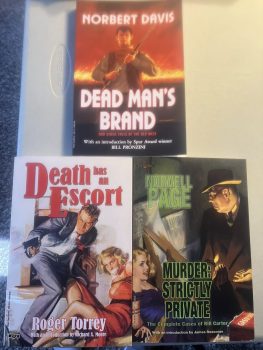 Page is best known as the primary writer of the hero Pulp, The Spider (under the house name, Grant Stockbridge). Like most Pulpsters, he wrote many genres, including weird menace, and G-men stories. I have his limited Western output as a Black Dog e-book.
Page is best known as the primary writer of the hero Pulp, The Spider (under the house name, Grant Stockbridge). Like most Pulpsters, he wrote many genres, including weird menace, and G-men stories. I have his limited Western output as a Black Dog e-book.
I really struggle with the Spicy Pulps. Briefly a popular genre, they’re just so goofy I can’t take them seriously enough to enjoy them. I wrote a post on a Robert E. Howard spicy story – and it was more of a saucy-tinged adventure. Whereas, I can’t even finish a Dan Turner (Hollywood Detective) story
in one -sitting.
Robert Leslie Bellem’s Turner is the most popular of the spicy detectives, even getting his own magazine. But to me, it’s like a parody of Race Williams. And Williams can be hard enough to absorb, without making it a spicy parody.
Page wrote a series of spicy stories featuring Bill Carter (who is not his Weird Menace star, Ken Carter), an investigative reporter in Miami. This volume collects (all?) twenty of them. Page is still kinda over-the-top for me, but these are FAR more readable than the Dan Turner stories. I’ll work my way through this book.
Norbert Davis’ WesternsI already had this in digital, but I couldn’t pass up the print edition. Davis didn’t write many Westerns, but he wrote some damn good ones. I already did this Black Gate post on one of my favorites, “A Gunsmoke Case for Major Cain.” I plan on covering a couple more for the summer Pulp series along the way. I really like his Westerns.
MISCI also picked up a Dell Mapback of Rex Stout’s Tecumseh Fox mystery, Double for Death. I like Mapbacks, and try to pick up one or two when they aren’t too expensive. I got a few Stouts last year at Pulp Fest.
Also, you should definitely attend Windy City next year if you want to play ‘If Bob Were Here.’ To hear something I said repeated back conversationally with “If Bob were here, I bet he would say…” I’m used to being ragged on. To combine it with being ignored is really impressive!
The Art Room

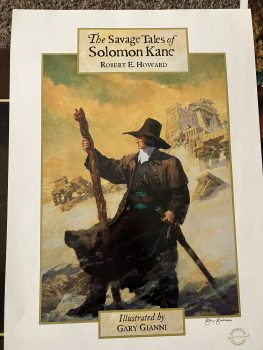 I snapped a few pics of the really cool stuff in the Art Show, but I wish I had been dialed in for it. I would have gotten a lot. The Mark Wheatley, and Gary Gianni stuff, had most of my attention. But there was some neat REH and Edger Rice Burroughs stuff too.
I snapped a few pics of the really cool stuff in the Art Show, but I wish I had been dialed in for it. I would have gotten a lot. The Mark Wheatley, and Gary Gianni stuff, had most of my attention. But there was some neat REH and Edger Rice Burroughs stuff too.
I like this El Borak print by Jim and Ruth Keegan, from the Wandering Star/Del Rey books. There was a cool Solomon Kane pic by Gianni. There was a statue in front of it which it mirrors. I wish I’d taken a close up of it. I will be more focused when I visit the Art Room next time.
Gary Gianni was selling five prints for $30 – signed, at a table. I snagged them! There were four Solomon Kanes – color, and black and white. Also, one larger sized Conan from “A Witch Shall Be Born.”
He chatted with folks and is a super nice guy. I’m friends with Bill Cavalier (well, I don’t think he refutes that statement, anyways) and have met Mark Wheatley and Mark Schulz at Pulp Fest. Robert E. Howard artists have been really nice folks.
THE HOWARD ANDREW JONES PANEL
 A lot of Howard’s friends and fans were at Windy City. There was a panel to remember and celebrate Howard, curated by his biggest fan and supporter, Arin Komins. John O’Neill, James Enge, Seth Lindberg, and John Hocking shared thoughts and memories. Audience members were also offered the opportunity to speak, and Howard’s fellow Black Gaters Ryan Harvey, Greg Mele, and myself, spoke fondly of our missed friend.
A lot of Howard’s friends and fans were at Windy City. There was a panel to remember and celebrate Howard, curated by his biggest fan and supporter, Arin Komins. John O’Neill, James Enge, Seth Lindberg, and John Hocking shared thoughts and memories. Audience members were also offered the opportunity to speak, and Howard’s fellow Black Gaters Ryan Harvey, Greg Mele, and myself, spoke fondly of our missed friend.
Kudos to Doug Ellis for setting aside time for Howard to be front and center. Mentions of him were peppered throughout the weekend among the Black Gate and associated crowd. We will be fondly remembering him for a long time to come.
One audience member came up and talked about helping when Howard was putting together the Harold Lamb collections. And he revealed there were some Lamb stories (four, maybe?) that they didn’t have the rights to, and I think Howard had edited those as well. Would be need to see those added to Howard’s Lamb work.
Jason Waltz – you can believe I took Arin and company to task as they were setting up the books, and there was no Hither Came Conan!
Prior Posts in A (Black) Gat in the Hand
2025 (1)
2024 Series (11)
Will Murray on Dashiell Hammett’s Elusive Glass Key
Ya Gotta Ask – Reprise
Rex Stout’s “The Mother of Invention”
Dime Detective, August, 1941
John D. MacDonald’s “Ring Around the Readhead”
Harboiled Manila – Raoul Whitfield’s Jo Gar
7 Upcoming A (Black) Gat in the Hand Attractions
Paul Cain’s Fast One (my intro)
Dashiell Hammett – The Girl with the Silver Eyes (my intro)
Richard Demming’s Manville Moon
More Thrilling Adventures from REH
Prior Posts in A (Black) Gat in the Hand – 2023 Series (15)
Back Down those Mean Streets in 2023
Will Murray on Hammett Didn’t Write “The Diamond Wager”
Dashiell Hammett – ZigZags of Treachery (my intro)
Ten Pulp Things I Think I Think
Evan Lewis on Cleve Adams
T,T, Flynn’s Mike & Trixie (The ‘Lost Intro’)
John Bullard on REH’s Rough and Ready Clowns of the West – Part I (Breckenridge Elkins)
John Bullard on REH’s Rough and Ready Clowns of the West – Part II
William Patrick Murray on Supernatural Westerns, and Crossing Genres
Erle Stanley Gardner’s ‘Getting Away With Murder (And ‘A Black (Gat)’ turns 100!)
James Reasoner on Robert E. Howard’s Trail Towns of the old West
Frank Schildiner on Solomon Kane
Paul Bishop on The Fists of Robert E. Howard
John Lawrence’s Cass Blue
 Dave Hardy on REH’s El Borak
Dave Hardy on REH’s El Borak
Prior posts in A (Black) Gat in the Hand – 2022 Series (16)
Asimov – Sci Fi Meets the Police Procedural
The Adventures of Christopher London
Weird Menace from Robert E. Howard
Spicy Adventures from Robert E. Howard
Thrilling Adventures from Robert E. Howard
Norbert Davis’ “The Gin Monkey”
Tracer Bullet
Shovel’s Painful Predicament
Back Porch Pulp #1
Wally Conger on ‘The Hollywood Troubleshooter Saga’
Arsenic and Old Lace
David Dodge
Glen Cook’s Garrett, PI
John Leslie’s Key West Private Eye
Back Porch Pulp #2
Norbert Davis’ Max Latin
Prior posts in A (Black) Gat in the Hand – 2021 Series (7 )
The Forgotten Black Masker – Norbert Davis
Appaloosa
A (Black) Gat in the Hand is Back!
Black Mask – March, 1932
Three Gun Terry Mack & Carroll John Daly
Bounty Hunters & Bail Bondsmen
Norbert Davis in Black Mask – Volume 1
Prior posts in A (Black) Gat in the Hand – 2020 Series (21)
Hardboiled May on TCM
Some Hardboiled streaming options
Johnny O’Clock (Dick Powell)
Hardboiled June on TCM
Bullets or Ballots (Humphrey Bogart)
Phililp Marlowe – Private Eye (Powers Boothe)
Cool and Lam
All Through the Night (Bogart)
Dick Powell as Yours Truly, Johnny Dollar
Hardboiled July on TCM
YTJD – The Emily Braddock Matter (John Lund)
Richard Diamond – The Betty Moran Case (Dick Powell)
Bold Venture (Bogart & Bacall)
Hardboiled August on TCM
Norbert Davis – ‘Have one on the House’
with Steven H Silver: C.M. Kornbluth’s Pulp
Norbert Davis – ‘Don’t You Cry for Me’
Talking About Philip Marlowe
Steven H Silver Asks you to Name This Movie
Cajun Hardboiled – Dave Robicheaux
 More Cool & Lam from Hard Case Crime
More Cool & Lam from Hard Case Crime
A (Black) Gat in the Hand – 2019 Series (15)
Back Deck Pulp Returns
A (Black) Gat in the Hand Returns
Will Murray on Doc Savage
Hugh B. Cave’s Peter Kane
Paul Bishop on Lance Spearman
A Man Called Spade
Hard Boiled Holmes
Duane Spurlock on T.T. Flynn
Andrew Salmon on Montreal Noir
Frank Schildiner on The Bad Guys of Pulp
Steve Scott on John D. MacDonald’s ‘Park Falkner’
William Patrick Murray on The Spider
John D. MacDonald & Mickey Spillane
Norbert Davis goes West(ern)
 Bill Crider on The Brass Cupcake
Bill Crider on The Brass Cupcake
A (Black) Gat in the Hand – 2018 Series (32)
George Harmon Coxe
Raoul Whitfield
Some Hard Boiled Anthologies
Frederick Nebel’s Donahue
Thomas Walsh
Black Mask – January, 1935
Norbert Davis’ Ben Shaley
D.L. Champion’s Rex Sackler
Dime Detective – August, 1939
Back Deck Pulp #1
W.T. Ballard’s Bill Lennox
Erle Stanley Gardner’s The Phantom Crook (Ed Jenkins)
Day Keene
Black Mask – October, 1933
Back Deck Pulp #2
Black Mask – Spring, 2017
Erle Stanley Gardner’s ‘The Shrieking Skeleton’
Frank Schildiner’s ‘Max Allen Collins & The Hard Boiled Hero’
 A (Black) Gat in the Hand: William Campbell Gault
A (Black) Gat in the Hand: William Campbell Gault
A (Black) Gat in the Hand: More Cool & Lam From Hard Case Crime
MORE Cool & Lam!!!!
Thomas Parker’s ‘They Shoot Horses, Don’t They?’
Joe Bonadonna’s ‘Hardboiled Film Noir’ (Part One)
Joe Bonadonna’s ‘Hardboiled Film Noir’ (Part Two)
William Patrick Maynard’s ‘The Yellow Peril’
Andrew P Salmon’s ‘Frederick C. Davis’
Rory Gallagher’s ‘Continental Op’
Back Deck Pulp #3
Back Deck Pulp #4
Back Deck Pulp #5
Joe ‘Cap’ Shaw on Writing
Back Deck Pulp #6
The Black Mask Dinner

Bob Byrne’s ‘A (Black) Gat in the Hand’ made its Black Gate debut in 2018 and has returned every summer since.
His ‘The Public Life of Sherlock Holmes’ column ran every Monday morning at Black Gate from March, 2014 through March, 2017. And he irregularly posts on Rex Stout’s gargantuan detective in ‘Nero Wolfe’s Brownstone.’ He is a member of the Praed Street Irregulars, founded www.SolarPons.com (the only website dedicated to the ‘Sherlock Holmes of Praed Street’).
He organized Black Gate’s award-nominated ‘Discovering Robert E. Howard’ series, as well as the award-winning ‘Hither Came Conan’ series. Which is now part of THE Definitive guide to Conan. He also organized 2023’s ‘Talking Tolkien.’
He has contributed stories to The MX Book of New Sherlock Holmes Stories — Parts III, IV, V, VI, XXI, and XXXIII.
He has written introductions for Steeger Books, and appeared in several magazines, including Black Mask, Sherlock Holmes Mystery Magazine, The Strand Magazine, and Sherlock Magazine.
You can definitely ‘experience the Bobness’ at Jason Waltz’s ’24? in 42′ podcast.
Neverwhens: War “On Earth, As it Is in Heaven” — Rebecca Roanhorse’s Mirrored Heavens
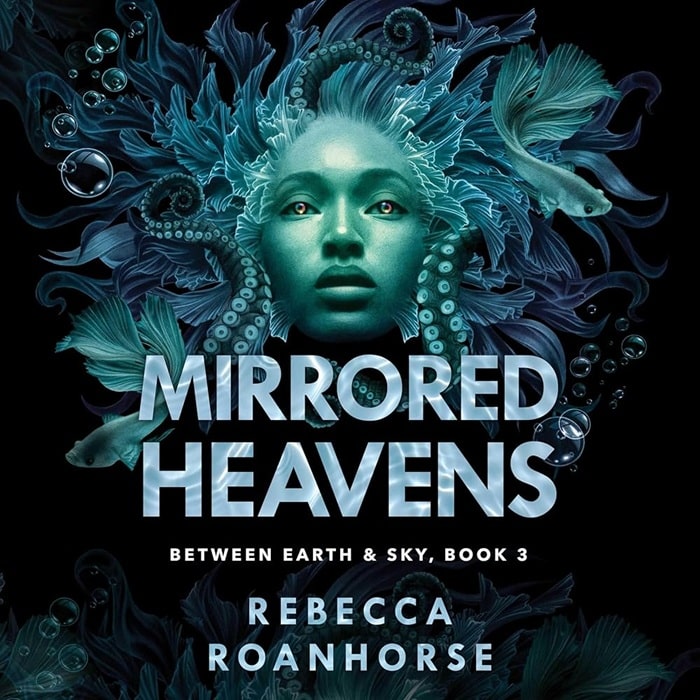 Mirrored Heavens by Rebecca Roanhorse (Saga Press, June 4, 2024)
Mirrored Heavens by Rebecca Roanhorse (Saga Press, June 4, 2024)
Between Earth & Sky has always been about doing something fresh.
Rebecca Roanhorse set out to create an epic fantasy set in a world based on the pre-contact Americas. It has its Maya, Cahokia, Ancestral Puebloan and Woodlands analog cultures; it has a seafaring matriarchy that is a bit Polynesian, a bit Caribbean, a bit “this would be cool.” But the world of The Meridian is its own thing. At times the technology is greater than what existed in our world, it has giant crows, eagles, insects and winged serpents tamed as mounts and its gods are very real, and not particularly benevolent.
But if the world the author sets her fantasy is drawing from cultures underused in fantasy, the story-structure is unique as well. This is not a story of a rising dark lord and the plucky heroes that rise against him. Its villains are all-too-human, motivate by sometimes petty desires, sometimes misplaced love, and if there is a “Dark Lord”, well he is one of the most sympathetic characters in the entire tale.
None of this is inversion for inversion’s sake; it is about telling a compelling, fresh story that feels authentic to the sources that inspired its author, and now it has all come to an end with Mirrored Heavens.
Sticking a landing is always tricky and Roanhorse to some extent set herself a challenging task at the end of Book 2. The mid-book of a trilogy is always a bridge story of revelations and few resolutions, but in Fevered Star we only truly see into the villain’s mind — or even realize his full roll — in the last third of the book. Our two main pairs of heroes: Serapio and Xiala, Narampa and Ixtan, spend the novel separated while the fifth main hero, Okoa, is mostly haplessly dragged from bad decision to bad decision. Things end with the predictable “it’s even worse now”, but other than an epic, beautifully rendered clash between Serapio and Narampa, as respective avatars of the Crow and Sun, in some ways the stage feels unset for resolution in one volume.
That would all be true if Roanhorse was trying to write The Lords of the Rings, pre-Contact Americas style. But she isn’t, and her story isn’t triggered by plot, but by characters. If there is a reveal in Fevered Star it is that all of our main characters, even the villainous Balam, have been motivated by personal relationships, disappointments or love. For all the interplay of ancient gods and prophecies, the story is indeed about Serapio and Xiala, Narampa and Ixtan, Okoa and yes, even evil Balam. It’s about family and isolation, a desire to belong and be loved, or what happens when that instead turns into possessive control. Consequently, to borrow a line from the otherwise wretched The Last Jedi: This isn’t going to go how you think it will.
Reading the above, one might think this is a very literary, slow book. It is not. From the first page there is assassination attempts, blood magic, scary monsters and marching armies. As with the first two volumes, Roanhorse’s prose is tight, sometimes even clipped, and her pages fly by. The summary of our situation: Serapio, now the Carrion King and ruler of Tova, is trying to cement his rule as the Crow clan’s living messiah, and knows that besides the other clans wishing to murder him, the rulership of his own clan has no love for being supplanted by living avatar.
All the other cities of the confederacy are marshalling against him, and he doesn’t even know that the villain behind it all is the man who sent him on his quest — and has been involved in his very creation from the start. He is presented with a prophecy, supposedly from the maw of the trickster god Coyote himself that says that if he slays his “unloved bride” and his father, he can win the three different wars brewing against him, but only by losing everything. What the hell does that mean, and how much further into dark, even cruel, paths will Serapio descend to fulfill it. Indeed — is he even the “good guy” and what is he trying to win?
Okoa, as brother to the Carrion Crow matron, has come to respect and idolize Serapio, but like everyone — fears him. His sister reveals the other clan matrons have learned of a weapon that can slay the Carrion King and demands Okoa’s help.
Narampa feels the power of the Sun growing in her and has fled to the north, to the Graveyard of the Gods — where it is said the gods made war and were “slain”/banished from the mortal world — seeking a shaman who can teach her how to use the mysterious godflesh mushrooms that will allow her to enter the various spirit worlds and fight to liberate her city from the Crow. Only she, too, does not realize Serapio is not the problem…
Ixtan is in the city of Hokaia, adrift and unsure what their path now is, until they learn that Narampa lives and that the southern lord Balam is at the heart of everything. A dangerous thing for a “Priest of Knives” to learn.
Xiala has returned home to the isles of the reclusive Teek. Her mother dead, she should be queen — a role she has run from. But Lord Balam’s agents have come to enslave the Teek, and somehow she has to save her people and find a way back to Serapio to warn him.
Seem like spoilers? That’s where we pick up and in a way that’s all you need to know. The rest of Mirrored Heavens is about how each of these players follows that path, and a revelation of how Lord Balam came to be bent on quest of the cities of the Meridian. The resolution will have blood magic, shadow worlds, a clash between gods, love and definite loss…and it won’t be what you think.
Now, confession: I came close to rating this to four stars because, with so much to resolve and tie up, it is only within the last 70 pages of a 600-page novel that it all starts to come into motion. The final clash is certainly dramatic, maybe almost too much — it feels very much like the final confrontation scene would expect in a Marvel movie, or at least an 80s adventure film. For all of the build-up, Serapio and Narampa are not fated to meet again and, indeed, many characters here fail to understand their role in the story, or make choices that lead to worse, not better, and never do recover from it.
A key to victory comes from an idea introduced about five pages before it is used, which felt contrived. Finally, the more we learn of Lord Balam’s backstory, the less competent he seems, and more like the real-world’s over-privileged billionaires who are interfering in the modern world simply because they can, they have the resources to bully their way in, and because they don’t like being told no. It all felt a bit rushed, and not always fair to the characters we’d been running with for 1600 pages.
Then I read the two final chapters, that serve as epilogues.
As I said at the start of this review, Rebecca Roanhorse isn’t trying to write a “Native American Lord of the Rings“, she is telling her own tale, and when you get to the end it all clicks. Besides tying every loose end, the other choices: a somewhat tragic, almost pointless, death of a main character; the fact that an assassin not only gets away with it, but parleys their actions into more power; the fact that some of the great heroism of a character is never known or understood — yes, that’s how the world works in politics and in war.
The gods are real, yet their ultimate appearance remains vague, unclear, and seemingly uncaring of mortal cost because they are gods — not mortals writ large. There is nothing of the Classical or Judeo-Christian belief to these deities; they are primal and simply are — once they act, mortals are left to reason for themselves what it all means. Scenes that occur off-stage do so because they really tell us nothing about the interplay of the core characters, and that’s what this story has always been about: a small group of players caught in the center of a revenge decades in the making.
Could the end have been a bit longer? Perhaps. Do I still think Lord Balam never really quite works as the chief villain? Somewhat. Is the “secret weapon” introduced just before it is needed… needed. No. But in the end, that doesn’t matter: Mirrored Heavens is ultimately about people and in telling that story, Roanhorse creates a magic and adventure-filled conclusion to one of the freshest epic fantasies I’ve read in years. I am already missing Serapio, Xiala, Ixtan and the rest, and although the story of The Meridian seems complete, Roanhorse mentions a distant western Empire of the Boundless Seas and other lands I’d eagerly visit.
(You can read my review of volume one here: Neverwhens, Where History and Fantasy Collide: Brilliance Gleams Beneath a Black Sun.)
Tubi Dive, Part I
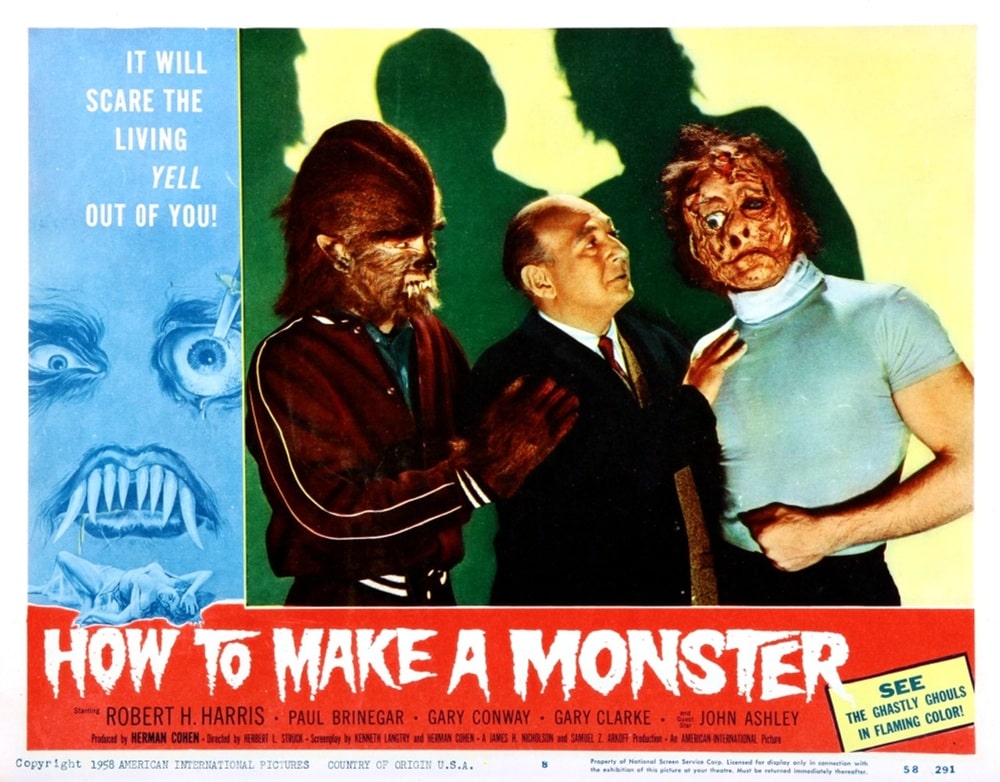 How to Make a Monster ( American International Pictures, July 1, 1958)
How to Make a Monster ( American International Pictures, July 1, 1958)
50 films that I dug up on Tubi.
Enjoy!
How to Make a Monster – 1958, AIPAs a slight deviation from our usual programming of themed lists, here are the results of a deep dive I recently undertook, pushing Tubi to the limits. So here we are with How to make a Monster, a follow-up of sorts to the two spectacular schlock movies, I Was a Teenage Frankenstein and I Was a Teenage Werewolf, both released a year earlier in 1957 from American International Pictures. Monster double-billed with Teenage Caveman (which I previously reviewed when I was on my cave people kick), and is probably my favorite of the film series.
It isn’t your usual narrative, but rather a meta-tale of the studio itself, and I LOVE movies about making movies. In this one, Pete Dumond, the ‘Jack Pierce’ of his day, is the makeup wizard who designed and applied the prosthetics for the two previous films. When he discovers that the studio has been taken over by a company that isn’t interested in monster films, and is subsequently fired, Pete goes on a murderous rampage, only he doesn’t do the killing himself. Instead he brainwashes the young actors playing the monsters via a strange foundation cream (bear with me here) and coerces them to killing the new studio stooges while in full makeup.
Eventually, the cops figure out what is going on, and it all ends up in a rather bonkers and fiery final act. One of the great gimmicks employed here is the final reel being in full colour (a similar stunt was pulled on Teenage Frankenstein), and it’s quite jarring, but in a good way. Fun stuff!
7/10
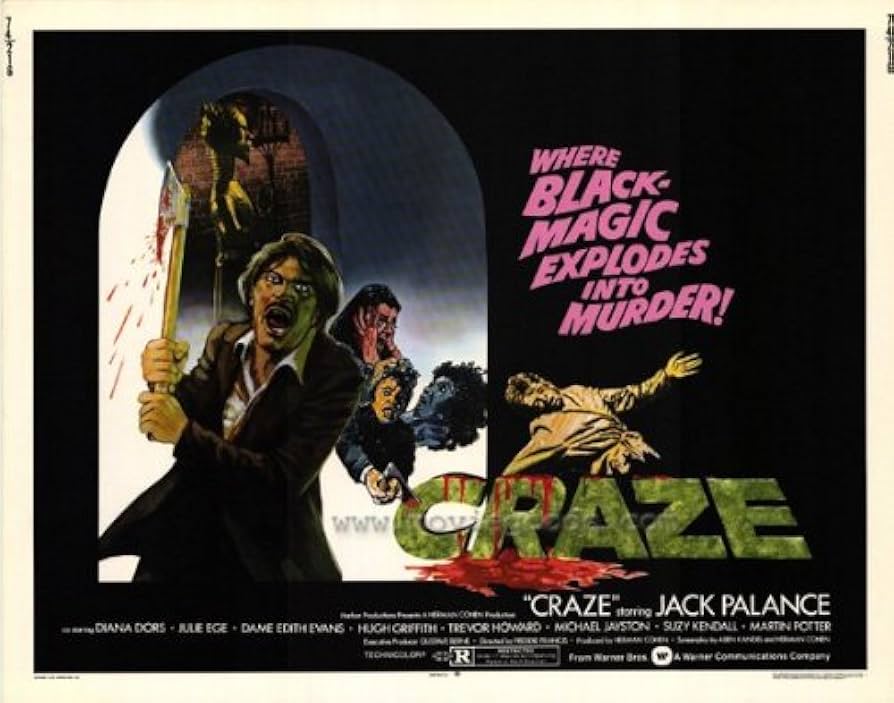 Craze (Warner Bros, June 5, 1974)
Craze (1974)
Craze (Warner Bros, June 5, 1974)
Craze (1974)
A strange little film from one of my favorite directors, Freddie Francis (who hated this one), Craze is based on the novel The Infernal Idol by Henry Seymour. It tells the story of an English antiques dealer who is wrapped up in black magic, and who worships a spooky African idol called Chuku. After a bloody alter, he begins to associate human sacrifices with financial gain (via Chuku), and promptly goes on a murderous spree to keep his idol happy.
Jack Palance is the most unconvincing Englishman ever put on film (until Keanu in Dracula), but he is ably supported by Julie Ege, Diana Dors and Trevor Howard. There are moments that echo the Amicus glory days, however it’s an uneven film, and the version I watched appeared to be edited for ghastliness.
Good if you’re planning a scary idol night.
5/10
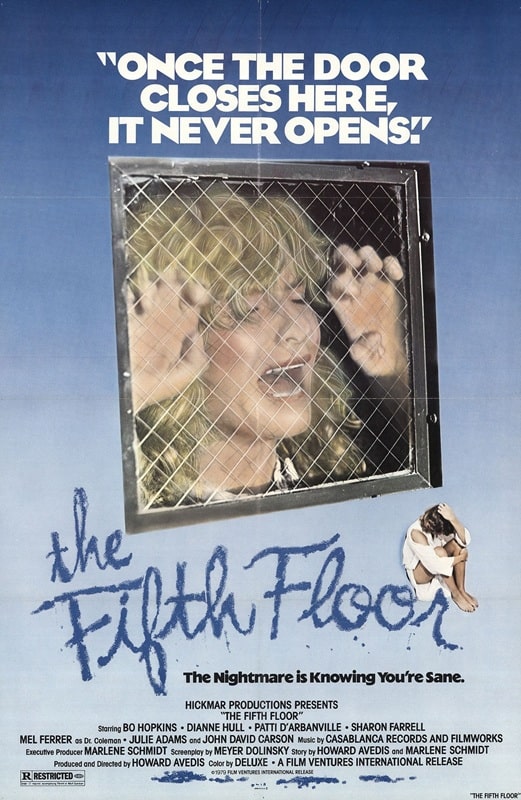

The Fifth Floor (Film Ventures International, November 15, 1978)
and The Boneyard (Zia Film Distribution, June 12, 1991)
Based on a true story, The Fifth Floor is about a young woman, Kelly (played by Diane Hull), who is accidentally poisoned at a disco and is taken to hospital. Her records indicate that she has tried to self harm before at age 15, so she is recommended for psychiatric assessment and care, leading to a three day stay at a facility. She soon runs afoul of a sleazy attendant, and her stay is increased to two-weeks, eventually being drawn out to 60 days. During this time she is abused, both mentally and sexually, and nobody believes her, especially her useless boyfriend.
It’s a pretty run of the mill movie, but the cast is the standout, and makes this an interesting watch. As with One Flew Over the Cuckoo’s Nest, the patients are portrayed by some familiar faces, notably Robert Englund (fresh off telling his roommate to try auditioning for a space movie…), Anthony James (the villain in every TV show and film you ever watched), Earl Boen (who would go on to become a psychiatrist himself in the Terminator films), and Michael Berryman (of course).
The uncaring boss of the facility is played by Mel Ferrer, and the sleazy, abusive orderly is played by none other than Bo Hopkins. Julie Adams plays one of the nurses, so of course this Black Lagoon lover was very happy about that.
Not fun, but I didn’t hate it, which is high praise considering the films I seek out.
5/10
The Boneyard (1991)Here’s an interesting one I hadn’t seen before, and when I say interesting, I mean a bit dull, then utterly barking mad.
Two years before The X-Files gave us Mulder and Scully, The Boneyard gave us Jersey Callum (Ed Nelson) and Alley Oates (Deborah Rose), a detective and psychic respectively, both at the end of their games and leaning against each other for support. A child murder case leads them both to a vast mortuary, run by Phyllis Diller (who totally over-Dillers every scene she’s in). Before you know it the child corpses turn out to be flesh-eating demons, and shenanigans ensue.
Yes, this one is painfully slow to get started, but once it does, it’s a lot of fun. The child demons are quite ghastly and really well made, and it’s a pity the same cannot be said for the two goofy monsters that crop up toward the end. James Cummings was a bit of a makeup legend before he tried his hand at directing, and it showed in the monsters — unfortunately the rest of his direction was really pedestrian.
There are some hilarious moments, some gooey moments, and a poodle moment that would make Ang Lee go off in his pants. Worth a look if you’re feeling brave.
6/10

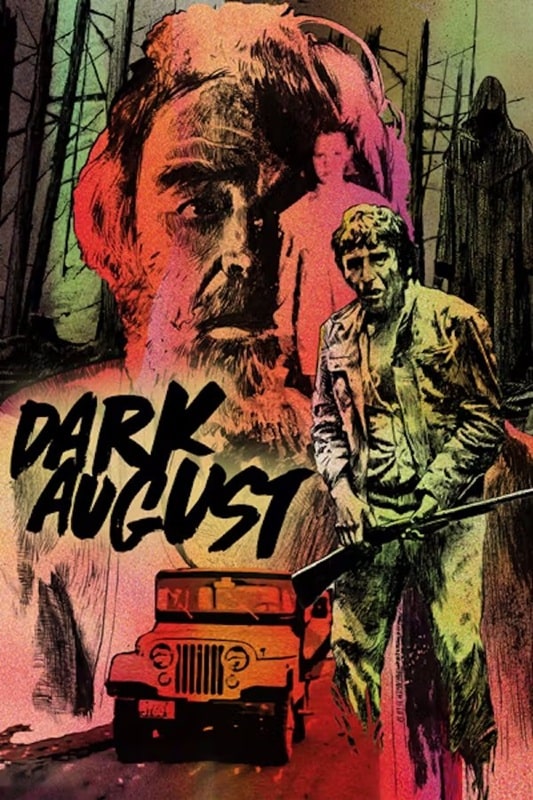
Schizoid (The Cannon Group, September 5, 1980)
and Dark August (Howard Mahler Films, September 10, 1976)
Next up is this non-politically correctly titled slasher from the start of the best decade. Someone is stalking and murdering the members of a therapy group run by the terminally horny Dr. Fales (Kinski).
A newspaper columnist (Marianna Hill) is being sent threatening letters, and the cops (led by Richard Herd) don’t take them seriously. Her creepy ex-husband (Craig Wasson) is more concerned with getting the wallpaper up in his office (!), and Kinski shags everyone.
It’s fine, I guess, except the mystery killer is given away at the beginning. Oh, and Christopher Lloyd is in it, being all weird and sinister, so a bonus point there.
1/10
Dark August (1976)Sal, an artist recently moved from NY to Vermont, doesn’t do a good job of fitting into his new rural life because he immediately runs over a young girl. It’s an accident, but the girl’s spooky grandfather doesn’t see it that way, and proceeds to voodoo Sal up the wazoo.
Creepy apparitions, bloody coughing and tummy aches ensue. It’s a bit slow, but there is a handful of inspired shots. Kim Hunter is in it as a committed medium, so that’s a bonus.
1/10
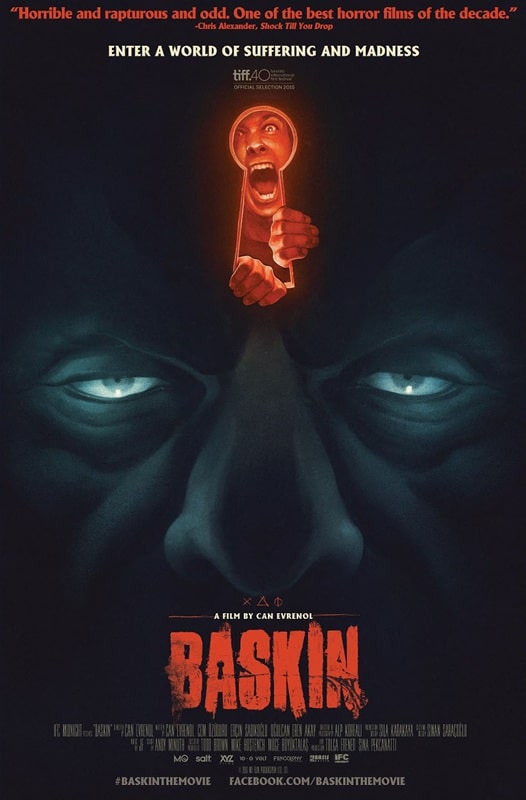 Baskin ()
Baskin (2015, Turkey)
Baskin ()
Baskin (2015, Turkey)
Just five months after the US Thanksgiving celebrations, here is a delicious slice of Turkey, all wrapped up in one hell of a mind-bending horror film.
Baskin is a simple tale about a squad of police officers just mooching about, not doing much, when they get a call to a ‘disturbance’ in a dodgy part of town.
They answer the call, but crash their van along the way and end up at a big old house. The minute they go inside they are confronted by assorted ghastliness, and another officer banging his own head against a wall, and then it all goes rapidly downhill.
They find themselves quite literally in Hell surrounded by writhing masses of flesh and blood, and soon they are in the clutches of a cannibalistic cult, led by an enigmatic and terrifying figure. The sense of dread is astounding, and the film itself is gorgeous, albeit utterly horrific. Its surreal sensibilities put me in mind of Mandy (2018), and its overall sense of doom reminded me of Descent or Dog Soldiers. It’s a bit of a hard watch, and certainly not fun, but it’s worth a watch if you fancy something darker (and stickier) than molasses.
8/10
Previous Murkey Movie surveys from Neil Baker include:
What Possessed You?
Fan of the Cave Bear
There, Wolves
What a Croc
Prehistrionics
Jumping the Shark
Alien Overlords
Biggus Footus
I Like Big Bugs and I Cannot Lie
The Weird, Weird West
Warrior Women Watch-a-thon
Neil Baker’s last article for us was Part III of What Possessed You? Neil spends his days watching dodgy movies, most of them terrible, in the hope that you might be inspired to watch them too. He is often asked why he doesn’t watch ‘proper’ films, and he honestly doesn’t have a good answer. He is an author, illustrator, teacher, and sculptor of turtle exhibits. (AprilMoonBooks.com).
Tor Doubles #1: Arthur C. Clarke’s Meeting with Medusa and Kim Stanley Robinson’s Green Mars
 Meeting with Medusa cover by Vincent di Fate
Meeting with Medusa cover by Vincent di FateGreen Mars cover by Vincent di Fate
Tor Double #1 was originally published in October 1988. This volume marked the beginning of the official Tor Double series. The two stories included, Arthur C. Clarke’s Meeting with Medusa and Kim Stanley Robinson’s novella Green Mars complement each other, although by doing so, Green Mars also points out a weakness of Meeting with Medusa. The volume was published as a tête-bêche, with both covers were painted by Vincent di Fate.
Meeting with Medusa was originally published in Playboy in December, 1971. It was nominated for the Hugo Award and Nebula Award, winning the latter, as well as the Seiun Award.
The novella opens with Captain Howard Falcon commanding a massive airship, the Queen Elizabeth IV, over the Grand Canyon. A collision with a drone camera causes the ship to crash, killing nearly everyone on-board, including the uplifted chimpanzees who served as part of their crew. Although horribly injured in the crash, Falcon survived and spends years regaining his ability to function, eventually returning to his job as a pilot with an audacious plan.
Falcon proposed a mission to fly through Jupiter’s atmosphere. He notes that many probes have been lost in the atmosphere, but believes that he is uniquely qualified for a crewed mission because he can take evasive action if necessary, noting that he was not at the helm when the Queen Elizabeth IV was struck. His proposal seems like a mix of hubris and a need to atone for the loss of the airship. While Falcon’s reasoning may make sense, the decision to fund and permit him to take on the mission seems a little too pat. However, characterization and motivation has never been Clarke’s forte.
Where Clarke excels, and where Meeting with Medusa succeeds, is building a sense of wonder for the reader. Extrapolating from what was known about Jupiter in the years prior to the first flyby, by Pioneer 10 in 1973, Clarke creates an alien world high in the Jovian atmosphere. Buffeted by hurricane force winds, Falcon provides testimony of the miracles of life that are able to exist there, from the enormous and buoyant medusa, named for the tentacles that dangled beneath them, to the ray-like predators that glide through the skies. The size of these creatures, and the requirements for living where they do, mean that Clarke has incorporated aspects of biology that only exist on a small scale on Earth, if at all.
Gardner Dozois commented that Meeting with Medusa “is a bit traveloguish,” but there is more to the story than simply Falcon’s sightseeing through Jupiter’s skies and achieving a sense of closure for the Queen Elizabeth incident. Clarke provides a more specific reason why Falcon may be the right person for the job, but that final revelation feels a little tacked on and Clarke didn’t make full use of it throughout the story.
Forty-five years after its original publication, authors Stephen Baxter, who collaborated with Clarke, and Alastair Reynolds published a sequel to Meeting with Medusa, the novel The Medusa Chronicles, which expanded on the world Clarke described and the character who explored that world.
 Playboy cover by an unknown artist
Playboy cover by an unknown artistAsimov’s Science Fiction Magazine, September 1985, cover by J.K. Potter
The novella Green Mars was originally published in Isaac Asimov’s Science Fiction Magazine in September, 1985 and should not be confused with Robinson’s 1993 novel Green Mars. It was nominated for the Hugo Award and the Nebula Award.
Roger Clayborne, who is around 300 years old, has resigned from his position as Minister of the Interior for Mars, a position he has held for 27 years. A member of the Red Party, which championed the maintenance of Mars in its natural state, he has come to realize that his ideology has lost out to the Greens, who have successfully terraformed Mars to an extent that conserving its pristine nature is no longer possible.
In his own attempt to get back to nature, Clayborne signs on with an expedition to climb Olympus Mons, at 22 kilometers, the tallest mountain in the solar system, with a peak that juts out of the planet’s atmosphere. All expert climbers, including a woman Clayborne knew more than 250 years earlier, the trek up the mountain proves dangerous, between the threat of rockfall, weather, and the thinner Martian atmosphere.
Set over the span of several weeks, Clayborne interacts with nearly all of the other members of the expedition in various ways and the expedition leader, Eileen Monday, makes sure to rotate who partners with whom. With a cast of eleven characters, some do get short shrift (only one of the four “Sherpas” is given a last name and none of them are fleshed out), but Robinson does limn out distinctions between most of the characters, from Marie Whillans’ exuberance to Dougal Burke’s quiet competence. Roger’s interactions often depict part of the story, but Robinson makes clear that there are complex relationships behind the scenes.
Robinson also describes the climb in details, introducing the reader to a variety of concepts used to scale mountains and showing that, even with the relatively gentle slope of Olympus Mons, the ascent is difficult, with a lot of climbing and descending as paths and dead ends are discovered and materials are carefully positioned to ensure the expedition’s chance of success. At the same time, injuries happen and must be dealt with, not always in the most obvious ways.
As Clayborne climbs the mountain, the natural beauty and his discussions with the other climbers slowly begins to make him reconsider what it means to be a Red in a world in which terraforming has already taken hold. By the time he reaches the summit, he comes to a conclusion that he can still work to preserve Mars under what he considers to be less than ideal circumstances, but also understands that a terraformed Mars as a beauty all its own.
Both stories are explorations of strange vistas, with Clarke exploring the atmosphere of Jupiter and raising perceptual questions about both the concept of landscapes and life, introducing cloudbanks that were seen as mountains and massive creatures that lived in the atmosphere, never landing. Robinson presented the different layers of Olympus Mons, drawing parallels between mountains and rock formations on Earth with those on Mars as his climbers made the dangerous ascent. However, while both are explorations into the unknown, Robinson also focused on the relationships between the members of his climbing expedition, while Clarke’s protagonist spends most of the story is solitude. The result of this is that the strength of Robinson’s characters highlights the weakness of Clarke’s characters.
 Steven H Silver is a twenty-time Hugo Award nominee and was the publisher of the Hugo-nominated fanzine Argentus as well as the editor and publisher of ISFiC Press for eight years. He has also edited books for DAW, NESFA Press, and ZNB. His most recent anthology is Alternate Peace and his novel After Hastings was published in 2020. Steven has chaired the first Midwest Construction, Windycon three times, and the SFWA Nebula Conference numerous times. He was programming chair for Chicon 2000 and Vice Chair of Chicon 7.
Steven H Silver is a twenty-time Hugo Award nominee and was the publisher of the Hugo-nominated fanzine Argentus as well as the editor and publisher of ISFiC Press for eight years. He has also edited books for DAW, NESFA Press, and ZNB. His most recent anthology is Alternate Peace and his novel After Hastings was published in 2020. Steven has chaired the first Midwest Construction, Windycon three times, and the SFWA Nebula Conference numerous times. He was programming chair for Chicon 2000 and Vice Chair of Chicon 7.
Goth Chick News Debuts: GalaxyCon’s Nightmare Weekend Invades Chicago, While Haunted America Ectoplasms All Over Alton
It’s been a while since we’ve had the chance to bring you a brand-new convention offering, and in 2025 we’re bringing you two. First up is one of the biggest celebrations of all things spooky, creepy, and downright chilling heading to Chicago for the first time this May. GalaxyCon, the powerhouse of fan events, is bringing its first-ever Nightmare Weekend to the Donald E. Stephens Convention Center in Rosemont, Illinois, from May 2-4, 2025 — and it’s shaping up to be an unforgettable fright fest.
“We’re thrilled to deliver our unique fan experience to Chicago,” says Mike Broder, GalaxyCon’s founder and president. “Our events have brought millions to local economies, and we can’t wait to make a positive impact in this area too.”
Translation? A weekend of scares and a boost to local businesses. Win-win!
Over three days, Nightmare Weekend will transform the convention center into a playground for horror lovers including:
- Over 100 hours of programming: Dive into Q&As, comedy, panels, screenings, gaming, and more.
- Late-night mischief: After-dark cosplay competitions, karaoke, dance parties, and cabaret performances.
- Cosplay galore: Show off your creepiest costumes and compete for glory.
- Tattooing and sinister shopping: Pick up unique merchandise or get inked to commemorate the weekend (will this be the event where I get Chris to go under the needle?).
- And the pièce de résistance? A killer lineup of celebrity guests ready to make your horror-loving heart skip a beat.
Prepare for meet-and-greets, photo ops, and autograph sessions with stars from your favorite films and shows. This year’s nightmare-worthy roster includes:
- Cast members from The Walking Dead
- The hilarious crew of What We Do in the Shadows (that’s a big “Hell yes” from us!)
- Stars of Thanksgiving (because who doesn’t love a horror twist on a holiday?)
- The spellbinding witches of Hocus Pocus
- Icons from slashers like Friday the 13th and Scream VI
- The vampy badasses of From Dusk Till Dawn
Whether you’re a hardcore horror fan or just looking for a fun weekend escape, Nightmare Weekend has something for everyone. Tickets start at just $40 and are available now at GalaxyCon’s website.
Our second new outing comes up a month later in June. The Haunted America Conference is making its spine-chilling return for the 28th year, but covering it is a first for Black Gate Photog Chris Z and I. From June 26-29, 2025, the historic town of Alton, Illinois — often hailed as one of the most haunted small towns in America — will host this legendary gathering at Lewis and Clark Community College.
And before you come for me on this one, we just report what we see for your entertainment. If we only wanted to report facts, we’d go work for the BBC.
Besides, this isn’t your typical fan convention. Founded in 1997 by renowned author and paranormal historian Troy Taylor, the Haunted America Conference offers a deep dive into the world of ghosts, hauntings, and all things unexplained.
Here’s a glimpse of what’s in store:
- Engaging Presentations: Learn from leading experts about spirits, cryptids, UFOs, and other mysteries that lurk in the shadows.
- Hands-On Workshops: Participate in sessions designed to enhance your investigative skills and understanding of the paranormal.
- After-Hours Events: For those brave enough, exclusive nighttime activities delve deeper into the unknown.
- Vendor’s Room: Browse a curated selection of eerie merchandise, from haunted relics to the latest ghost-hunting gear.
Tickets are available now, with general admission granting access to all main events on Friday and Saturday. For a detailed schedule, list of speakers, and ticket information, visit the official Haunted America Conference website.
So, stay tuned. We’ll be saving all the receipts.
A Metaphysical Nightmare: Brian Moore’s Cold Heaven
The Irish writer Brian Moore, who died in 1999 (he pronounced his first name in the Irish fashion — Bree-an) was one of the most interesting novelists of his time, at least based on the four books of his that I’ve read, all of which deal with areas where the supernatural, the philosophical, and the theological intersect and blur into each other.
Catholics (1972) is set in the near future after a hypothetical Fourth Vatican Council has banned private confession, clerical garb, and the Latin mass, while the fictitious Pope of the novel is engaged in negotiating a formal merger of Roman Catholicism and Buddhism, radical changes that are resisted by a handful of monks living on a small island off the coast of Ireland. In The Great Victorian Collection (1975), a scholar dreams of a fabulous collection of Victorian artifacts, and when he wakes up, it has actually appeared in the parking lot outside his California motel room. Who will believe such a thing? Can he believe it himself? Black Robe (1985) is a painstakingly detailed — and bracingly unsentimental — historical novel about the material and spiritual struggles of a Jesuit missionary to the Hurons in seventeenth century Canada.
Cold Heaven (1983) was the first Moore novel I read. That was over thirty years ago, and though the details faded over the decades, I retained a fairly strong memory of the theme and overall shape of the story. The impression that remained the strongest, however, was a feeling of general dislike. Because I very much enjoyed the subsequent Moore novels I read, I’ve often wondered whether my tepid response to Cold Heaven was my own fault; perhaps I just didn’t know how to read the book all those years ago. It was in this frame of mind that I recently reread the novel, reconfirming some of my original impressions and altering others.
Issues of faith and belief are central to all four of these books. Moore was raised a Catholic (and not just any Catholic — an Irish Catholic), though by the time he began his writing career he was no longer a believer. Though faith is a closed issue for most believers and non-believers alike — they’ve just come to different conclusions — for Moore the question is far from settled. Despite his rejection of his religious upbringing, in his books dealing with faith isn’t like picking up a lifeless broom handle — it’s like grabbing a snake. You can never be sure you’ve got a secure hold on it, and you have to adjust your grip constantly, because the thing you’re dealing with is alive, with a will of its own.
Before going any farther, a disclaimer — I am not a Roman Catholic, but I am a Christian, and though I am unable to entirely set aside my philosophical and theological convictions when I read a piece of fiction, I do make a good faith effort to take a writer’s work on his or her own terms. Given the subject of this book, I tried especially hard to assume as “neutral” a position as possible. I will say that Moore didn’t make that easy, which was probably his intention.
Cold Heaven is told (almost) entirely from the point of view of a young American woman in her mid-twenties named Marie Davenport. When the story begins, Marie is on vacation with her physician husband, Alex, in the south of France, where he is attending a medical convention. Marie has decided to leave Alex, an arrogant, controlling, selfish man, for her lover Daniel, whom she has secretly been having an affair with for over a year. Marie hasn’t yet summoned the courage to tell Alex this, however.
Before Marie can bring herself to confront her husband with her decision, Alex is struck by a motor boat while swimming in the Mediterranean and suffers a skull fracture. He is taken unconscious to a hospital, where he dies without ever regaining consciousness.
Things immediately shift from the tragic to the bizarre and inexplicable when Alex’s body disappears from the hospital. Has it just been “misplaced”, or is there something else going on? Marie begins to think the latter when she checks her hotel room and discovers that Alex’s clothing is gone and that someone has used his airline ticket to return to the states. Marie follows and catches up with this person, who turns out to be Alex, very much alive — sort of.
What happened? All Alex knows is that he woke up in the hospital morgue; confused and seized by panic, he fled the hospital and the country. When Marie finds him, he is wildly unstable; sometimes he seems almost normal, but most of the time he swings between combative agitation, and most frightening to Marie, a dull, glassy-eyed affectlessness when he seems little more than a zombie. Physically, his vital signs also go through extreme fluctuations; at times, his pulse and temperature readings are so low as to literally be impossible, and sometimes he seems to again be dead. Alex is apparently helplessly suspended between life and death.
Unwilling to abandon him in this condition, Marie wonders whether her husband is being used to punish her for something that happened a year before, and it is this mysterious event and Marie’s response to it that form the crux of the novel.
Exactly one year before Alex’s accident, Marie had been in Carmel, California for a tryst with Daniel. She had been taking a solitary stroll along the cliffs by the ocean when the figure of a young girl appeared lower down the cliff side, in a spot where it would have been virtually impossible for a person to be. Bathed in an eerie, unearthly light, the girl called Marie by name and told her, “I am your mother. I am the Virgin Immaculate.” She also instructed Marie to tell the priests of this encounter, because that spot must become “a place of pilgrimage.” These pronouncements were immediately followed by lightning and thunder, after which the figure faded away.
Such an experience would startle and discomfit almost anyone, but it especially shakes Marie, and for a very good reason — she’s an atheist who has nothing but hatred and contempt for religion and mistrust and suspicion for religious people.
Marie’s mother was a barely-practicing Catholic and her father wasn’t religious at all. When her mother died, Marie’s father put her into a Catholic boarding school in Montreal simply to have the girl out of his hair. She hated it there and never forgave her father for ignoring her pleas and abandoning her in a place that tried to indoctrinate her in an unwanted faith. (A convent of the same order as the despised school is in Carmel, near the spot where Marie saw the apparition.)
In the year between her experience in California and the disaster in France, Marie has gone about her life as if the vision never happened; not only did she not tell any priests about it, she has never told anyone else, either. She treats this possible encounter with the divine as if it were a shameful, dirty secret.
Alex’s accident and his strange condition coming exactly one year later — can it just be a coincidence? Marie thinks not; she very much fears that she is being punished for her disobedience, and that her husband is a kind of hostage, that through him she is being compelled to obey the apparition’s directions. She finally speaks to a sympathetic member of the Catholic clergy, Monsignor Cassidy, a cautious, commonsense religious bureaucrat who is nevertheless not insensitive to higher things. Marie’s main concern is not to be publicly implicated or involved in any way in this situation, whatever the church decides to do about it.
As Monsignor Cassidy tries to decide how to handle this situation (he would much rather be swimming or on the links) and Alex continues to lurch between extremes, Marie frantically tries to escape something that she can only think of as a trap; seeing herself as a victim of unseen forces, she suspects every word spoken, every action taken by anyone she meets as a move in a sinister chess game, the object of which is to steal her life from her. With a barely suppressed hysteria, she comes to see herself and everyone else in this drama as little more than powerless marionettes.
Her extraordinary dilemma is finally resolved when the apparition appears again, this time to a nun from the nearby convent. (Marie is present when this happens, but rather than see the vision again she closes her eyes, places her hands over her ears, and flings herself face down on the ground.) As the charge has now been “passed on” to someone else (due to Marie’s adamant refusal?), Monsignor Cassidy assures her that he will completely leave her out of the report that he will make to his superiors. She is free to resume her old life on her own terms.
People are sometimes spoken of as “clinging desperately” to belief; throughout the book, Marie has clung desperately to unbelief, and in the end, she has successfully outrun the Hound of Heaven. At one point, she declares (repeating Catholic doctrine, no doubt unintentionally), “a person has a right not to believe.” Monsignor Cassidy agrees: “I think God has let you go.”
It did not take long for me to remember why I felt a vague dislike when I thought of Cold Heaven — the reason is Marie; she’s a difficult character to warm up to, to say the least. We’re in her head for virtually the entire book, and for the whole course of the story, she’s driven by nothing but fear, hatred, anger, resentment, and suspicion that frequently crosses over into outright paranoia. Even if you think that these reactions are entirely understandable and justified, it’s still extremely unpleasant to be locked up with such a person for two hundred and fifty pages.
She’s also a frustrating character because the above-mentioned reactions and attitudes make her, quite literally, stupid. When she talks to the good-humored and reasonable Monsignor Cassidy or the friendly nuns from the convent, her preconceptions about them and her absolute refusal to concede that their worldview might have anything at all going for it, cause her to be almost literally unable to see them, unable to hear them, unable to understand the simplest things that they say to her, unable to extend them the smallest degree of trust or sympathy. (At one point, when she sees a minister in the hospital, she immediately bristles. She knows that there are always ministers around such places, “bothering people.” It never occurs to her that some people may actually want a minister, may benefit from their presence. If she were told that, she would likely stare blankly; the words wouldn’t even register.)
As she avoids the apparition’s directions, so she avoids any uncomfortable question or issue. She never once confronts the fundamental incoherence of her position, that of thinking that her husband is being threatened and that she’s being blackmailed by something that she doesn’t even believe exists. (Most of the time, she reflexively thinks that some unnamed “they” are forcing her to do what she doesn’t want to do. But exactly who are “they?” A golf-playing prelate and some dirt-poor nuns couldn’t be pulling the strings in a cosmic conspiracy, could they?)
We’re not much better off than Marie, because we never get a clear enough view of this struggle to be able to render a judgment on it — Marie seems to be just a recalcitrant piece of rope in a game of tug-of-war, the real nature of which we never understand, because we never know who’s holding the ends of the rope.
On a more down-to earth level, Marie never understands that she’s just like her hated father, who also would admit no impediments whatsoever to living his life precisely the way he wanted. Likewise, she avoids thinking about the irony of being desperate to save her husband… so that she can tell him that she’s leaving him because she never loved him. (After all, isn’t Alex as much a threat to the life Marie wants to live as any apparition?)
Still, despite its frequently infuriating protagonist, simply taken as an intricate, offbeat thriller, Cold Heaven is often a gripping read. If it ultimately feels somewhat unsatisfactory, that may be because of all the issues that are never addressed, the greatest of which is this — Marie “wins”, in that she successfully rejects the call that was placed on her (which, from everything that we can see, was a genuine one, not a dream, not a hallucination)… but in this context, what does winning mean? Has she really won a hard-fought victory, or has she actually suffered a defeat — one that may have eternal consequences?
That’s the question of questions, but a definitive answer to it can’t be given within the bounds of the story that Brian Moore has given us; perhaps one of the things that he was saying in Cold Heaven is that it’s a question that can’t be answered within the bounds of the “story” that we’re all in, this little life that begins in darkness and ends with a blank wall that it’s impossible to see over.
More now than after my first reading, though, I believe that Brian Moore was canny enough a writer to know what questions his book was posing but not answering, and also to know just what kind of impression Marie is likely to make on readers. I do wonder, though, if it might it not have been better to have given her some corner of herself, however small, that was beguiled — “tempted”, even — by the apparition’s call; it certainly would have made her a less strident, more interesting, more nuanced and sympathetic character. Moore almost certainly considered such a strategy, but we must assume that the Cold Heaven that would have resulted from that change is not the Cold Heaven he wanted to write.
In the end, it might be best to regard this odd, ambitious, unsatisfactory yet haunting novel as a sort of metaphysical nightmare. Some of my favorite books fall into this category — The Man Who Was Thursday by G.K. Chesterton, The Unpleasant Profession of Jonathan Hoag by Robert A. Heinlein, The Third Policeman by Flann O’Brien, The Land of Laughs by Jonathan Carroll, The Arabian Nightmare by Robert Irwin, Typewriter in the Sky and Fear by L. Ron Hubbard, The Mysterious Stranger by Mark Twain, UBIK by Philip K. Dick, and Conjure Wife by Fritz Leiber are some outstanding examples.
These are books in which the face of reality is veiled, and more than that, in which there is a strong implication that we can never pierce that veil, not because of any inherent limitations in our perception but because the appearance of things has been consciously contrived to deceive us. Contrived by whom? Ah, now that’s a question…
In a metaphysical nightmare, not only is there a sense that reality is inexplicable and sinister (that it’s somehow fundamentally wrong), but the characters must also have an overpowering feeling that they are trapped in that warped reality with no possibility of escape; that’s the nightmare aspect of the story. (The nightmares are literal in several of the books I mentioned, Fear and The Arabian Nightmare, especially, and even in Cold Heaven, where Marie begins having terrifying dreams after she first sees the apparition.)
Metaphysical nightmares are the very opposite of comforting, and reading one can give you a chill that can’t be dispelled by turning up the thermostat; certainly they’re not stories that you read for reassurance. Is the world really like that, though — are we actually living in a metaphysical nightmare? I don’t think so, but I know some people do. (I have to admit that there are days when it’s difficult to disagree with them.) I do know this, though — in a world like that, options are reduced to just a few: faith, despair, madness, or, as in the case of the triumphantly intransigent Marie Davenport, just lower your head, charge forward in your chosen direction, and whatever you do, avoid asking certain questions.
Thomas Parker is a native Southern Californian and a lifelong science fiction, fantasy, and mystery fan. When not corrupting the next generation as a fourth grade teacher, he collects Roger Corman movies, Silver Age comic books, Ace doubles, and despairing looks from his wife. His last article for us was To Save Your Sanity, Take Steven Leacock’s Nonsense Novels and Call Me in the Morning (or, Why Are Canadians Funny?)
Let People Like Things
 These winged beach rats have opinions. Image by Leila from Pixabay
These winged beach rats have opinions. Image by Leila from Pixabay
Good afterevenmorn!
Once again, there appears to be a lot of talk on the various socials about what is and isn’t good ‘art’ (writing, music and actual art) and who is “cringe” for liking what. Of course, for every declarative “cringe” thing, there is a considerable amount of pushback from the folks who like that thing. Heavens, it’s all so very tiresome.
I know I’ve ranted about this, but the proliferation of this nonsense in the past couple of weeks has inspired to repeat myself. Yet again.
I have variously seen angry rants about Sleep Token (a genre-defying band that enjoyed a meteoric rise in the past couple of years), romance novels, fantasy novels, science fiction novels, horror novels, literary fiction, anything in the Warhammer universe, My Little Pony nonsense (yes, even after all this time), and even someone who decided that it’s cliché, boring and stupid for young women to love horses.
Good lord.
Just let people like things.
I can’t believe I have to say this again in the year two thousand and twenty-five.
 This Canadian cobra chicken is going to make themselves heard, damn it. Image by Lo Age from Pixabay.
This Canadian cobra chicken is going to make themselves heard, damn it. Image by Lo Age from Pixabay.
While this is covering a broad list of things that I saw this week, it is especially pertinent for speculative fiction. So many people in speculative fiction try to make themselves feel better about their preferred genre by being absolutely horrendous to other folks for no other reason than their own enjoyment of a different genre. It’s the dumbest thing I have ever personally witnessed.
Listen, everyone is perhaps a little wound-up at present. Perhaps that’s why some folks are overblowing small, personal tastes and attempting to shame or belittle anyone who happens to think differently. I get it. I’m pretty irritable at present, too. Things are less than fun for most people at the moment. If you find yourself getting irrationally irate at a particular take, I’m going to offer you a plan of action.
Ready? Let’s begin.

So, someone likes something you don’t
Before posting your rebuttal, go through this short checklist:
1. Does their liking something you do not materially affect your life at all?
If their obsession with Warhammer 40K intrudes only on your timeline and not in any other part of your life, your best course of action is to simply scroll past and leave them alone.
Now if it is doing some material, genuine harm to you and your life, then yes, feel free to discuss that. It’s rare, but I absolutely do agree that it does happen, and it should be brought to light. But if the only thing wrong with the thing is that you don’t personally like it, just scroll on.
2. Are you perhaps a little hungry?
Suffering from caffeine or nicotine withdrawal? Hold off publicly berating someone for their tastes in science fiction novels or for enjoying romance. Oh, they’re 20 years late to The Lord of the Rings, and you’re so over it? Go eat something. Have a nap. It’s alright. Everything will be a little better when you wake up.
Baby.
3. Did anyone actually ask you?
Was your opinion requested, or were they just sharing something that was giving them joy? If you were asked, by all means tell them your thoughts. Otherwise, hush. No one asked you. Believe it or not, most people couldn’t care less that you believe Sleep Token “isn’t real metal” and “is so overrated,” for example. I doubt anyone who loves fantasy as a genre cares whether or not you find it “irrelevant” and “without intellectual merit.” No need to reply to that tweet of theirs. Just scroll on. And just like that, you’ve not crushed anyone, or ruined a joyous moment, or put something unnecessarily negative out in the world for no reason but to soothe your own misplaced ire.
I know, I know. You think that it’s just so dorky. And? I don’t agree, but let’s pretend it’s objectively so very nerdy in the worst possible way. So what? Let them be a dork. Even publicly. You needn’t bother yourself with correcting them. After all, if it’s true, they’ll just be ignored, and all sad and alone. You’ll be vindicated without so much as lifting a finger. How lovely. And if they’re not ignored, but find a community 0f like-minded folks, even better. Now you’ll be spared from having to deal with all those dorks. They’ll take care of themselves in their own little corner. Go you.
 This swallow needs the world to know her thoughts. Image by Kev from Pixabay.
This swallow needs the world to know her thoughts. Image by Kev from Pixabay.
Are you struggling to contain your rebuttal? That’s alright. We’ve all been there. Here’s a possible solution: Write it out. Write in your journal. Or on a blog post (waves). Hell, even make it a Twitter thread. Just don’t @ the person who inspired your tirade, or do it as a linked reply or quote. That way you can vent your weaselly black guts out without ruining anyone else’s day. You’ll feel better, and they’ll be blissfully unaware.
We all need to vent sometimes. That’s alright. Do that.
But I do not, never have, and never will understand the impulse to be horrid to someone sharing a thing that brings them joy just because they shared the thing that brought them joy and it doesn’t bring you joy. Let people like things. Even things you don’t like. The world won’t end. I promise.
When S.M. Carrière isn’t brutally killing your favorite characters, she spends her time teaching martial arts, live streaming video games, and cuddling her cat. In other words, she spends her time teaching others to kill, streaming her digital kills, and a cuddling furry murderer. Her most recent titles include Daughters of Britain, Skylark and Human. Her serial The New Haven Incident is free and goes up every Friday on her blog.
Bob’s Books – Shelfie #12 (Douglas Adams)
 Readers of my weekly column (both of you) know that I quite enjoying giving my opinion on a wide range of topics. I’ll cut the normal ten down to six this time, but it’s been two months since I’ve expounded thus. And that’s at least one month too long, right? So…
Readers of my weekly column (both of you) know that I quite enjoying giving my opinion on a wide range of topics. I’ll cut the normal ten down to six this time, but it’s been two months since I’ve expounded thus. And that’s at least one month too long, right? So…
It’s the first shelfie of 2025. There’s a list of the eleven prior installments below.
I have three bookcases of fantasy – of which only a couple are science fiction. I just never got into that genre. I am, however, a HUGE Douglas Adams fan.
And I know that three isn’t a lot – I’ve got well over a thousand mystery books I’m the in-house mystery guy, remember? I’ve got a nice selection of fantasy series’, though.
I’ve got Adams’ five Hitchhiker’s Guide to the Galaxy novels, as well as the lone Hitchhiker’s short story; and Eion Coifer’s good-enough continuation novel, And Another Thing…
I’ve re-read the Hitchhiker’s series several times. It’s always fun. Coifer’s book was okay, but seemed too long and kinda dragged along. I found listening to the audiobook easier than reading it.
I thought the collection of original radio scripts was a VERY cool read. Definitely a worthwhile book for fans of the novels.
Starship Titanic is briefly mentioned in Life, the Universe, and Everything. It was the subject of a video game (which I played, of course), and there was a lightweight book based on the game, written by Monty Python’s Terry Jones. It’s fine. I think Jones himself reads the audiobook, which I’ve listened to.
The Adams biography by Jem Roberts was a pretty informative read. Neil Gaiman’s Don’t Panic is likewise full of neat stuff to know about Adams. I recommend both for fans who want to learn more about Adams.
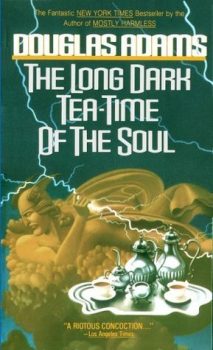 I love the humor in The Hitchhiker’s books, and I’ve even crated a couple entries for it, here at Black Gate (links below).
I love the humor in The Hitchhiker’s books, and I’ve even crated a couple entries for it, here at Black Gate (links below).
But hands down, my favorite Adams book is Dirk Gently’s Holistic Detective Agency. I like the sequel, The Long Dark Tea-Time of the Soul. But I LOVE the first one. It’s a brilliant private eye novel. I’ve read or listened to the audiobook, several times. It may well be in my Top Ten novels list. Adams’ brilliance is on full display.
The Long Dark Tea-Time of the Soul is one of my favorite book titles. The story, which involves Thor and the Norse gods, is good, but a definite step down from the superb first novel. Nonetheless, it’s full of more Dirk Gently, and that’s more than good enough.
The BBC did radio plays of each novel. The first is my favorite radio play of them all, and I’ve easily listened to it a hundred times. They took some story liberties with the sequel, but it’s still a fun listen. I have both as one Audible title, and I listen to both at least two or three times a month – often as I fall asleep. Great cast, special effects: all of it.
There’s an unfinished third Gently novel included in The Salmon of Doubt. Simply put, it’s not very good, and I don’t know that finishing it would have made it much better.
I think Adams and Terry Pratchett were brilliant societal commentators and satirists. And terrific storytellers.
If you’ve never read Dirk Gently, or the Hitchhiker’s series, you’re really missing out on some fun!
And check out my other Adams posts:
Don’t Panic (All Adams posts at Black Gate in one place)
The Public Life of Sherlock Holmes: Don’t Panic!
The Public Life of Sherlock Holmes: Dirk Gently, Holistic Detective
The Public Life of Sherlock Holmes: Stephen Mangan’s Dirk Gently
The Public Life of Sherlock Holmes: The crappy new BBC Dirk Gently Show
What I’ve Been Watching: A (Britbox) December, 2021
What I’ve Been Listening To: September, 2022
What I’ve Been Reading: September, 2022
Bob’s Books – Shelfie #1 (Sherlock Holmes #1)
Bob’s Books – Shelfie #2 (Sherlock Holmes #2)
Bob’s Books – Shelfie #3 (Constitutional Convention of 1787)
Bob’s Books – Shelfie #4 (Thieves World, Heroes in Hell)
Bob’s Books – Shelfie #5 (REH, Moorcock, Kurtz)
Bob’s Books – Shelfie #6 (Cook, LeGuin, Gygax, Hardy, Hendee, Flint, Smith, McKillip)
Bob’s Books – Shelfie #7 (Sherlock Holmes #3)
Bob’s Books – Shelfie #8 (McKiernan, Watt-Evans, Leiber, Bischoff, Rosenberg)
Bob’s Books – Shelfie #9 (Hillerman, Monk)
Bob’s Books – Shelfie #10 (U.S. Civil War)
Bob’s Books – Shelfie #11 (Dashiell Hammett)

Bob Byrne’s ‘A (Black) Gat in the Hand’ made its Black Gate debut in 2018 and has returned every summer since.
His ‘The Public Life of Sherlock Holmes’ column ran every Monday morning at Black Gate from March, 2014 through March, 2017. And he irregularly posts on Rex Stout’s gargantuan detective in ‘Nero Wolfe’s Brownstone.’ He is a member of the Praed Street Irregulars, founded www.SolarPons.com (the only website dedicated to the ‘Sherlock Holmes of Praed Street’).
He organized Black Gate’s award-nominated ‘Discovering Robert E. Howard’ series, as well as the award-winning ‘Hither Came Conan’ series. Which is now part of THE Definitive guide to Conan. He also organized 2023’s ‘Talking Tolkien.’
He has contributed stories to The MX Book of New Sherlock Holmes Stories — Parts III, IV, V, VI, XXI, and XXXIII.
He has written introductions for Steeger Books, and appeared in several magazines, including Black Mask, Sherlock Holmes Mystery Magazine, The Strand Magazine, and Sherlock Magazine.
You can definitely ‘experience the Bobness’ at Jason Waltz’s ’24? in 42′ podcast.
Goth Chick News: Days of the Dead Chicago, Spring Edition
 Days of the Dead Chicago
Days of the Dead Chicago
Fittingly, last week Black Gate photog Chris Z and I attended the Days of the Dead convention in Chicago for our thirteenth year. This is one of our favorite shows as the hotel venue is more intimate and less daunting than some of the mega-conventions, and the celebrities aren’t sequestered behind curtains unless guests pay. Though it is smaller and less frantic, it still attracts an interesting, albeit local crowd, and we never fail to meet memorable people.
Arriving a tad early from our respective day jobs, we kicked off this outing in our standard fashion. It stands to reason that upping our blood alcohol levels before wading in offers some measure of protection from the potential of infection that naturally comes with crowded hotel conference rooms – and it’s so much more fun than antibacterial.
 Kicking off Days of the Dead in standard fashion
Kicking off Days of the Dead in standard fashion
Days of the Dead is a fan-driven horror convention that was established in Indianapolis in 2011 with the aim of creating a welcoming social gathering for horror enthusiasts; moving away from the impersonal “pay-and-go” autograph shows that had become prevalent. The event quickly gained popularity, leading to its expansion into multiple cities across the United States, including Chicago in 2012, Los Angeles, Louisville, Atlanta, and Las Vegas.
The convention’s primary goal is to offer fans an immersive experience, featuring special events tailored specifically for attendees, an active after-hours scene with horror-themed parties, and a diverse guest list that includes celebrities, artists, and independent filmmakers. This approach has set a new standard for what a horror convention weekend can offer.
We had some memorable celebrity chats when DotD came through Chicago in November, but the March show was a tad light on people of interest. To be fair, the Revenge of the Nerds reunion attracted a crowd, but this was mainly due to the other movies the actors had appeared in. So off Chris Z and I went to uncover some new creators to share with you and boy did we hit pay dirt.
 Comic creator Kevin Fitzgerald
New Comic Series – Frankenslaves
Comic creator Kevin Fitzgerald
New Comic Series – Frankenslaves
We couldn’t help but be impressed with a graphic story that picks up precisely where Mary Shelley’s Frankenstein left off, bringing it all the way into the future. Written by brothers Kevin and Matt Fitzgerald, with illustrations and color by Anna Engelbold, this wonderful, satirical comic blends horror, science fiction, and social commentary into a visually striking narrative. We also love it when creators do trailers for comics so check it.
Set in a dystopian future, the story explores a world where corporations and governments have pushed human exploitation to its grotesque limit; literally stitching together ideal workers from various parts of society to create the ultimate labor force: the Frankenslaves. These reanimated, hybrid beings are engineered for obedience and efficiency, stripped of individuality and free will.
At the heart of the comic is a resistance movement that seeks to uncover the truth behind the Frankenslave program and restore humanity to those who’ve been turned into corporate property. With an interesting, gritty art style and sharp dialogue, Frankenslaves critiques consumerism, systemic oppression, and the commodification of people, while raising important questions about identity, autonomy, and rebellion. Dark, weird, and unapologetically provocative, Frankenslaves invites readers to look beneath the surface — and ask who’s really pulling the strings.
I absolutely love the Frankenstein tie-in and the masterful reimagining of the story for a new audience. Thankfully I scored the first three issues at the show (Thank You Kevin!) but am now nail-biting for issue 4. Frankslaves is available for purchase online and where comics are sold.
 Ms. Guzman and her wonderful dollies
Freaky Merlina Dolls
Ms. Guzman and her wonderful dollies
Freaky Merlina Dolls
Let’s be frank – dolls are kind of creepy anyway, but Nohora Guzman’s dolls are definitely freaky. Each little dolly is handmade, meaning no two are alike. Standing 14” tall, the details such as miniature skull embellishments and incredible outfits makes each piece a work of art, and so much more relatable than Barbie. You can adopt your own at Guzman’s Etsy store for around $50.
 Writer/Director Richard Burgin
Fang: The Movie
Writer/Director Richard Burgin
Fang: The Movie
Back at DotD in 2021, we first told you about the indie film Fang. Richard Burgin is the writer and director of this tasty horror flick set in Chicago which at that time was in post-production.
We are thrilled to report that since then, Fang has garnered significant acclaim in the independent film circuit, securing multiple awards and nominations.
Midwest Monster Film Fest (2023)Best Actor: Dylan LaRay
Best Actress: Lynn Lowry
Best Director: Richard Burgin
Best Performance: Dylan LaRay and Lynn Lowry
Best Genre Feature: Richard Burgin and Robert Felker
Received eight nominations and secured one award.
Milwaukee Twisted Dreams FestivalEarned five nominations and won four awards.
In total, Fang achieved 13 film festival awards and received an additional 15 nominations, reflecting Burgin’s strong impact and recognition within the indie horror community.
Check out the trailer and then watch Fang on Amazon Prime Video.
Horror Author John S. McFarland’s The Black Garden and The Mother of CenturiesHorror novel? Check. Historical setting? Check. Deep south mythos? Check and check.
Honestly, there was no way I wasn’t going to fall in love with John S. McFarland’s storytelling given that his tales hit on all my favorite things. McFarland’s short stories have appeared in numerous journals and have been featured in anthologies such as A Treasury of American Horror Stories. His writing has garnered praise from esteemed authors like T.E.D. Klein and Philip Fracassi, with some referring to him as “a great, undiscovered voice in horror fiction.”
 Author John S. McFarland
Author John S. McFarland
In 2010, McFarland published his debut horror novel The Black Garden, which received universal acclaim. The novel is set in the fictional town of Ste. Odile, Missouri, a setting inspired by his family’s deep-rooted connection to the old French Mississippi River town of Ste. Genevieve.
The year is 1882, and Perdita Badon-Reed, a sheltered Boston aesthete, has just made the most momentous decision of her life. Having spurned a respectable suitor, she finds herself on the Mississippi River, steaming toward the strange French Colonial village of Ste. Odile to accept a teaching position at a girl’s academy and pursue her dream of becoming a stone sculptor. Of the many hardships that await her, the one she least expects looms in the form of Orien Bastide, an incubus, who has conducted his seductive and parasitic existence for two millennia. Perdita soon realizes the full horror of Bastide’s intentions, and that she alone has the will to stop him. In order to defeat the treacherous Bastide and save future generations from his predations, Perdita must abandon her personal ambitions, and perhaps her life.
The sequel, The Mother of Centuries, picks up the haunted thread decades later, pulling readers even deeper into the legacy of Ste. Odile’s cursed past.
I’ve only just started reading The Black Garden and I love McFarland’s slow-burn dread-building. You can find it along with The Mother of Centuries as well as McFarland’s other works on Amazon.
Days of the Dead has a full schedule of events in the coming year, all with their own celebrity lineups and vendors, so there’s a chance one is happening near you. Check out:
- Indianapolis: June 13-15
- Phoenix: July 11-13
- Chicago: November 21-23
- Indianapolis: December 5-7
- Las Vegas: January 16-18, 2026
- Atlanta: February 20-22, 2026
What Possessed You? — Part III
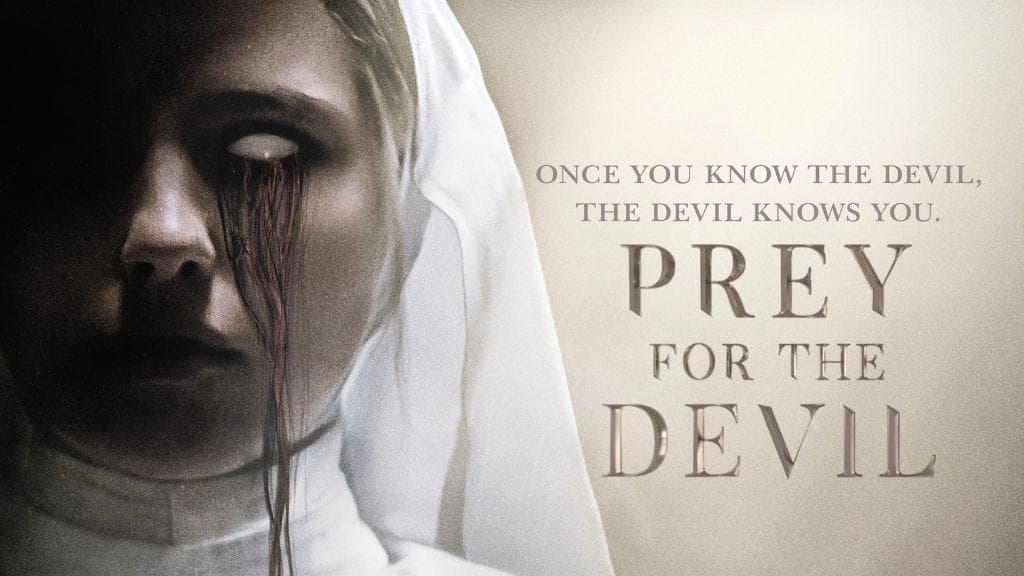 Prey for the Devil (Lionsgate, October 28, 2022)
Prey for the Devil (2022) – Crave (Max)
Prey for the Devil (Lionsgate, October 28, 2022)
Prey for the Devil (2022) – Crave (Max)
Remember how The Hitchhiker’s Guide to the Galaxy‘s entire description of Earth is ‘mostly harmless’? Well, that’s how I’d describe this one. The director, Daniel Stamm, pumped new life into the genre with The Last Exorcism in 2010, but because this film is aiming for that tasty 13+ rating, most of its teeth have been removed.
That said, I liked the idea of the male-dominated world of the church being upended by a nun who has a gift for connecting with possessed patients, and the whole conceit of modern possession running so rampant that the Vatican has set up exorcism training centers is rather fun. Sister Ann is the ‘chosen nun’, stoically played by Jaqueline Byers, and the rest of the cast is great, with Colin Salmon and Ben Cross adding some gravitas to the whole shebang. Sister Ann has quite a few demons of her own to deal with, and it isn’t long before we realize that everything going on in the film is directly for her. There are no surprises here.
There are some genuinely creepy visuals here and there, but Stamm relies too much on jump scares (hampered by the intended rating).
Still, not horrible, but nothing outstanding. Mostly harmless. 6/10
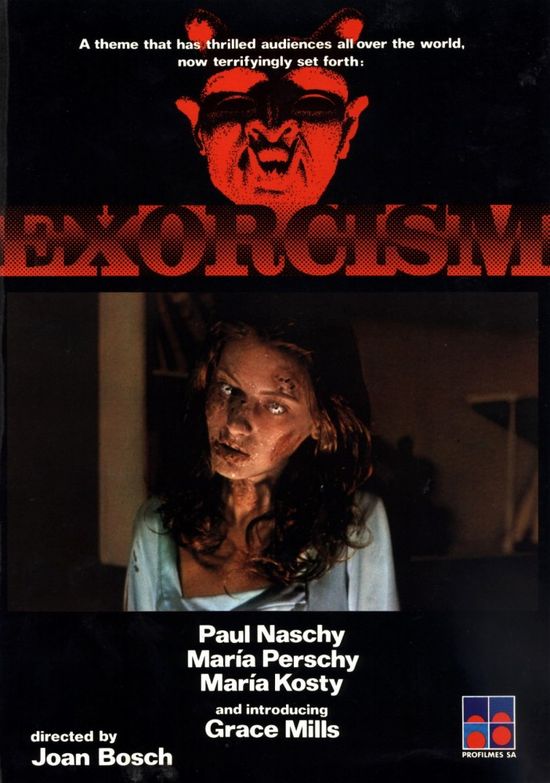
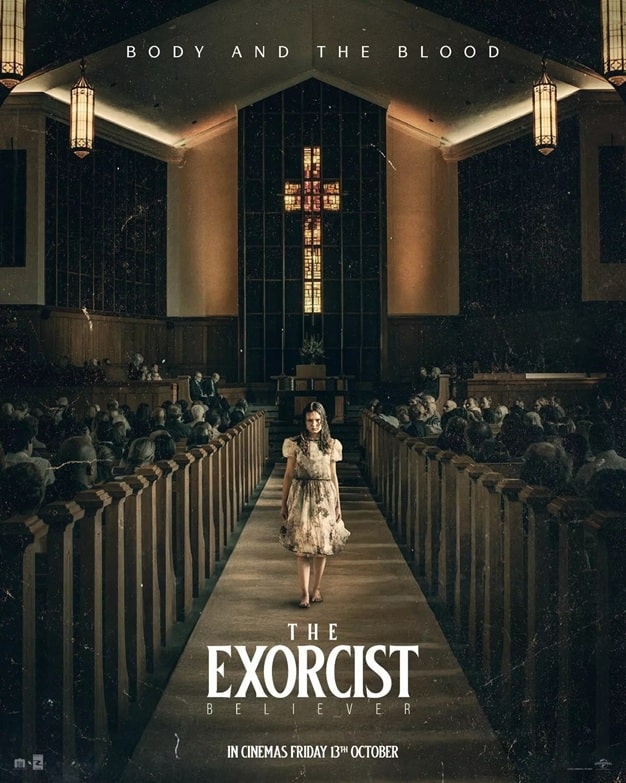
Exorcism (Profilmes, March 10, 1975)
and The Exorcist: Believer (Universal Pictures, October 6, 2023)
The more observant among you will notice that this Spanish production came out two years after The Exorcist, and why not? Priests and pea soup were all the rage back then. Cunningly, Exorcismo was released in Spain *before* The Exorcist, thus making Friedkin and Blatty look like a couple of rip-off artists.
This one stars fan-favourite Paul Naschy as pipe-smoking priest, Father Dunning, a laid-back man of the cloth who has had brushes with Old Nick in the past. Naschy is a dead ringer for John Belushi in this film, and I do enjoy watching him when he is playing a good guy.
Story-wise, some hairy hippies get satanic in a cave, and this leads to a young woman, Leila (played well by Grace Mills), eventually getting possessed by the demonic spirit of her dead dad. It’s a bit of a slow burn to get to the actual exorcism (which takes place in the last 10 mins), as the film takes a giallo turn with a plethora of grisly murders (real head-turners), a pervy chauffeur, African voodoo, and fingers pointed everywhere except at Leila.
Eventually, it’s up to Dunning to confront the possessed woman and do his thing.
There are plenty of obvious Exorcist influences in the film, with a few similar scenes, but this one is fun to watch due to hilarious dubbing (couldn’t find a streaming Spanish version) and copious bosoms.
Trigger warning for dog lovers — there is a good boy called Borg in this film, and his assimilation does not go smoothly. 6/10
The Exorcist: Believer (2023) – PrimeWe’ve reach the much maligned attempt to reboot the ‘Exorverse’ using the team that had some hit and miss success with the new Halloween trilogy.
Having watched it, I can understand the scorn poured upon it.
It’s the age-old possession tale, but this time there’s two! Therein lies the problem. Despite the use of Tubular Bells, and the shoehorning of some old favourites, this has as much to do with the original film as any old bit of guff you might find on Tubi (Exorcist: Vengeance, Exorcist: The Awakening, Exorcist: Butter Sculpture, etc). In lieu of actually focusing on an exorcist, you might think the film would focus on the ‘believer’ of the title, but it’s hard to pin down who that is supposed to be. The film is coded for the principal protagonist to be Tony, played well by Leslie Odom Jr., but he is actually an unbeliever, until it becomes necessary for him to start thinking all the mumbo jumbo is true. This could have been an awesome film if it just focused on him and his lack of belief, and his need to find faith to save his daughter, but the film is stuffed full with other bland characters, diluting the story.
As for the demonic girls themselves, I didn’t like the makeup, but some of the effects were quite interesting.
I was bored until the last 30 mins, and even then the number of useless folks standing around during the actual ‘exorcism’ weakened it to the point where I wasn’t invested in any of the characters.
I felt for young Regan. I couldn’t care less about this bunch. 4/10


Jessabelle (Lionsgate, November 7, 2014)
and Ghostwatch (BBC, October 31, 1992)
Here’s a glimpse into the alchemy that goes into me writing these nonsense reviews. I found a couple of Blumhouse productions; both 90 mins long, one starring Sidney Sweeney (Nocturne) and one starring Sarah Snook (this one — spoiler alert). I watched both trailers to get a sense of which one I wanted to watch, and as intrigued as I was by the Nocturne storyline, it really felt like it was aimed at the Euphoria audience, not a crusty musty old fart like me.
So here we are.
Jessabelle is the story of a young woman who loses her boyfriend, her baby, and the temporary use of her legs in a car crash, and ends up having to live with her estranged father on a vast and soggy tract of land in Louisiana. Jessie (Snook, brilliant) never met her mother, who died from cancer shortly after she was born, but while rummaging around her deceased mom’s bedroom (her new room), she finds a stack of video tapes, addressed to her from her dead mom. Naturally, she plays one, and mom gets downright spooky with a taped tarot reading — from that point on it’s Haitian shenanigans ahoy as a potentially malevolent spirit starts getting all up in her wheelchair. It’s a solidly made film with excellent performances, and my only gripe is with the denouement, which is spewed out like Sherlock Holmes after a line of Afghan fairy dust.
Still, it’s a decent effort, and lands on the ‘good’ side of the Blumhouse production legacy. 7/10
Ghostwatch (1992) – PrimeHere’s the weird thing. I have no recollection of the hysteria caused by this mockumentary, and in fact I’ve never seen it before (although I was aware of it). I wonder if it coincided with a Halloween party I threw with my then landlord in Wimbledon. Anyhoo, folks seem to like it a lot, so I had to take a look.
I suspect non-Brits get more of a kick out of this film than us limeys who grew up watching these real-life presenters. Parky was an inspired choice to host it, as he was already a well-respected interviewer, and his Yorkshireness would not put up with any bull.
Sarah Greene was the first crush of many youngsters during her time on Blue Peter, and she is definitely the MVP in this. Mike Smith was a bit of a potato, and Craig Charles was hilarious — he elicited the biggest laugh out of me when he manhandled the trick-or-treater at the end.
The rest of the cast was fair to middling, but they can be forgiven for any stilted deliveries due to the fact that this was, of course, basically a television play.
I did like the story, and was surprised how dark it really got toward the end. Also, the occasional flashes of ‘Pipes’ reflected in doors and mirrors was excellent, and really added to the atmosphere. A fun watch. 8/10

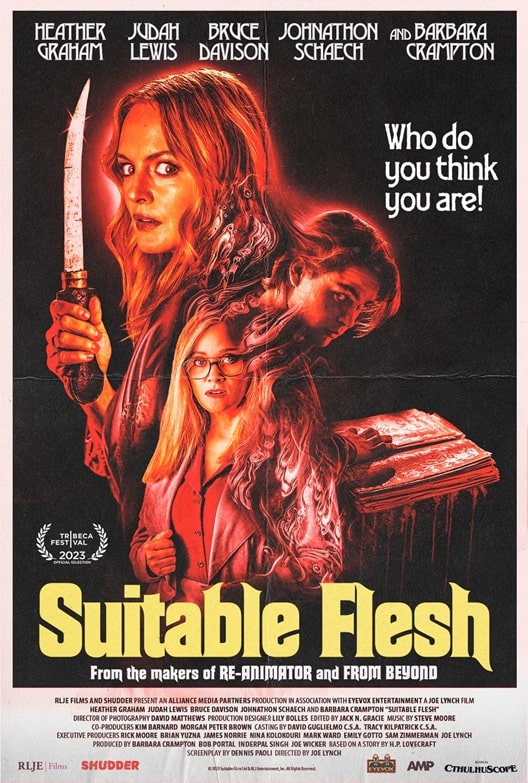
Verónica (Sony Pictures International, August 25, 2017)
and Suitable Flesh (RLJE Films/Shudder, October 27, 2023)
My penultimate film is Verónica, a Spanish film directed by Paco Plaza (REC and REC 2, Sister Death) loosely based on a true event in which a girl died after after performing a séance at a school in Madrid with her friends. Plaza keeps the film grounded enough for the truth to be ambiguous — did the spooky stuff happen, or was it all in her head?
Either way, he has constructed an effectively chilling story, beautifully shot and wonderfully acted. The lead, Sandra Escacena, is excellent as Verónica, and her young siblings are portrayed by some of the best child actors I’ve ever seen. Truly believable, and cute as a button, which makes the ongoing threat to them even more distressing. After the séance, Verónica begins to suspect that an evil entity has possessed the house (or possibly herself), and we are witness to her unravelling over a nightmare-riddled three days. The mom is mostly absent due to wok, so 14-yr-old Verónica must assume all of her duties, plus survive middle school. It’s an awful situation, and your heart bleeds for their family.
The supernatural elements were creepy and unsettling, and only relied on jump scares once or twice — the rest of the horror comes from the pervasive sense of doom. Great stuff. 8/10
Suitable Flesh (2023) – Prime/AMC+I showed great restraint in waiting to watch this one, as I really like Joe Lynch as a director (Wrong Turn: Dead End, Mayhem), Dennis Paoli (Re-Animator, Dagon, From Beyond) returned to write it, and it stars Barbara Crampton, who seems to be eternal.
Bottom line — I loved it. I thought Lynch really nailed the 80s Lovecraft adaptation aesthetic, down to the score, the dutch-angles, the cheesy one-liners and the excessive gore. Heather Graham was perfect as Dr. Beth Derby, a psychiatrist who becomes entangled in the life of a disturbed young man, Asa Waite, played well by Judah Lewis. It isn’t long before she is thoroughly on the road to madness (is it madness though? Aha!), and much murder and body-swapping ensues.
Lynch peppers the film with stunning set-pieces (my favourite being the rear camera shots on the car), and enough erotica to make the puritanical Lovecraft quite queasy (H.P. sauce, if you will). The Old Ones among you will notice some familiar names and locations (Miskatonic among them), and it will soon be apparent this is an adaptation of a favourite HPL story, ‘The Thing on the Doorstep.’
Some relocation and gender-swapping has taken place in the retelling, and this is perfectly in line with the film’s theme. In fact, Lynch and Paoli have also managed to sneak some other pertinent themes in, not least of which is the importance of female body autonomy.
A glorious way to finish this watch-a-thon. 9/10
Previous Murkey Movie surveys from Neil Baker include:
What Possessed You? — Part I
What Possessed You? — Part II
Fan of the Cave Bear
There, Wolves
What a Croc
Prehistrionics
Jumping the Shark
Alien Overlords
Biggus Footus
I Like Big Bugs and I Cannot Lie
The Weird, Weird West
Warrior Women Watch-a-thon
Neil Baker’s last article for us was Part II of What Possessed You? Neil spends his days watching dodgy movies, most of them terrible, in the hope that you might be inspired to watch them too. He is often asked why he doesn’t watch ‘proper’ films, and he honestly doesn’t have a good answer. He is an author, illustrator, teacher, and sculptor of turtle exhibits. (AprilMoonBooks.com).
Tor Doubles: #0: Keith Laumer’s The Other Sky and The House in November
 The Other Sky cover by Thomas Kidd
The Other Sky cover by Thomas KiddThe House in November cover by Mike Embden
Between October and December of 1969, Keith Laumer’s novella The Seeds of Gonyl were published as a serial in the magazine Worlds of If. The story was published the following year in a hardcover by G.P. Putnam & Sons under the title The House in November, and in 1971 as a paperback by Berkley Medallion.
In 1981, Tor reprinted the novel as part of its “Jim Baen Presents” series, but, apparently deeming the novel too short, it paired it with Laumer’s story “The Further Sky,” which had originally be published in the December 1964 issue of Amazing Stories. That story had also undergone a name change and appeared as “The Other Sky” in various reprints, including its appearance with The House in November.
When Tor Books reprinted the volume in 1985, they included a shield on the cover identifying the book as a “Tor Double.” This book may possibly have been created as a dry run or proof of concept for the eventual Tor Double line. The cover for The Other Sky was provided by Thomas Kidd and the cover for The House in November was provided by Mike Embden, although their credits are reversed on the copyright pages.
“The Other Sky” opens with Vallant having a run-in with the Niss, an alien race that is working in collaboration with humans, although immediately after, he finds an old man in his apartment. The stranger not only claims to have been one of Vallant’s comrades several years earlier (although Vallant has no memory of the man or the situation he describes), but also warns Vallant against the Niss before disappearing through a secret panel in Vallant’s apartment.
When Vallant tries to follow the old man, who discovers he has been killed by the Niss, but he also finds himself taking responsibility for Jimper, an intelligent creature. Jimper confirms what the old man had told Vallant about the Niss, but takes it a step further, claiming to be an ambassador from the King of Galliale to the Humans to form an alliance against the Niss.
Vallant and Jimper flee and find themselves among Jimper’s people on Pluto, although Jimper is not greeted in the manner in which he expects. Although neither Vallant or Jimper understand what is happening, either with the humans, the Niss, or the Gaillialans, Laumer has left enough clues that the reader has a pretty good idea what must happen for all of the pieces to come together. The addition of a portal to another world only helps seal the deal.
However, the quick sequential scenes don’t allow Laumer to fully build the characters or their situations, giving “The Other Sky” the feeling of an outline for a longer work, which means the story is ultimately disappointing and unsuccessful.
For a modern reader, Jimper’s manner of speaking in the third person has the same cadences as J.K. Rowling’s house-elf, Dobby, which bring images to mind as the novel progresses which may not be fair or accurate to Laumer’s portrayal.
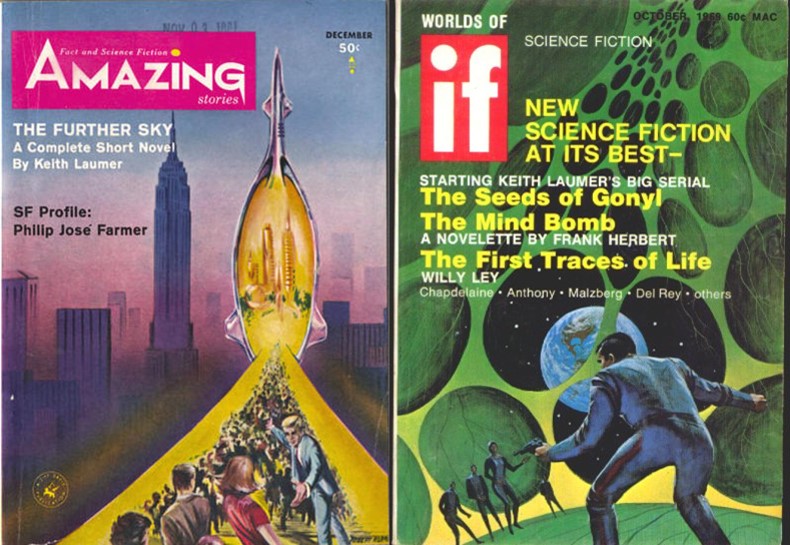 Amazing Stories cover by Robert Adragna
Amazing Stories cover by Robert AdragnaWorlds of If cover by Jack Gaughan
The House in November follows Jeff Mallory through a post-war Nebraskan landscape, although the nature of the war is ill defined. At the beginning of the novel, Mallory is awaking from a fugue state. Although he has memories of working in the Miller Building, his wife, Gillian, insists they both work in the Star Tower. In addition, Gillian has no recollection of their oldest child, Lori, or a house in the country where they have spent their time. Leaving he house, he discovers that everyone in town seems to live in the same alternative world Gillian exists in and he flees into the countryside.
As he travels, Jeff discovers that there has been some kind of invasion which has depopulated most of the United States. He comes across small bands of refugees, most of whom are not hospitable t a stranger, although along his travels he connects with Sally, one of his daughter Lori’s friends, and they travel together, eventually finding an ersatz army but together by Colonel Strang. Lori appears to be supporting Strang’s army, and Jeff finds himself impressed into service.
Strang is convinced that the Chinese have invaded the United States and set up their base in Beatrice, the town where Jeff has been living. Nothing Jeff can say will make Strang believe that there are Americans still living in Beatrice and there are no Chinese. Eventually going AWOL, Jeff finds others who are convinced the invasion is from Satanic minions. Jeff is positive the invasion is by aliens, based on what he saw in Beatrice before he left. Although Laumer could have played up Jeff’s paranoia, making the reader question Jeff’s conclusions, The House in November is written in a way that makes the reader side with Jeff against any other theories, all of them as bereft of evidence as any of the others.
Eventually, Jeff does learn what is going on and the reader discovers that for all his normalcy, Jeff is not a normal person. He is, in many ways, the Chosen One, which may ultimately allow him to break through the haze that has settled on so many people and show them the truth of the situation, and possibly even find a solution.
Much of The House in November is episodic in nature and Laumer doesn’t spend too much time exploring any of the episodes. He gets out of Beatrice as quickly as possible at the beginning of the book. The scene in which he finds Sally living with a few survivors is over almost as soon as it starts. His encounter with Colonel Strang’s army, including Lori, exists to give him an idea of how different people’s ideas are, but he quickly leaves them behind and manages to avoid capture by Strang’s forces looking for him. Other scenes are similarly brief, which gives the story a rushed and unfinished feel, as if any of these sequences, or characters, could and should have been fleshed out more than they were.
The novella only finds its pacing when Jeff arrives at the titular house and comes into contact with Gonyl, who may be able to provide him with the answers he seeks. Having set up the world, Laumer is now able to explain to Jeff and to the reader what is happening and why Jeff was able to come out of the stupor in which he found himself.
Both stories in this volume suffer from pacing issue, both of them almost feeling as if they are outlines for more detailed novels. Laumer has elected to include several short scenes which hint at the larger concern, failing to fully flesh them out and never quite connecting with the readers, who never really had a chance to immerse themselves in the action. Both stories are tales of invasion by alien forces which are not fully understood by the people who have fallen under the alien’s control.
 Steven H Silver is a twenty-time Hugo Award nominee and was the publisher of the Hugo-nominated fanzine Argentus as well as the editor and publisher of ISFiC Press for eight years. He has also edited books for DAW, NESFA Press, and ZNB. His most recent anthology is Alternate Peace and his novel After Hastings was published in 2020. Steven has chaired the first Midwest Construction, Windycon three times, and the SFWA Nebula Conference numerous times. He was programming chair for Chicon 2000 and Vice Chair of Chicon 7.
Steven H Silver is a twenty-time Hugo Award nominee and was the publisher of the Hugo-nominated fanzine Argentus as well as the editor and publisher of ISFiC Press for eight years. He has also edited books for DAW, NESFA Press, and ZNB. His most recent anthology is Alternate Peace and his novel After Hastings was published in 2020. Steven has chaired the first Midwest Construction, Windycon three times, and the SFWA Nebula Conference numerous times. He was programming chair for Chicon 2000 and Vice Chair of Chicon 7.
A Lot of Camelot: The Bright Sword by Lev Grossman
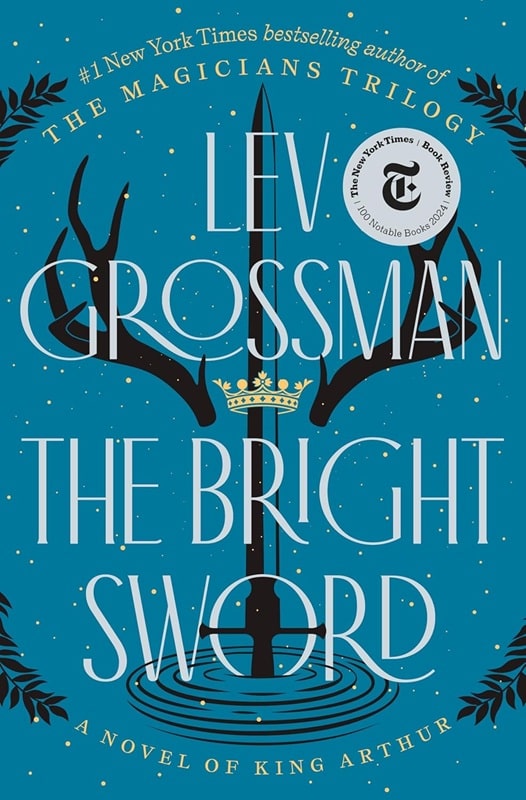
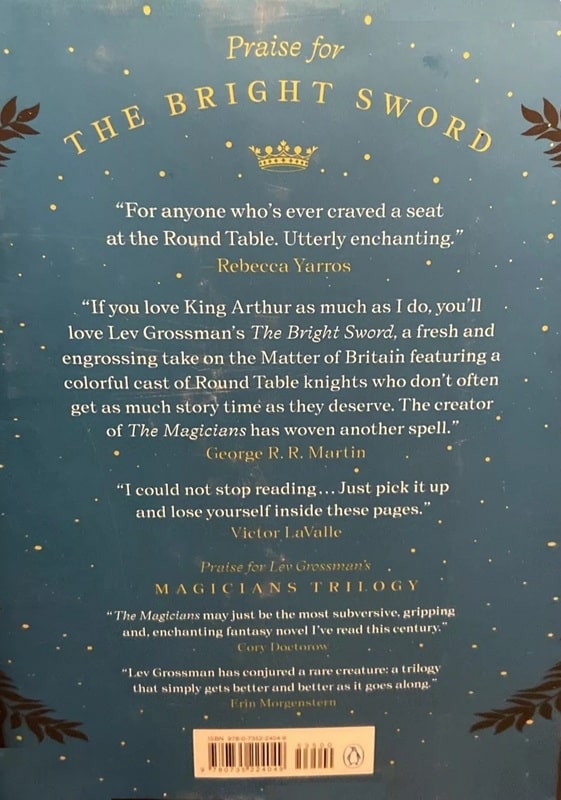
The Bright Sword (Viking, July 16, 2024)
With no disrespect to J.R.R Tolkien, the King Arthur legend is arguably the inspiration of much post World War II medieval-based fantasy. You’ve got your out-of-nowhere claimant to the throne, a magic sword, court intrigue, some side stories, romance, sorcery, betrayal but yet a kind of redemption. All the key ingredients.
Sure, Game of Thrones was based on the very real English Wars of the Roses, particularly the also very real violence and death of key personages. But let’s look at the long literary tradition of Arthurian stories: sourced from Welsh mythology and grafted into 12th century British histories more based on fancy than fact, eventually becoming the Chrétien de Troyes romances and subsequently Thomas Malory’s Le Morte d’Arthur. From multiple sources and variations we wind our way through Tennyson’s The Lady of Shallot which in turn inspires various associated fictions, not the least of which includes Mark Twain’s A Connecticut Yankee in King Arthur’s Court.
Fast forward to T.H. White’s The Once and Future King and its adaption by Lerner and Loewe musical Camelot (“If ever I would leave you, it wouldn’t be in summer…”). With the assassination of John F. Kennedy, Camelot became a metaphor for “a shining moment” intervened by fate to extinguish, that nonetheless, like the Christ-like resurrection grafted on to the Arthurian mythos, may inspire future generations. (Only a cynic would make comparisons between Guenevere’s infidelity and Kennedy’s.)
So while the Arthurian narrative is heavily played out by the middle of the 20th century, there’s still more to come. An extermely short list includes Thomas Berger’s Arthur Rex, The Warlord Chronicles by Bernard Cornwall and, of course, the Monty Python and the Holy Grail movie (inspired in part by the academically disputed contention of Python member Terry Jones that Chaucer’s The Knight’s Tale was actually a satire of a mythical chivalric code and courtly love rather than a celebration of it).
One of my particular favorites is Lavie Tidhar’s By Force Alone, a political satire in which Arthur is a gang lord, Lancelot a martial arts practitioner, no one is noble of heart, and Arthur’s death is instead of a Christ-like hope for resurrection a comment on the existential insignificance and intransigence of power.
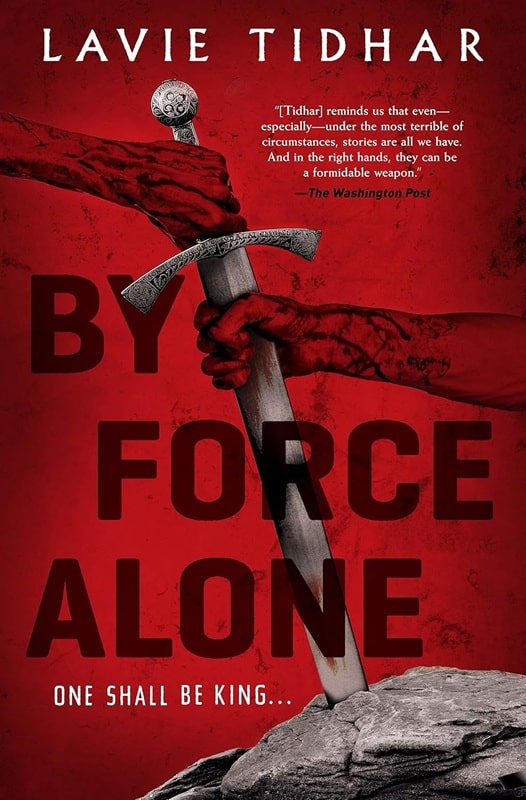
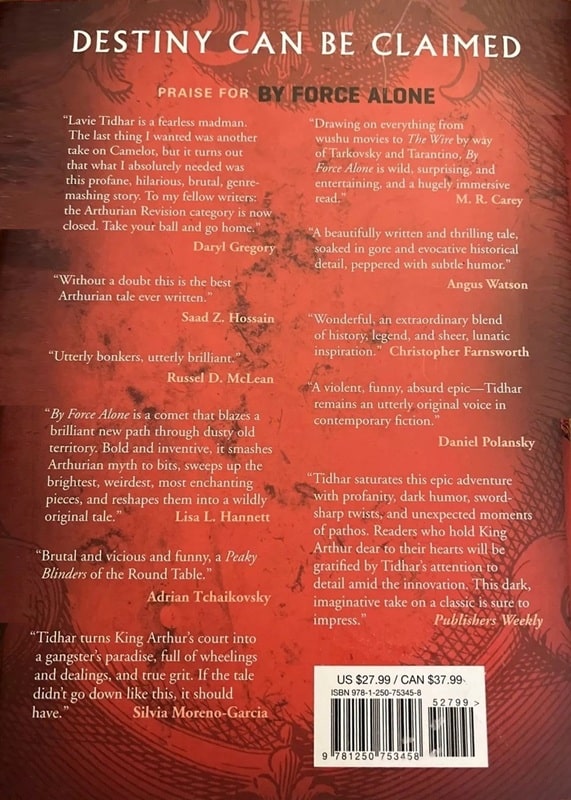
By Force Alone by Lavie Tidhar (Tor Books, August 11, 2020)
Particularly noteworthy is that Guinevere is no mere cardboard supporting character, but more independent woman with agency of her own. This more modern depiction of women in the Arthurian legend is especially associated with Marion Bradley Zimmer’s The Mists of Avalon retelling from the perspective of Morgaine, who rather than as a one-dimensional evil sorceress is depicted as a sympathetic complex woman during the transition in Britain from paganism to Christianity. Published in the early 1980s and the rise of feminist voices not only in fantasy literature (though, ironically, some critics detect anti-feminist themes in Zimmer’s work, and allegations of sexual abuse by her daughter don’t help) but the larger zeitgeist, more female-centric retellings of the Arthurian legend followed, such as, most recently, Nicola Griffith’ s Spear and Half Sick of Shadows by Laura Sebastian, as just two examples.
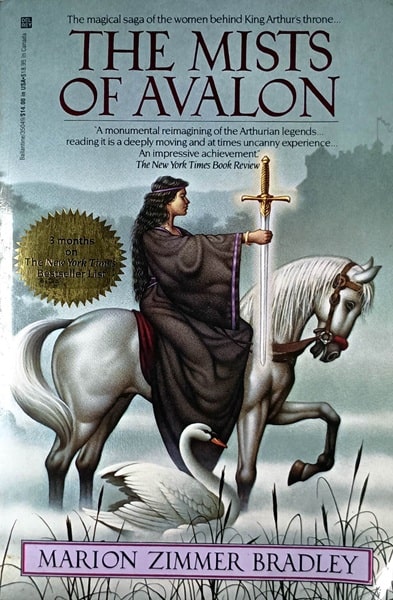
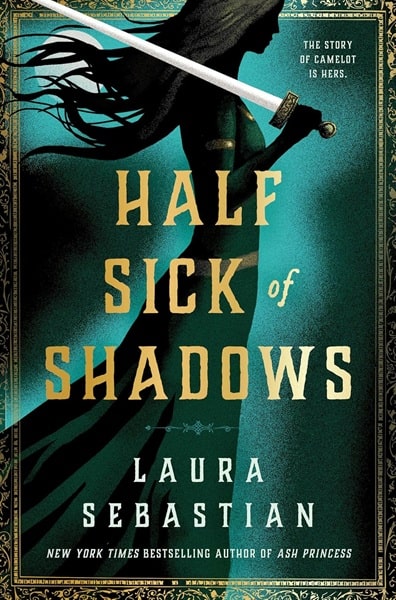
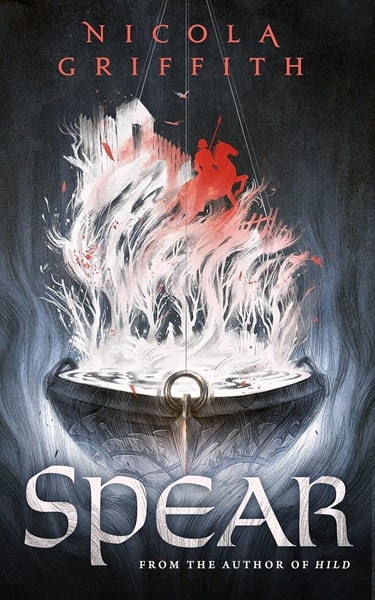
The Mists of Avalon by Marion Zimmer Bradley (Del Rey, May 1984), Half Sick of Shadows
by Laura Sebastian (Ace Books, July 6, 2021), and Spear by Nicola Griffith (Tor, April 9,
2022). Covers by Braldt Bralds, uncredited, and Rovina Cai
So the legend of Arthur has been retold down through the centuries and even with multiple variations and exegesis, we still have the basic uber narrative of a brief realization of an ideal doomed by historical, religious, and insidious forces to failure. Is there still room for yet another appraisal that just doesn’t rehash the same old same old?
Apparently so. To the extent of 670 pages in Lev Grossman’s The Bright Sword. That’s a lot of Camelot.
I confess that if I hadn’t previously read The Magician’s Trilogy (which perhaps explains why the cover prominently features reference to it, leading some online cataloguers to incorrectly attribute The Bright Sword as part of that series), I might not have picked this up (as a nearly 700 page book makes it hard to do).
Indeed, Grossman himself notes:
I spent most of my life blissfully uninterested in writing anything at all about King Arthur…His story has already been told thousands of time, from every possible point of view… Arthur is also, as it happens, white, middle-aged, heterosexual, and cis-gendered, a point of view that is hardly lacking in contemporary literature.
But by focusing on how the peripheral characters of the Round Table come to grips with a new era following Arthur’s death (or at least his transport to Avalon following his mortal wounding), Grossman comes up with a new and fresh angle.
Collum is a gifted knight wannabe (the one character that Grossman makes up) escaping an abusive home whose first kill (and pivotal plot point) is a recalcitrant knight with successful suicidal tendencies. This occurs as Collum is on his way to fight for a seat at (unbeknownst to him) what’s left of the Round Table band (which isn’t much) following King Arthur’s mortal wounding by his bastard (and product of incest with his sister Morgause, something the juvenile versions of Arthur kind of gloss over) son Mordred at the Battle of Camlaan. Featured surviving bit players include Sir Bedivere, whose devotion to Arthur hides unfulfilled carnal desire, Sir Palomides, a Middle Eastern pagan convert and hunter of the Questing Beast whose particular unrequited love is Iseult of Wagner’s Tristan and Isolde fame, Tristan’s close friend Sir Dinadian, and Sir Dagonet, Camelot’s court jester who is better at joking than jousting.
Don’t worry, Lancelot and Guinevere and the rest of the main cast make cameo appearances, but not as you might expect them. The narrative focuses primarily on the minor characters as they attempt to restore (as you might expect, not successfully) the glory of Arthur’s reign and intentions, with sidesteps into their backstories. As for Arthur himself, well, we already know it doesn’t end well. But it still inspires. As Grossman notes:
King Arthur’s life can only ever end one way, his doom is always waiting for him…of course even after his death Arthur himself is never quite gone. He’s been with us for 1,400 years and counting now and shows no signs of going away. Like Godot he’s always coming, but always tomorrow, never today. He waits, asleep in Avalon, the Fortunate Isle. or under Mount Etna in Sicily, as some other stories have it, dreaming eternally of his homecoming. We dream of it too.
David Soyka is one of the founding bloggers at Black Gate. He’s written over 200 articles for us since 2008. His most recent was a review of State of Paradise by Laura Van Den Berg.








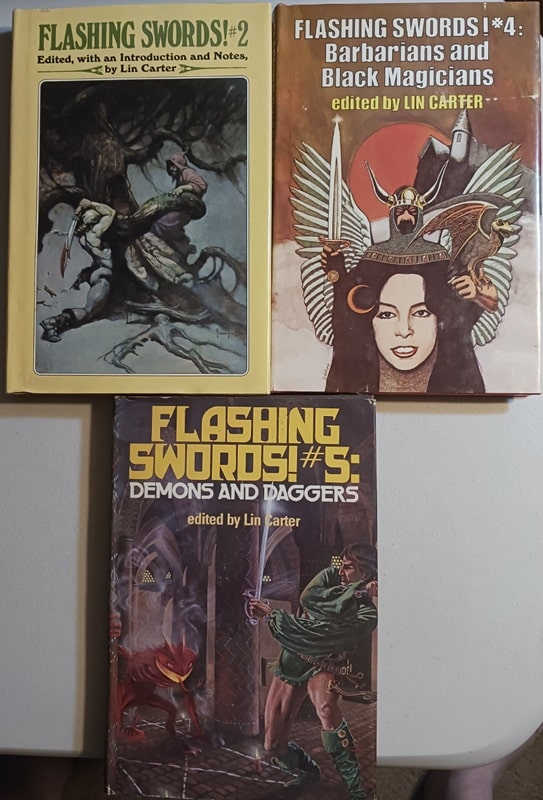
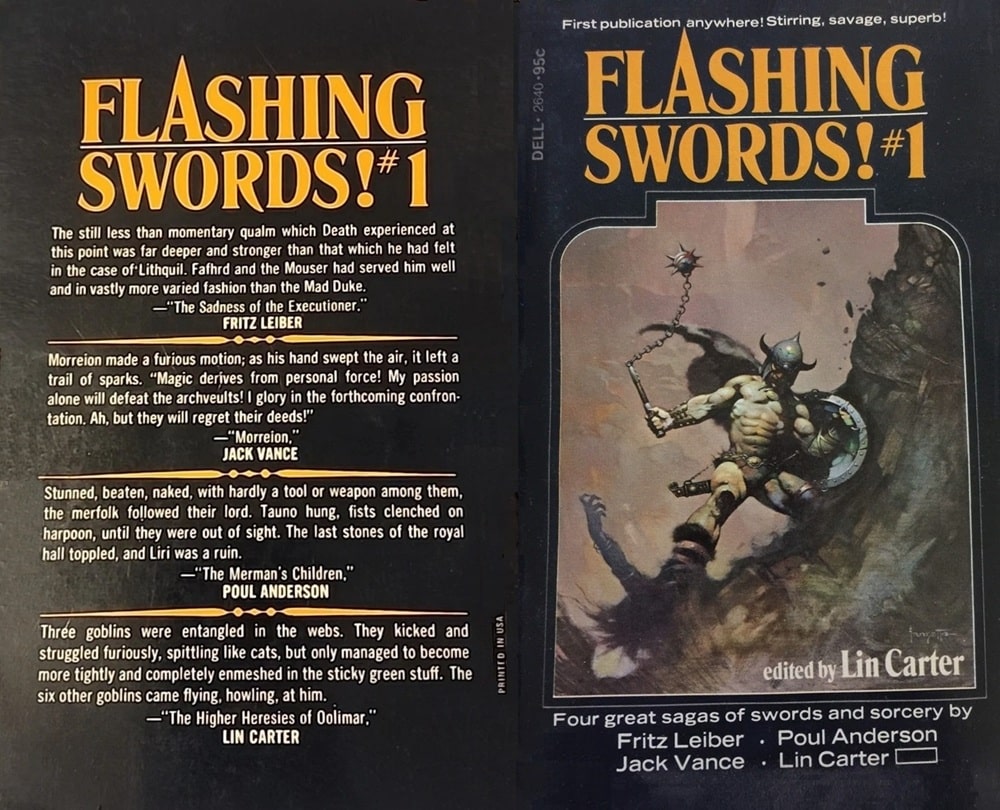
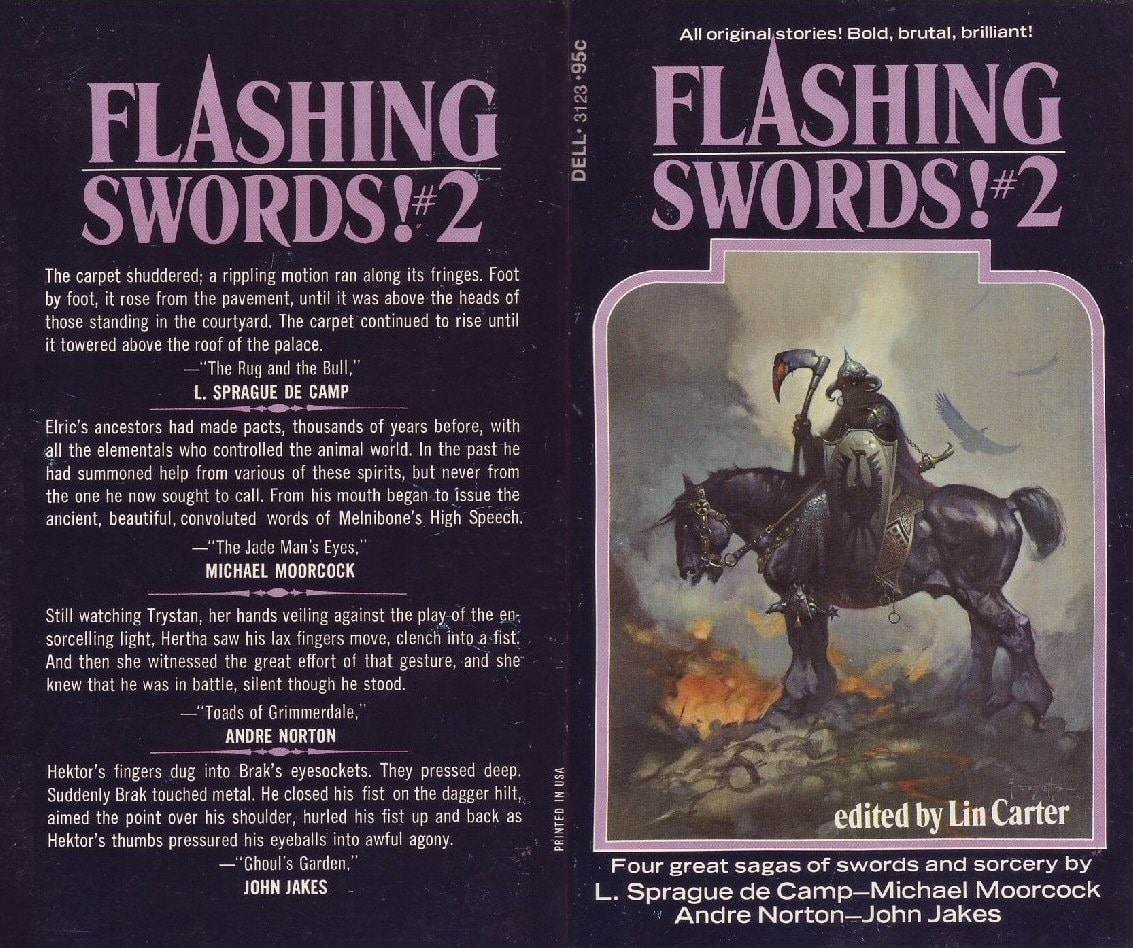
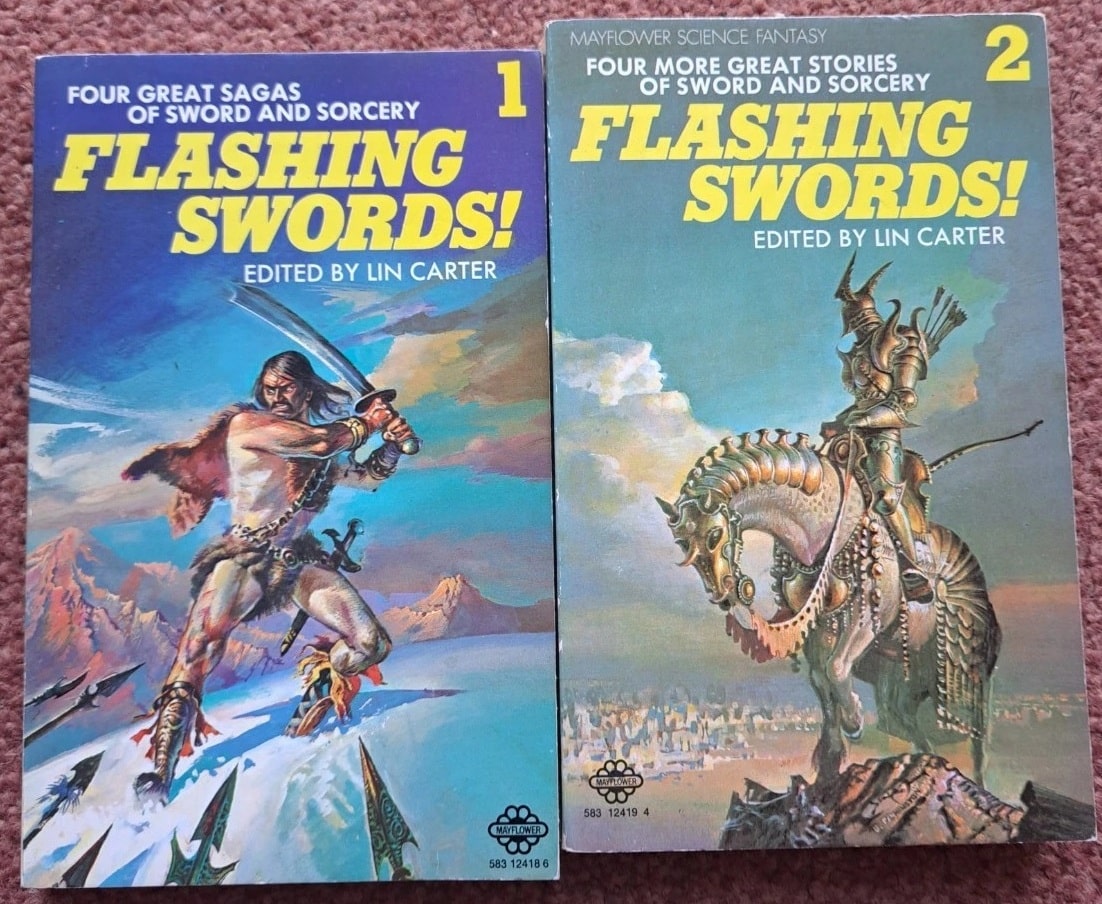
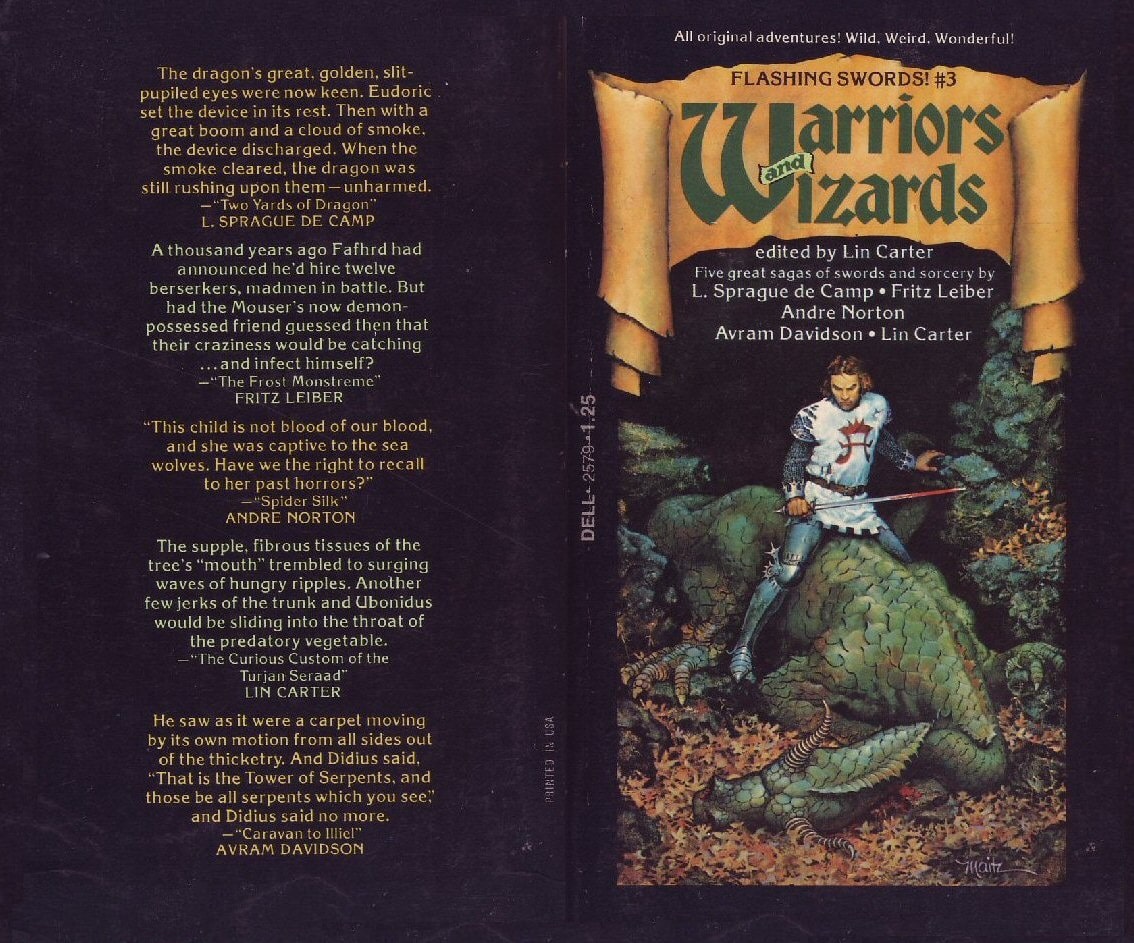
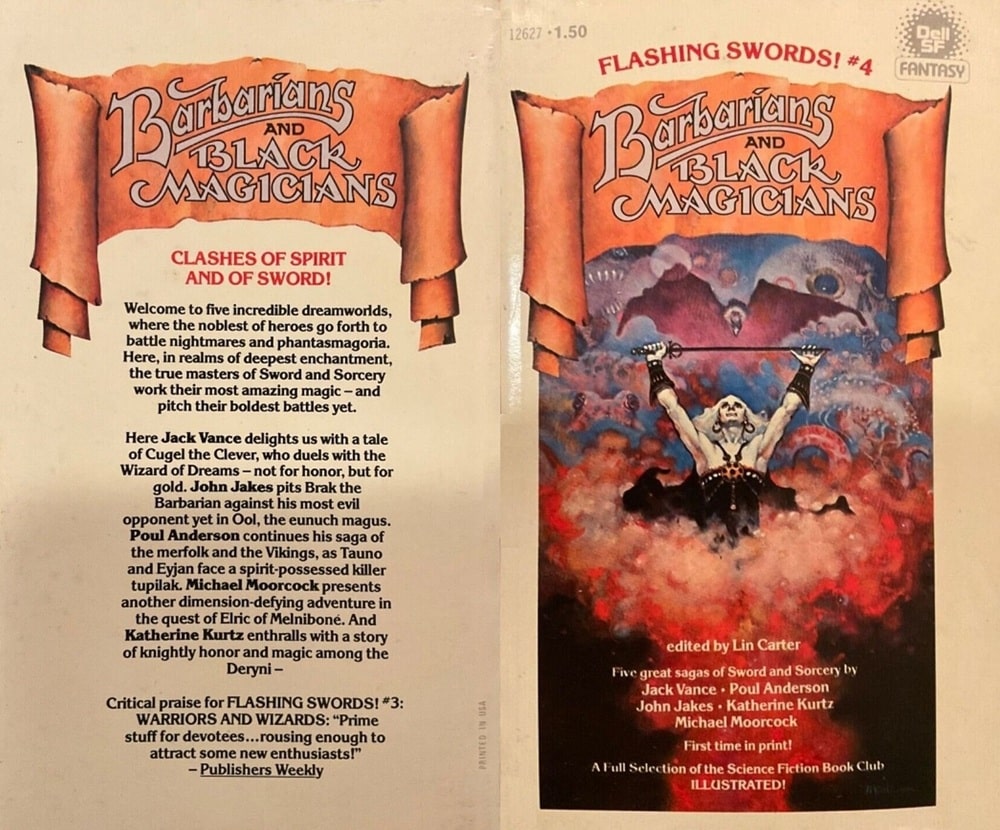
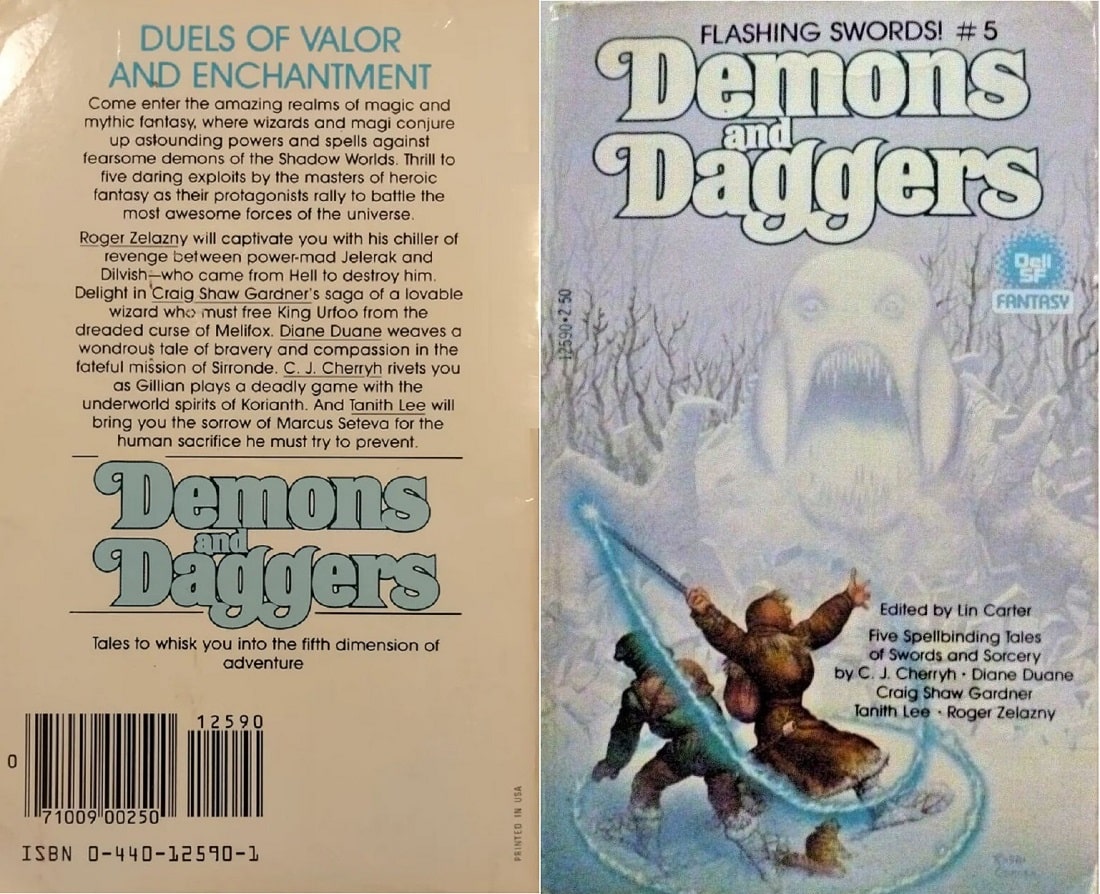



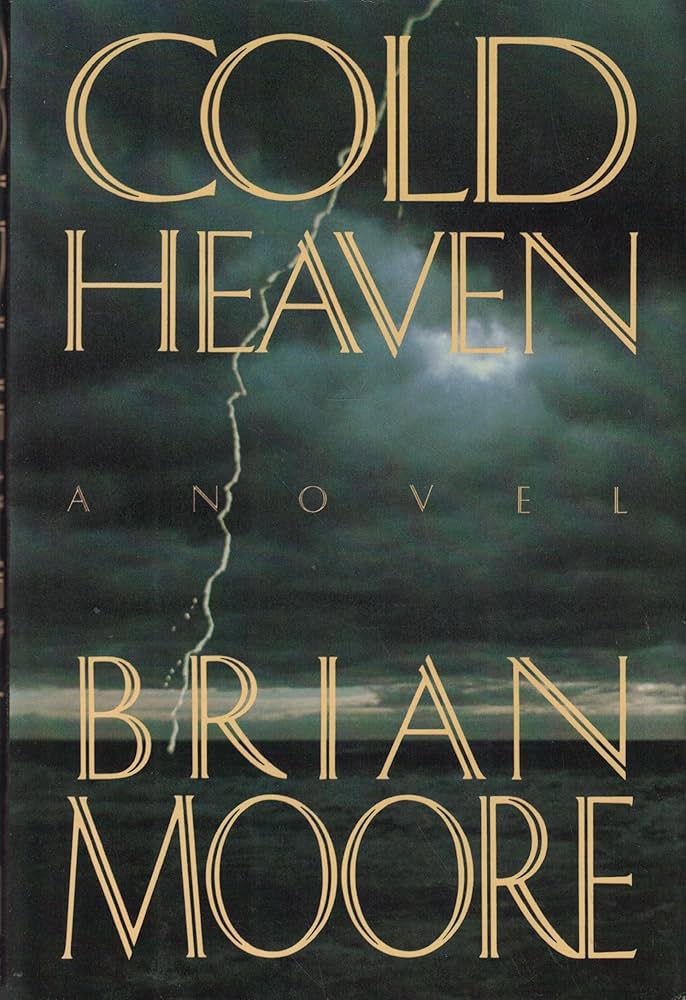

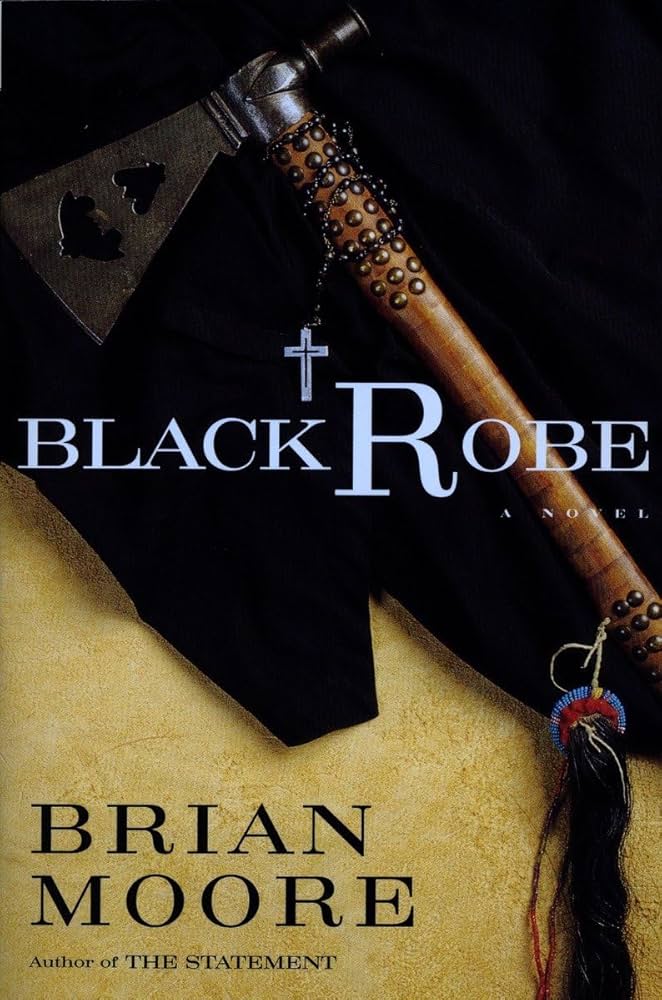
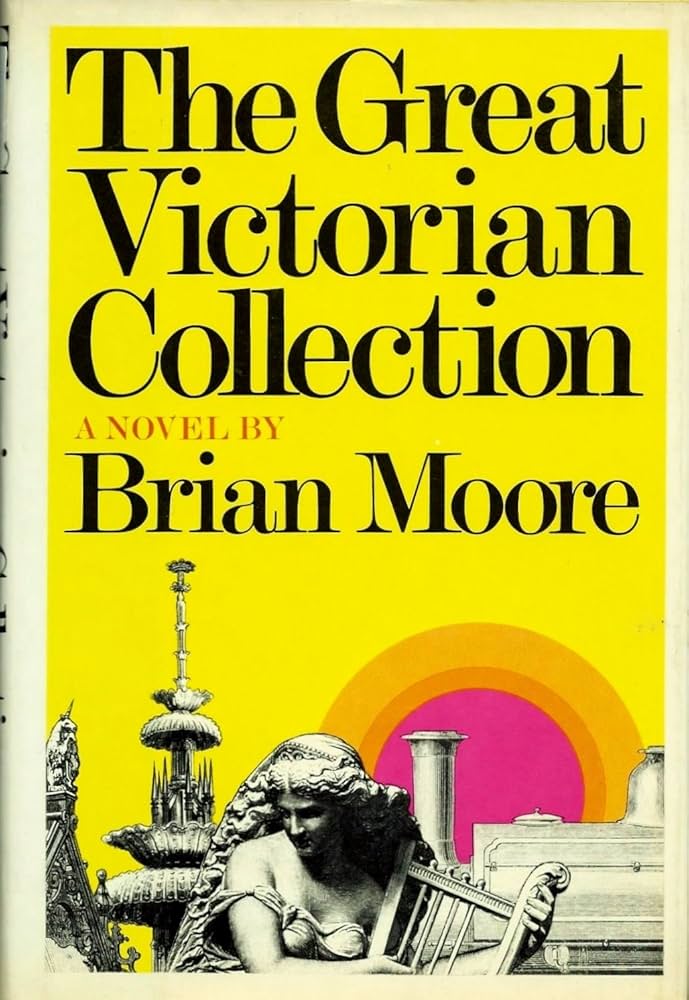

Recent comments